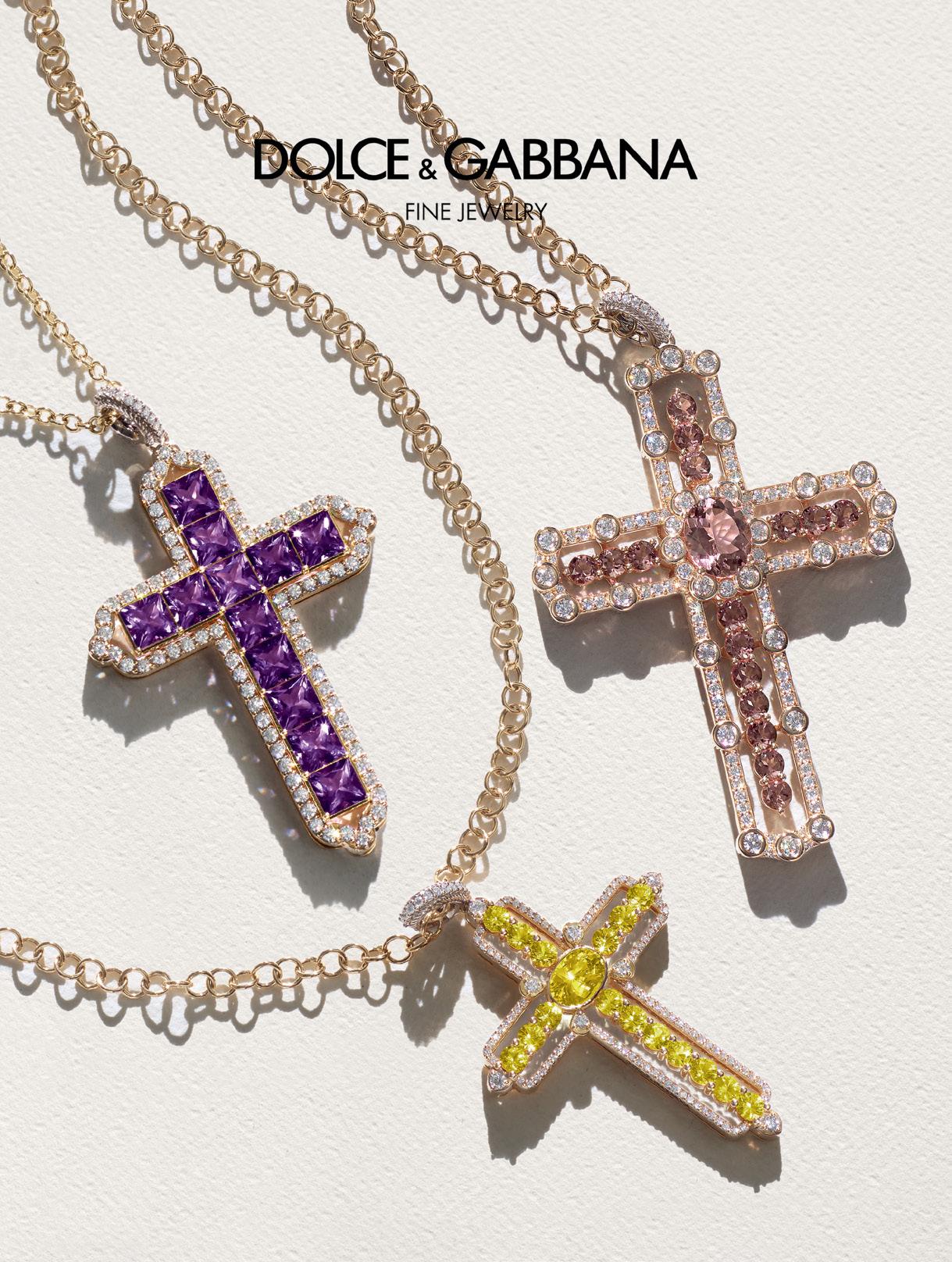


 Matilde Gioli, Milano
Matilde Gioli, Milano







 Matilde Gioli, Milano
Matilde Gioli, Milano



Circola in rete un popolare meme che correda l’immagine di una tela “tagliata” da Lucio Fontana con l’ammonimento scherzoso “No, non avresti potuto farlo tu!”. In arte come nella gioielleria, nella moda, nel design, certi risultati apparentemente semplici sono in realtà frutto di elaborazioni complicatissime, di tecniche che richiedono anni di esperienza, e di una cultura del tutto fuori del comune. Sono i colori, le proporzioni, gli equilibri, le citazioni colte e i dettagli a “fare la differenza”, a rendere subito riconoscibili i capolavori delle grandi maison o degli atelier indipendenti - e le creazioni destinate a diventare tali. In tutto il mondo, per chi ha uno sguardo curioso aperto al proprio presente, il passato e la tradizione sanno essere fonte di ispirazione per valori e contenuti sempre nuovi, che non hanno nulla a che vedere col rimpianto o la passiva riproduzione. Opere straordinarie di design - gioielli, quadri, arredi, abiti, architetture - ci parlano quotidianamente nel linguaggio universale della bellezza e ci aiutano a districarci nella complessità del nostro tempo.
A popular meme is circulating online that accompanies an image of a canvas“cut”by Lucio Fontana with the playful admonition“No,you couldn’t have done that!”With art like with jewelry,with fashion,with design, certain seemingly simple results are actually the result of very complicated processes,techniques that require years of experience,and of a culture that is quite out of the ordinary.It is the colors,proportions, balances,learned quotations and details that“make the difference,”that make the masterpieces of the great maisons or independent ateliers,and the creations destined to become such,immediately recognizable. All over the world,for those with a curious gaze open to their present,the past and tradition know how to be a source of inspiration for ever-new values and content that have nothing to do with regret or passive reproduction.Extraordinary works of design (jewelry,paintings,furniture,clothing,architecture) speak to us daily in the universal language of beauty and help us disentangle ourselves from the complexity of our time.

Issue 08
EDITOR-IN-CHIEF
Vincenzo Carbone
EDITORIAL DIRECTOR
Domenico Festa
domenico.festa@huesersmagazine.com
EDITORIAL COORDINATOR
Antonella Garello
antonella.garello@huesersmagazine.com
ART DIRECTOR
Fabrizio Majerna
CONTRIBUTORS
Salvador Asensio, Silvia Badalotti, Paola Bertelli, Claudia Carletti, Rosa Chiesa, Alberto Corrado, Elisa Facchetti, Paola Greco, Davide Passoni, Michele Romano, Donatella Zappieri
NAVA COMUNICAZIONE
Via Lattanzio, 15 - 20137 Milano - Italy
CONTACTS
editorialstaff@huesersmagazine.com

HUESERS IS PUBLISHED BY
PRODES ITALIA SRL
Via Sansovino, 6 - 20133 Milano - Italy +39 02.36580208 info@huesersmagazine.com
ADVERTISING
adv@huesersmagazine.com Italy
Barbara Pedone barbara@prodesitalia.com - +39 3286345142
Other Countries
Cherine Zoia cherine@prodesitalia.com - +39 3519179356
PRINTED BY Denona doo Getaldićeva 1 - 10 000 Zagreb - Croatia

Nuit de L’Inderdit
& Mercier
Nesper
of Tuhina







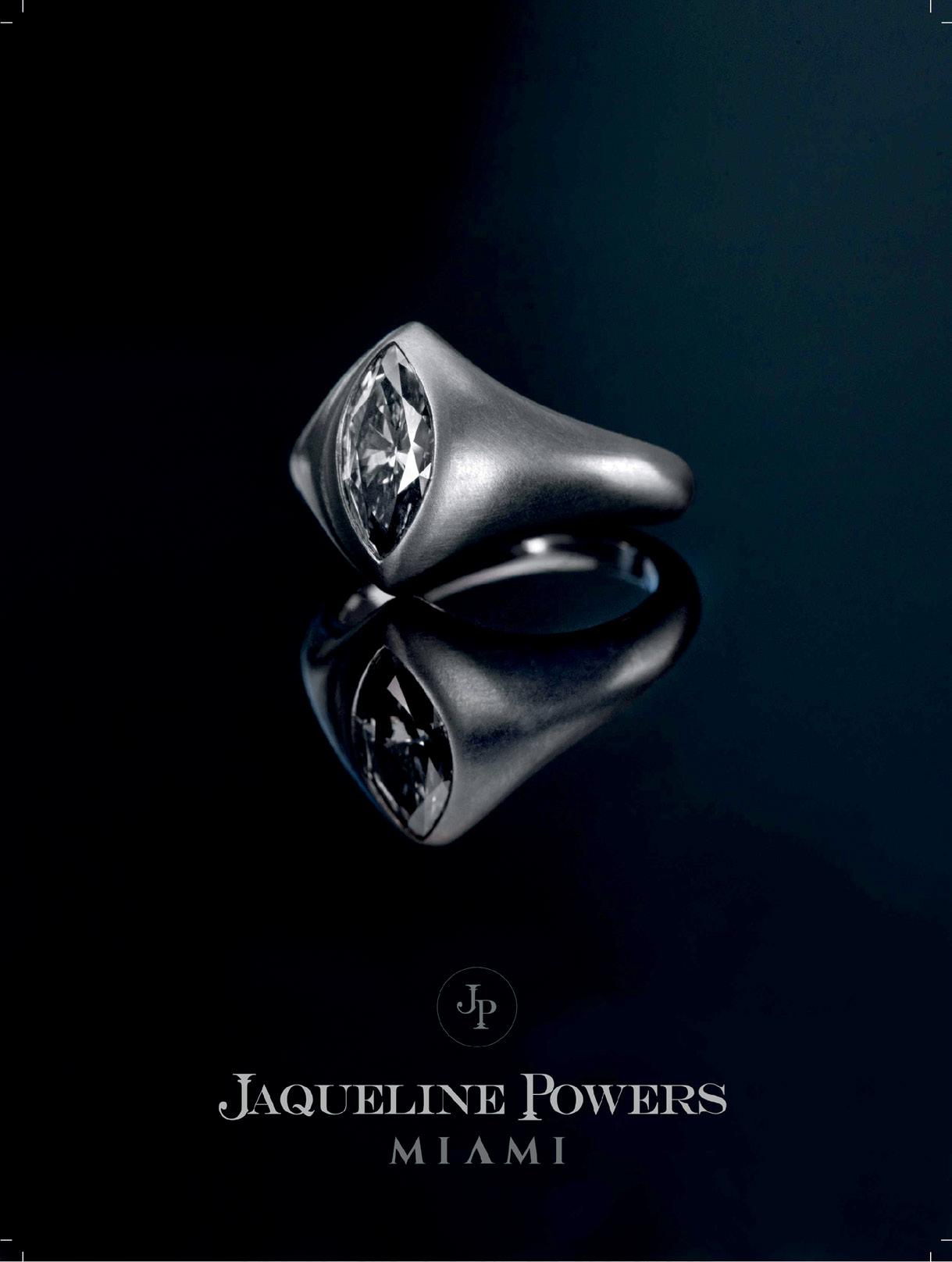

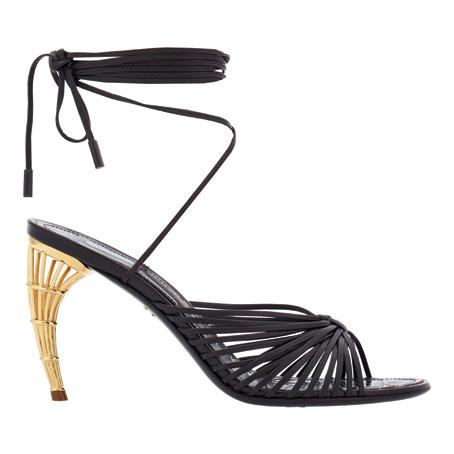
Ancora un altro modo di essere. Rigore e ardore. Ingegno e concretezza. Decisione e purezza. E sopra ogni cosa, l’atto intuitivo. Gli ingredienti sono questi. Cioè, è uno solo: quello dell’idea coerente dell’eleganza, che sia per la prossima primavera-estate o che sia per il prossimo autunno inverno, cosparge lo stile Ferragamo di quella estetica distintiva, che si tramuta in una visione fluida e organica, fondata su un dialogo continuo tra equilibrio e tensione. Sofisticata, coinvolgente, insinuante ma levigata. Così lavorata da apparire tattile. Le collezioni della Maison Ferragamo puntano su quel sentimento di familiarità, che si riconosce nel modo di vestire e di vivere italiano. «Ho voluto che ogni elemento sembrasse molto più leggero, non solo per i tessuti, anche per le linee grafiche e i profili geometrici degli accessori». Lui, Maximilian Davis, direttore creativo di Ferragamo dal marzo del 2022, il perfezionista eterno, il responsabile della regia di quella via intelligente alla contemporaneità, che ormai abita le nostre coscienze come i nostri desideri, racconta il mood del momento scegliendo una a una le immagini di eleganza dove tutto è forma, creatività e special technique
Ricorrendo alla maestria degli Atelier di Ferragamo per garantire comfort e praticità e all’heritage del marchio, impreziosisce le collezioni attraverso dettagli, che talvolta diventano tridimensionali, anche attraverso l’uso innovativo di tecniche artigianali classiche, reinventate con il lessico della contemporaneità. Quelle che si possono realizzare solo in Italia. Anche in questo senso, ancora il meglio di quel Made in Italy amato da tutti i compratori del mondo. Rivisitato, anche, attraverso una tavolozza dai toni tranquilli ma dall’effetto brillante. Il risultato, come è tradizione della Maison Ferragamo, vuole unire essenza discreta, sensualità, senso dell’artigianalità e innovazione. Giocando tutto sulle sfumature e sulle nuance inattese.
Così sono le collezioni proposte per quest’anno, rivisitazione della femminilità e della mascolinità fragrante, forse una rivincita sulla durezza dei tempi, dove Ferragamo ci immerge nel piacere della leggerezza, nelle divagazioni intelligenti di “special technique”, che altro non sono che invenzioni artigianali impalpabili e perfette di Salvatore Ferragamo. Quasi un allenamento, per Maximilian Davis, ma anche per noi, per non smettere di fantasticare, continuando a guardare oltre.
E allora sfilano silhouette dalle linee impeccabili, che rappresentano quella interazione sovversiva tra compostezza e libertà, che si percepisce in entrambe le collezioni. È qui che si riscopre l’effetto dei dettagli scultorei nel creare capi puri, sinceri, onesti, con
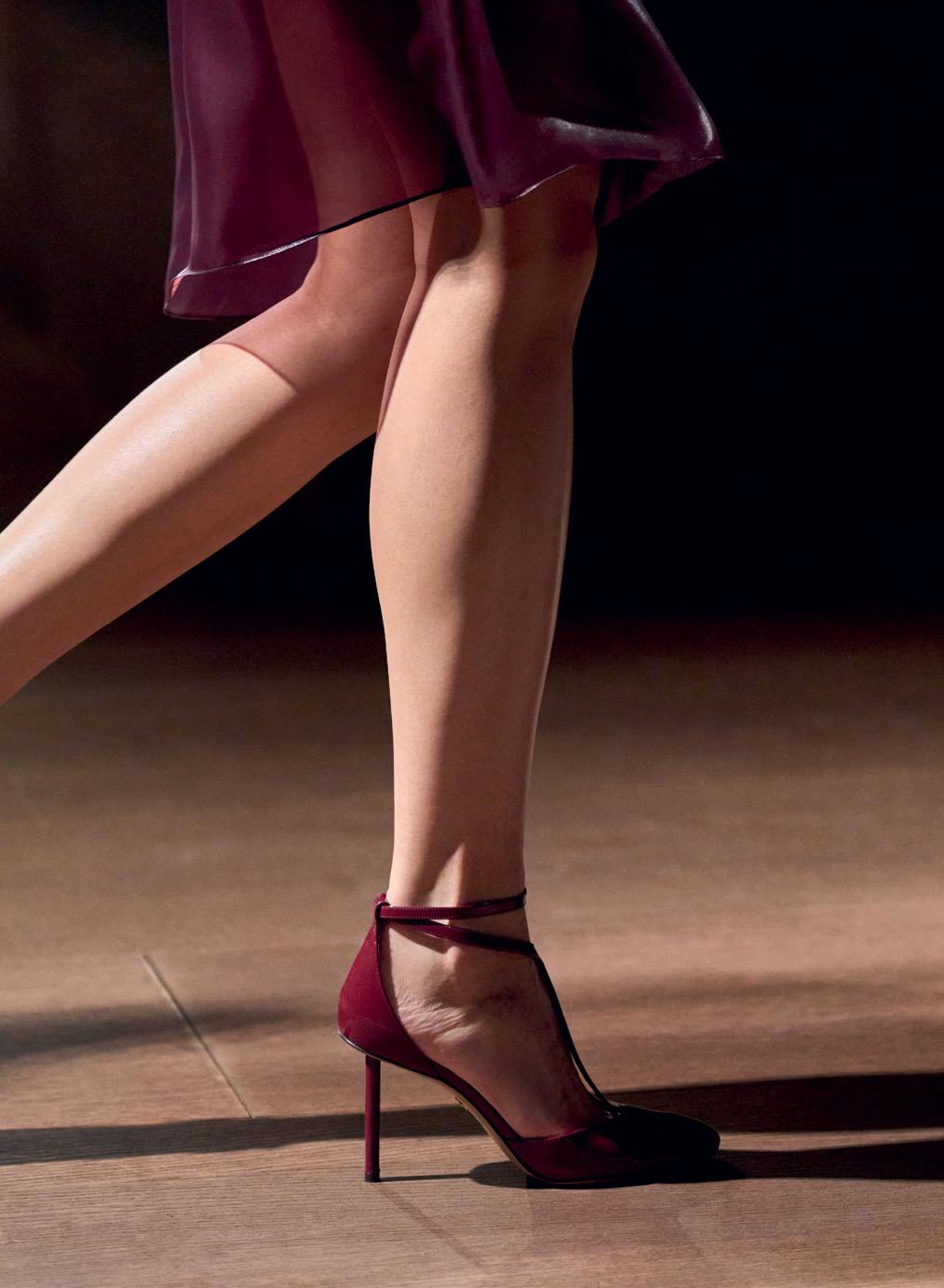

una chiara identità, che li rende riconoscibili, e al tempo stesso affascinanti dal punto di vista tattile.
E soprattutto ricompaiono i rossi. I “suoi rossi” che rappresentano l’eredità di Ferragamo, riconducendo la nostra mente alle più famose scarpe d’archivio, come quella realizzata da Salvatore Ferragamo per Marilyn Monroe negli anni Cinquanta, la famosa décolleté rossa con perline. I rossi che sono luce, senza essere fuoco. Che sono intelligenti ed energici nella loro naturalezza, che sono il filo conduttore delle collezioni SS 2024 e FW 2024-2025, ponendo l’accento su quella rivoluzione pacata fatta da toni fiamma, lacca, geranio. Dove anche i colori soft accostati al crema, al verde, al nero, in diverse sfumature che vanno dal vivo al luminoso, ma mai freddo, diventano una poetica sentimentale moderna. Così, dove tutto comincia promettendo vampate di esuberanza, si ritrova invece quel senso di calda e morbida femminilità o mascolinità della moda pura, come scaturisce dalla testa di Maximilian Davis.
Queste collezioni nascono dal desiderio di rompere senza snaturare lo schema stilistico del marchio, introducendo sì note forti e sensuali, ma sempre in chiave grafica e tattile. Trovando che l’attualità dello stile contemporaneo stia in contrasti anche audaci, ma che portino spontaneità. Ma in questo tripudio di sovrapposizioni, special technique, un ruolo speciale spetta decisamente alle calzature, come nel caso della collezione SS 2024 con il modello d’archivio del 1955, Calipso, con tacco-gabbia a banana stampato in 3D e impreziosito con una finitura oro, o con il tacco curvilineo di un platform, che riappare nella versione in corno come base per un sandalo scintillante o per un modello con cinturino arricchito con perle e pietre naturali. O se desideriamo citare ancora un altro caso nella collezione FW 2024-2025, troviamo la massima espressione artigianale nell’applicazione di 950 paillettes in pelle laminata che sono state applicate a mano per 19 ore nel creare una texture che ricorda le squame di una sirena, collegamento alle nozioni di protezione che Maximilian Davis ha ripescato negli anni’20. Uno stile inaspettato che insegue l’evoluzione. Mentre la sua grammatica del gusto sperimenta altre esclusive declinazioni di glamour.
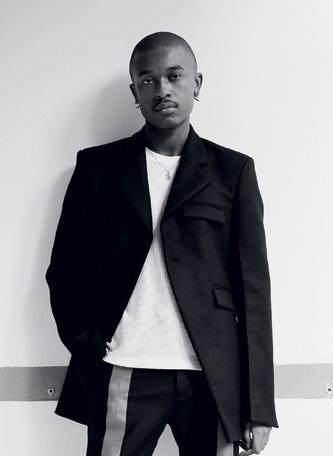
Touches of red,a geometric mood and special details. It is the Maximilian Davis revolution.A common thread for change,starting from accessories
Yet another way of living. Rigor and ardor. Ingenuity and practicality. Decision and purity. And above all else, intuition. These are the ingredients. As a matter of fact, there is only one: the coherent idea of elegance, whether for next spring-summer or next fall-winter, it sprinkles the Ferragamo style with that distinctive aesthetic, which is transformed into a fluid and organic vision, based on continuous dialogue between balance and tension.Sophisticated, engaging, insinuating but polished. So crafted as to appear tactile. Maison Ferragamo’s collections focus on that feeling of familiarity, which is recognized in the way Italians live and dress.
“I wanted every element to feel much lighter, not only in the fabrics, but also in the graphic lines and geometric outlines of the accessories”.He,Maximilian Davis,the creative director at Ferragamo since March 2022,the eternal perfectionist,the person responsible for directing that intelligent path towards modernity, which now inhabits our consciences as well as our desires, tells the mood of the moment by choosing the images of elegance one by one where everything is about form,creativity and special technique.
Drawing on the craftsmanship of Ferragamo’s Ateliers to ensure comfort and practicality, as well as on the brand’s heritage, he embellishes collections through details,which sometimes become three-dimensional, including through the innovative use of classic craft techniques, reinvented with the lexicon of contemporaneity.Those that can only be achieved in Italy. In this sense, again, is the best of that Made in Italy loved by all the world’s buyers.
It is also revisited through a palette of quiet tones with a shine.
The result, as is the tradition of Maison Ferragamo, aims to combine discreet essence, sensuality, a sense of craftsmanship and innovation. Playing it all on shades and unexpected nuances.
This is what the collections proposed for this year are like, a revisitation of femininity and fragrant masculinity,perhapsarevengeontheharshnessofthe times,where Ferragamo immerses us in the pleasure
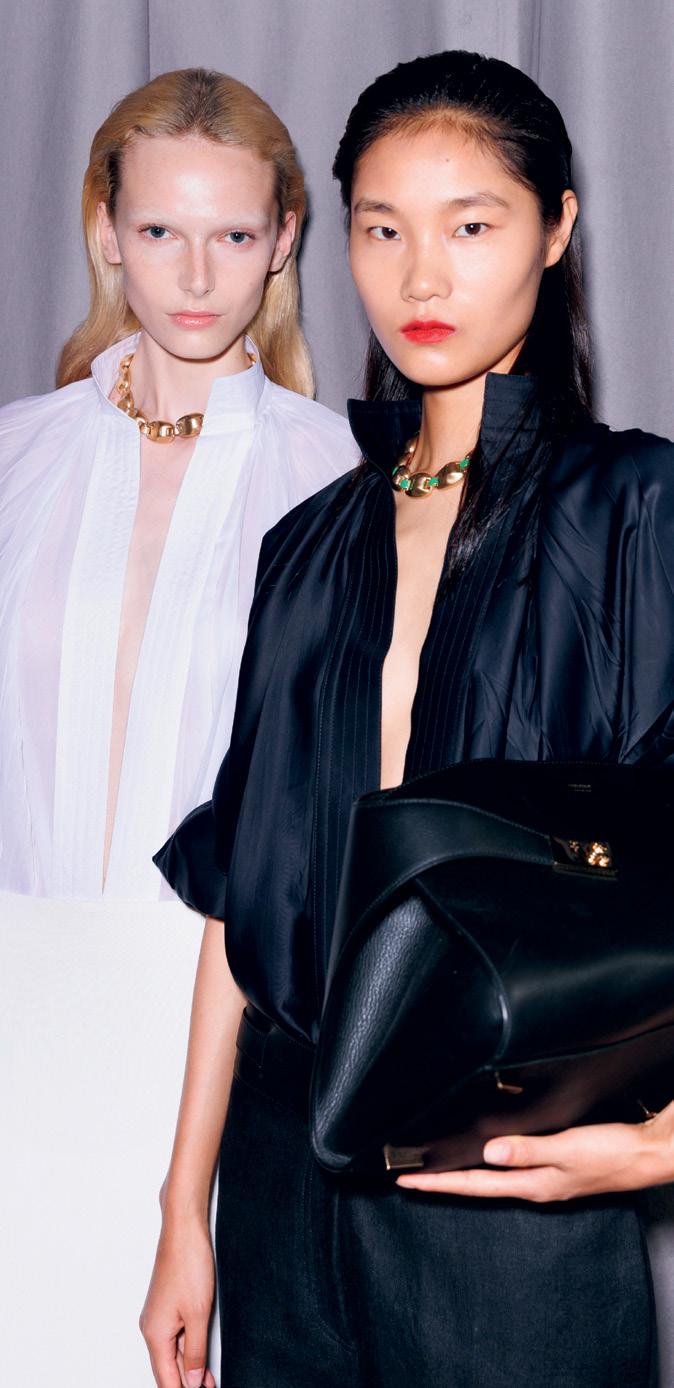

of lightness, in the clever digressions of “special technique”, which are nothing but impalpable and perfect craft inventions of Salvatore Ferragamo. It is almost a workout for Maximilian Davis, and it is for us too: we cannot stop fantasizing,we must continue to look beyond.
And so they parade silhouettes with impeccable lines,representing that subversive interplay between composure and freedom, which can be felt in both collections.
It is here that we rediscover the effect of sculptural detailsincreatingpure,sincere,honestgarmentswith a clear identity,making them recognizable,and at the same time fascinating to the touch.
Most importantly, the reds reappear. “His reds” that represent Ferragamo’s legacy,leading our minds back to the most famous archival shoes, such as the one Salvatore Ferragamo made for Marilyn Monroe in the 1950s, the famous red beaded court shoe. The reds that are light without being fire. That are smart and
energetic in their naturalness,which are the common thread of the SS 2024 and FW 2024-2025 collections, emphasizing that quiet revolution made by flame tones,lacquer,and geranium. Where even soft colors juxtaposed with cream, green, black, in different shades ranging from deep to bright, but never cold, become modern sentimental poetry.
Thus, where it all begins by promising flashes of exuberance,we find instead that sense of warm,soft femininityormasculinityofpurefashion,asitsprings from the head of Maximilian Davis.
These collections stem from a desire to break without distorting the brand’s stylistic pattern, introducing strong and sensual notes,but always in a graphic and tactile way. Finding that the actuality of contemporarystyleliesincontraststhatarealsobold, but bring spontaneity.But in this riot of overlapping, special technique, a special role definitely belongs to footwear, as in the case of the SS 2024 collection with the archival model from 1955, Calipso, with a
3D-printed banana-cage heel embellished with a gold finish,or with the curvilinear heel of a platform, which reappears in the horn version as the basis for a sparkling sandal or for a strappy model embellished with pearls and natural stones. Or if we wish to cite yet another case in the FW 2024-2025 collection, we find the ultimate in craftsmanship in the application of 950 sequins in laminated leather that were handapplied for 19 hours in creating a texture reminiscent of a mermaid’s scales, a link to those notions of protection that Maximilian Davis dredged up in the 1920s. An unexpected style that chases evolution. While his grammar of taste experiments with other exclusive declinations of glamour.

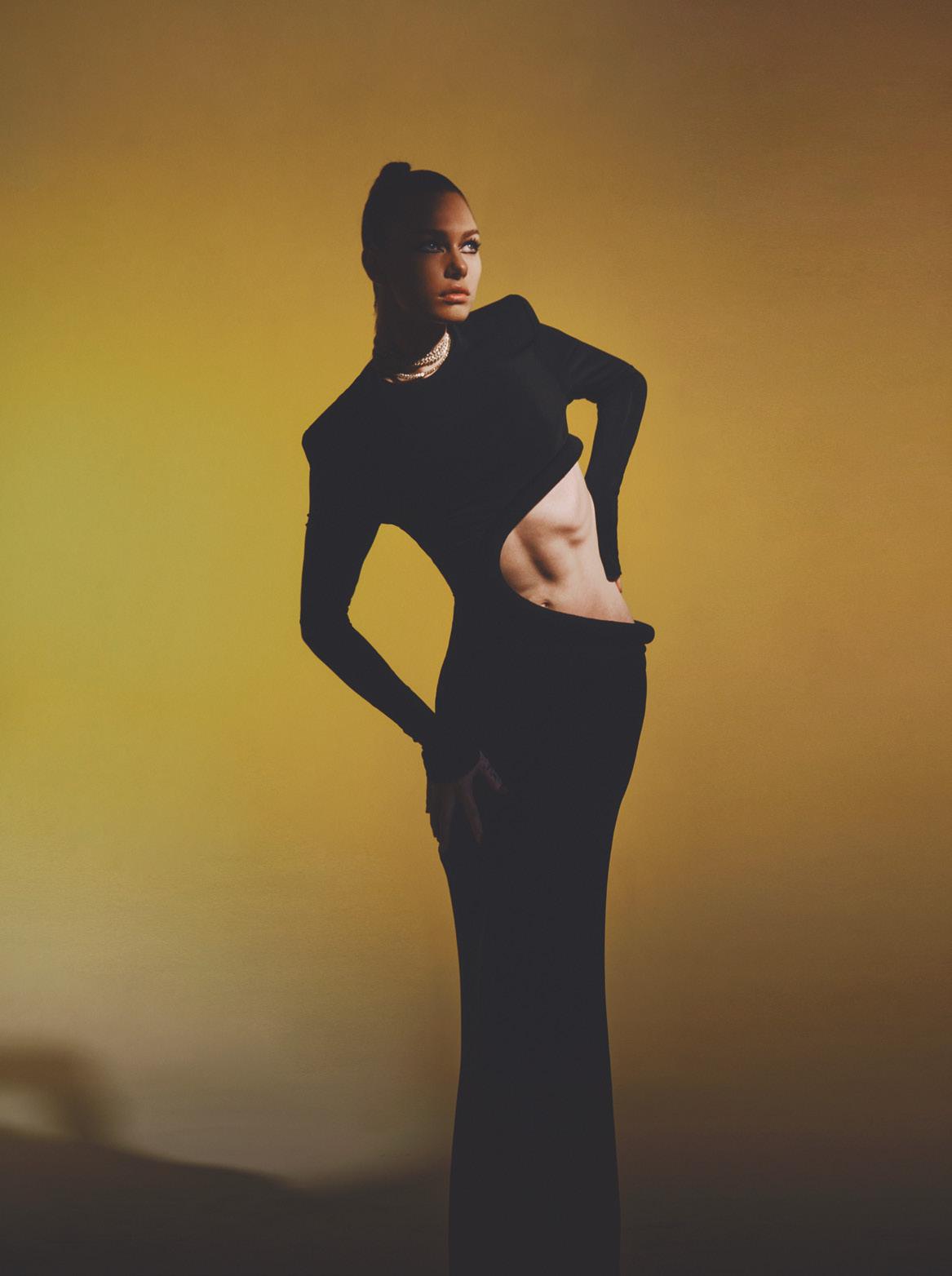


 MISSONI dress | FALCINELLI rings
MISSONI dress | FALCINELLI rings
 PHILOSOPHY DI LORENZO SERAFINI dress and bag | LUCEDEIMIEIOCCHI ring
PHILOSOPHY DI LORENZO SERAFINI dress and bag | LUCEDEIMIEIOCCHI ring




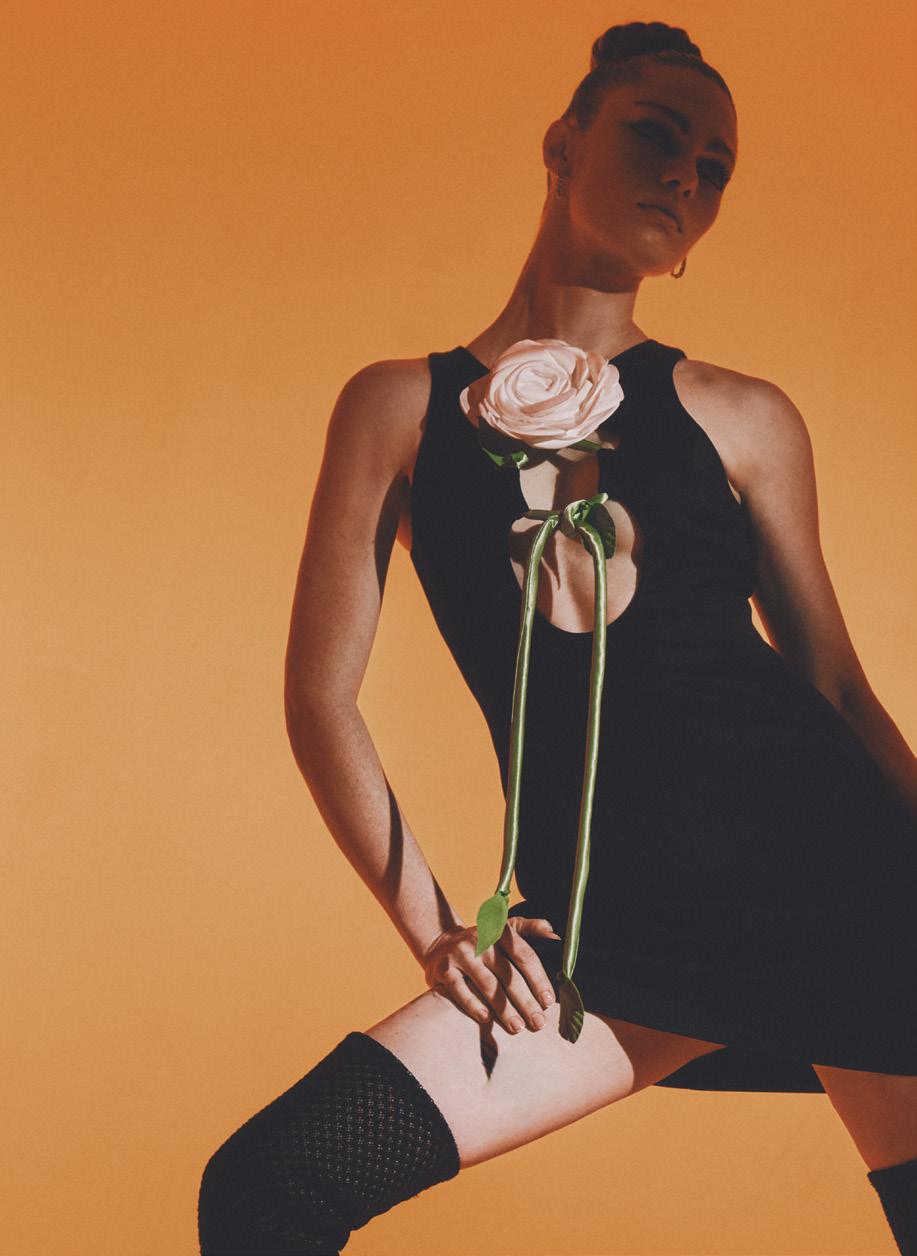 VIVETTA dress | AGL cuissards | FALCINELLI ring | ALESSI DOMENICO earrings
VIVETTA dress | AGL cuissards | FALCINELLI ring | ALESSI DOMENICO earrings
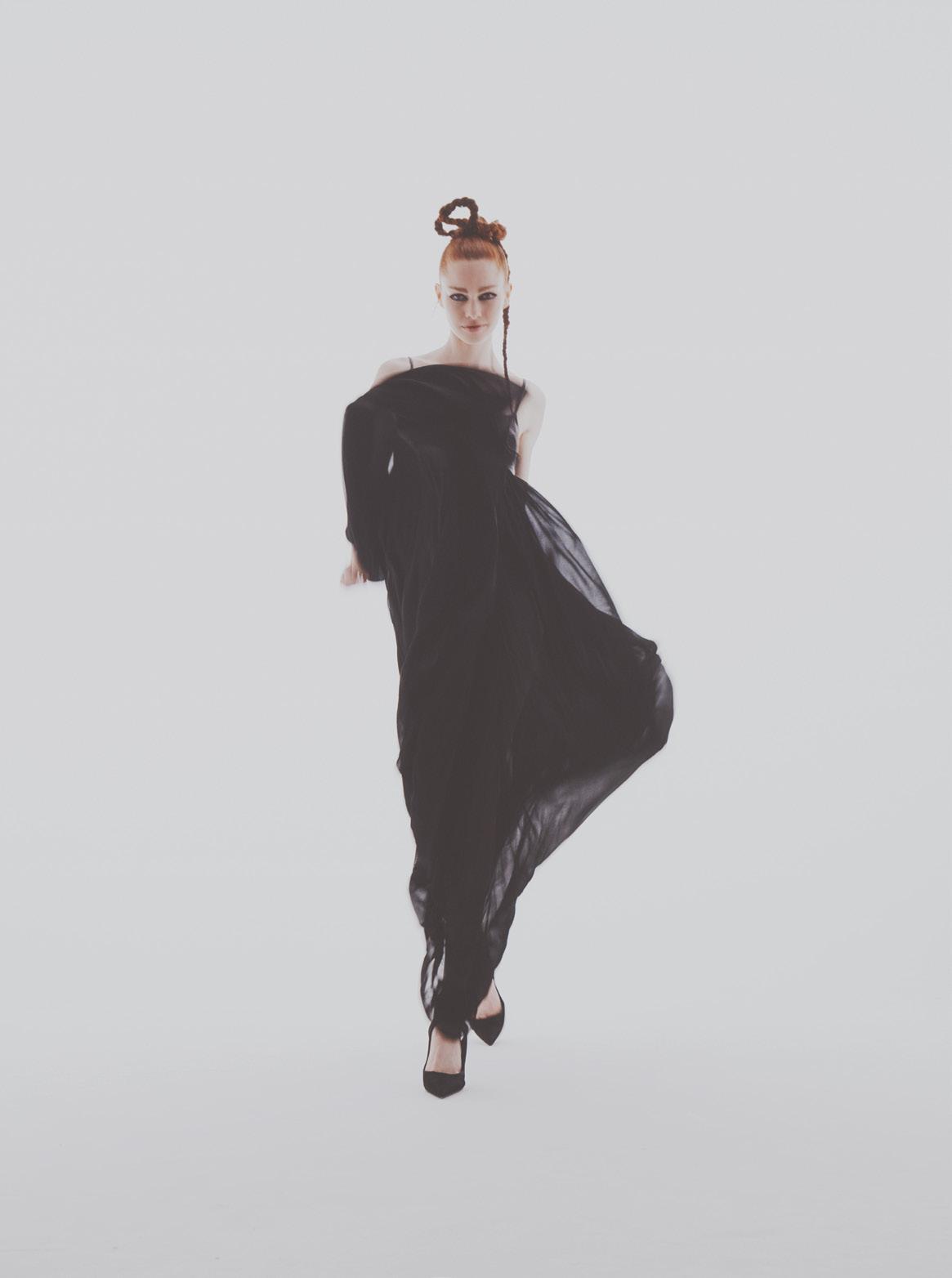 MICHAEL KORS COLLECTION dress | SERGIO ROSSI shoes | MARCO BICEGO bracelet and ring
MICHAEL KORS COLLECTION dress | SERGIO ROSSI shoes | MARCO BICEGO bracelet and ring

 ETRO dress | LUCEDEIMIEIOCCHI earrings
ETRO dress | LUCEDEIMIEIOCCHI earrings


 N°21 dress | GIUSEPPE ZANOTTI shoes | BORBONESE bag | TAVANTI earrings and rings
N°21 dress | GIUSEPPE ZANOTTI shoes | BORBONESE bag | TAVANTI earrings and rings

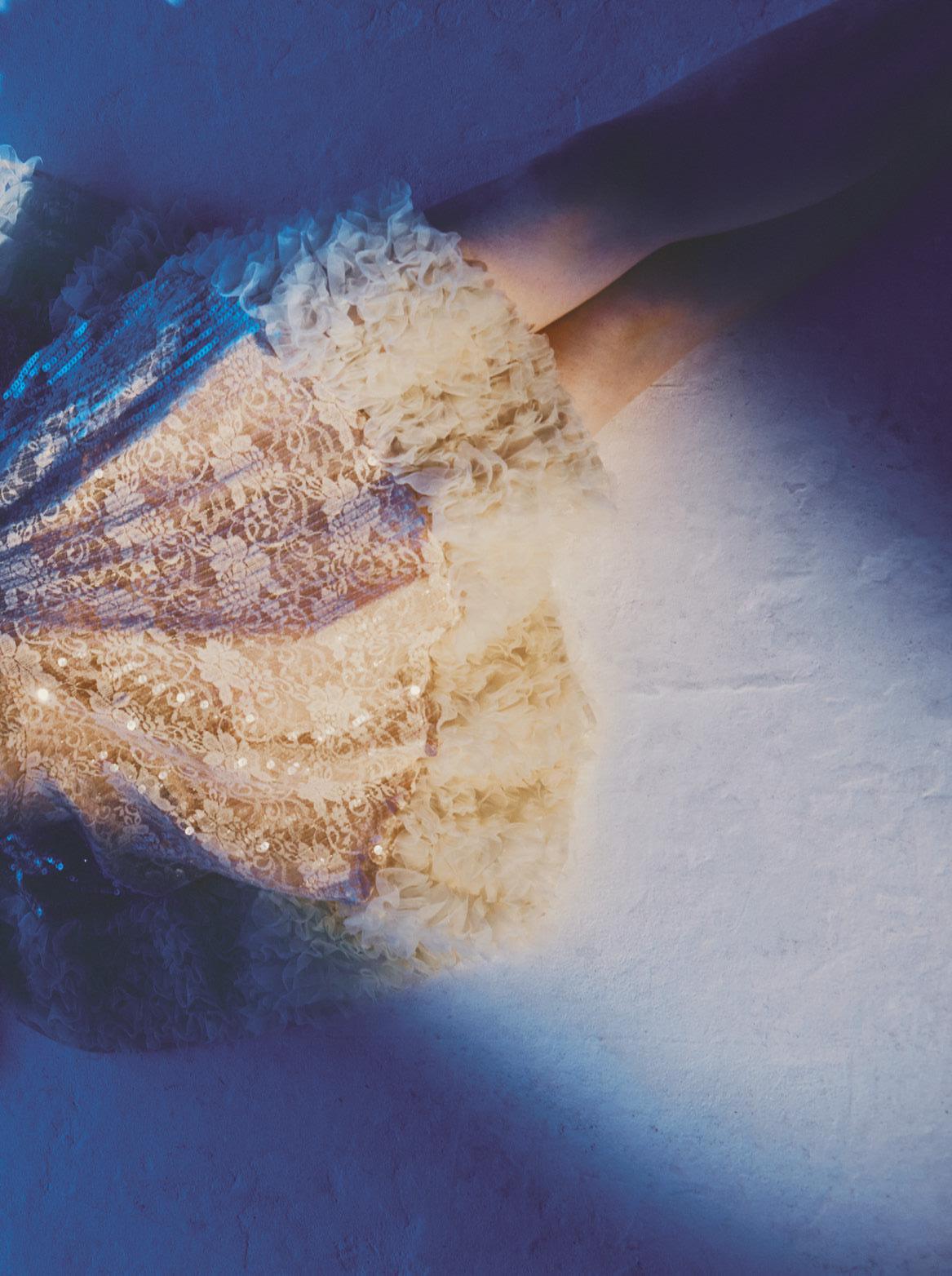
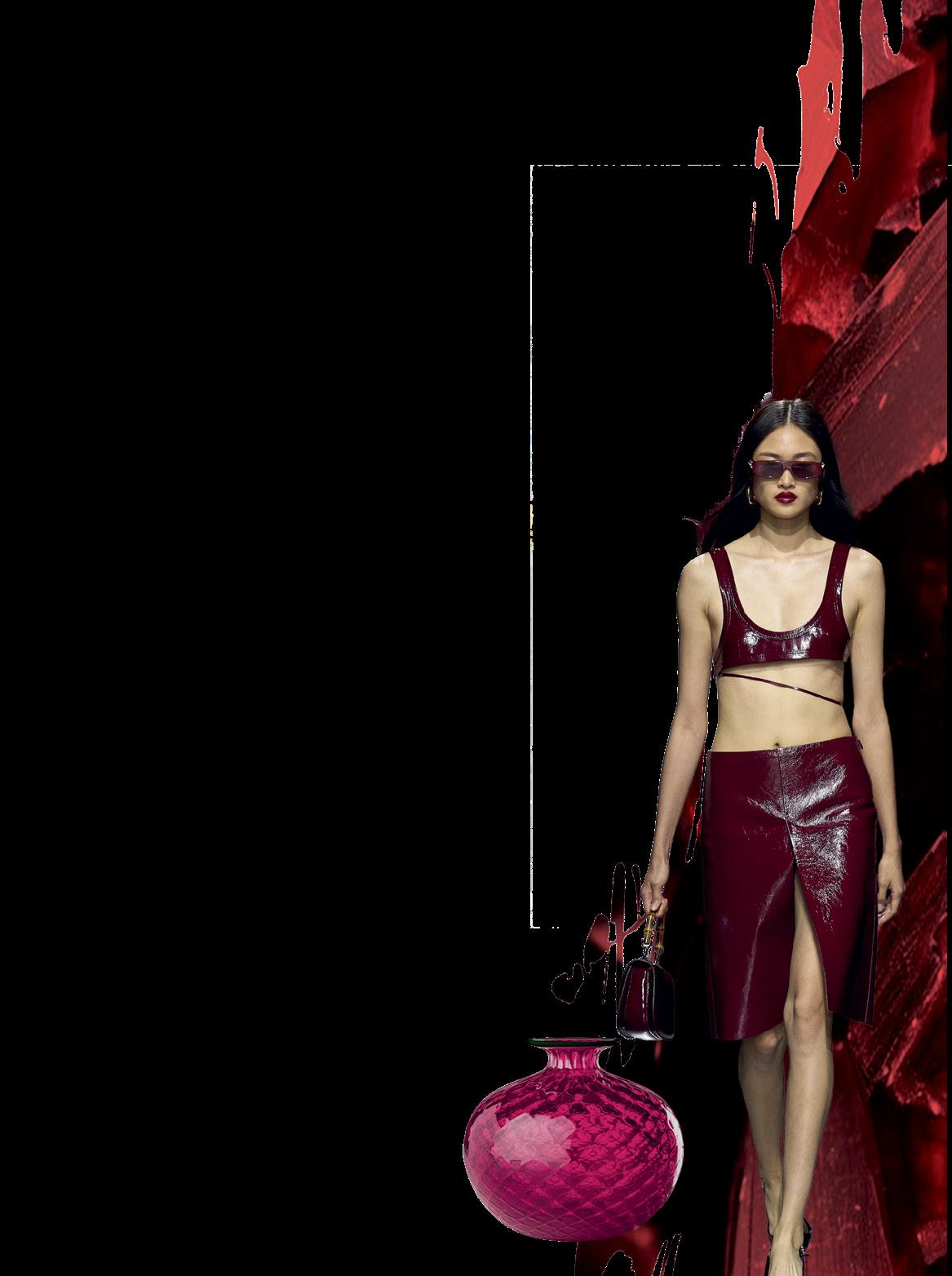
Grande protagonista di questa spring summer è lui, il rosso intenso “Burgundy” per un total look avvolgente, deciso ma soprattutto courageux. Una nuance classica, che vira dal rosso al bordeaux, intensa e capricciosa, si evolve inaspettatamente, esibendo proposte avant-garde che rubano la scena e la rendono protagonista
The big star this spring and summer is him,the deep“Burgundy” red for a fascinating and sharp but,above all,a bold total look.A classic shade that ranges from red to burgundy,deep and moody,it changes unexpectedly,presenting cutting-edge offerings that steal the show and make it the star


Leggero, delicato e romantico.
È con questi tre aggettivi che possiamo definire il “Delicate Green”. Una sfumatura di verde pastello che avvolge dolcemente, la proposta estiva in tutta la sua eleganza. Un big come back destinato a rinfrescare la calda stagione con stile e allure
Light,delicate and romantic.These three adjectives define “Delicate Green”.A shade of pastel green that gently embraces the summer offering in all its elegance.A big come back designed to cool the hot season with style and allure
STELLA MCCARTNEY GINORI 1725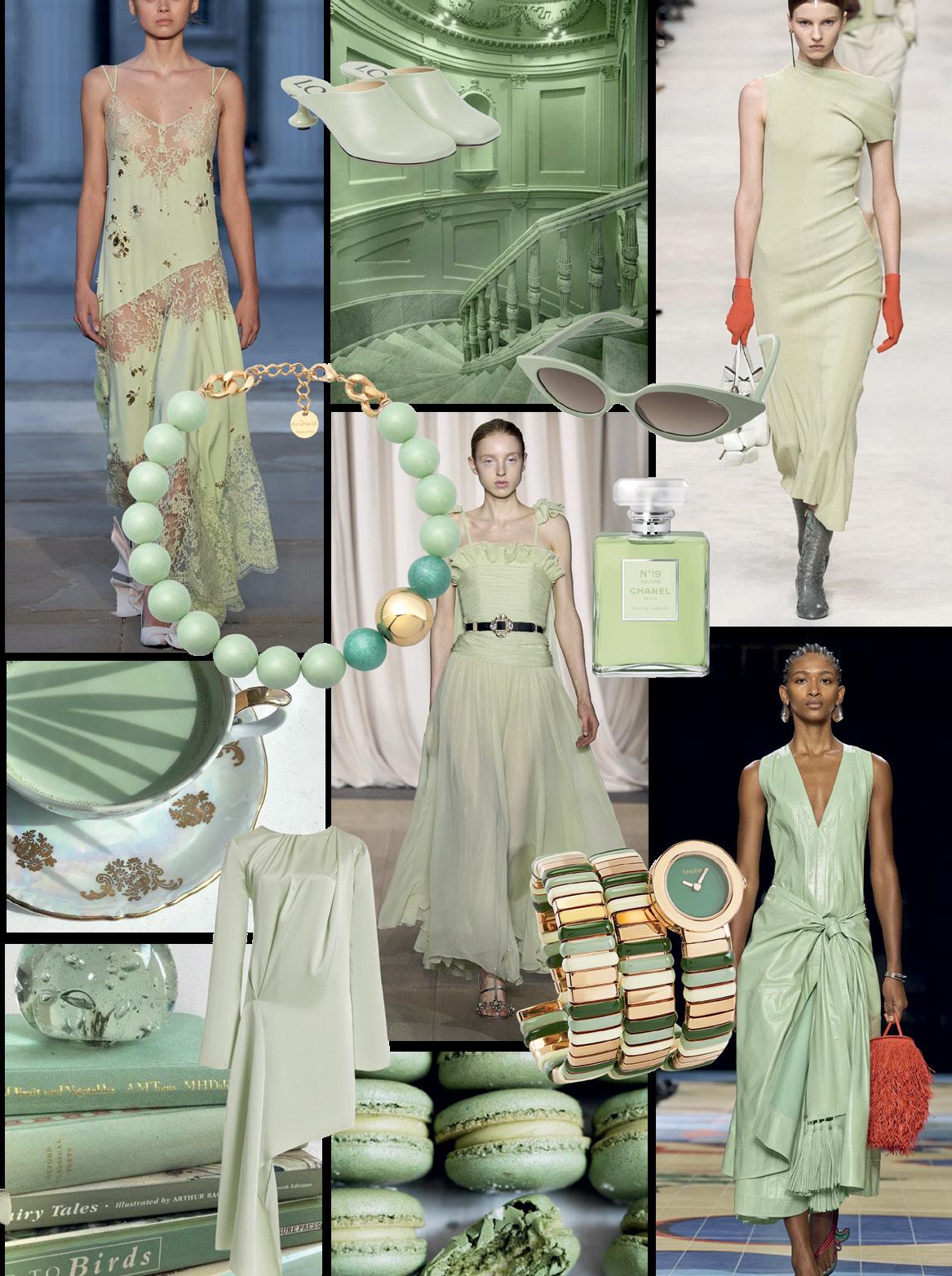

Stile inconfondibile e urbano, per un uomo preppy e sobrio, giocato con una tavolozza tradizionale di un camaïeu di grigi che ricordano le gamme dei minerali del ferro. Un mix and match tra forme minimali e dettagli funzionali, che interpretano fedelmente la formula del less is more, valorizzando le linee pure ed essenziali
An unmistakable and urban style for a preppy and understated man,combining a traditional, monochromatic palette in a range of iron-ore grays. A mix-and-match of minimal shapes and functional details,which faithfully capture the less is more formula by enhancing the pure and simple lines
JIL SANDER CHRISTIAN LOUBOUTIN

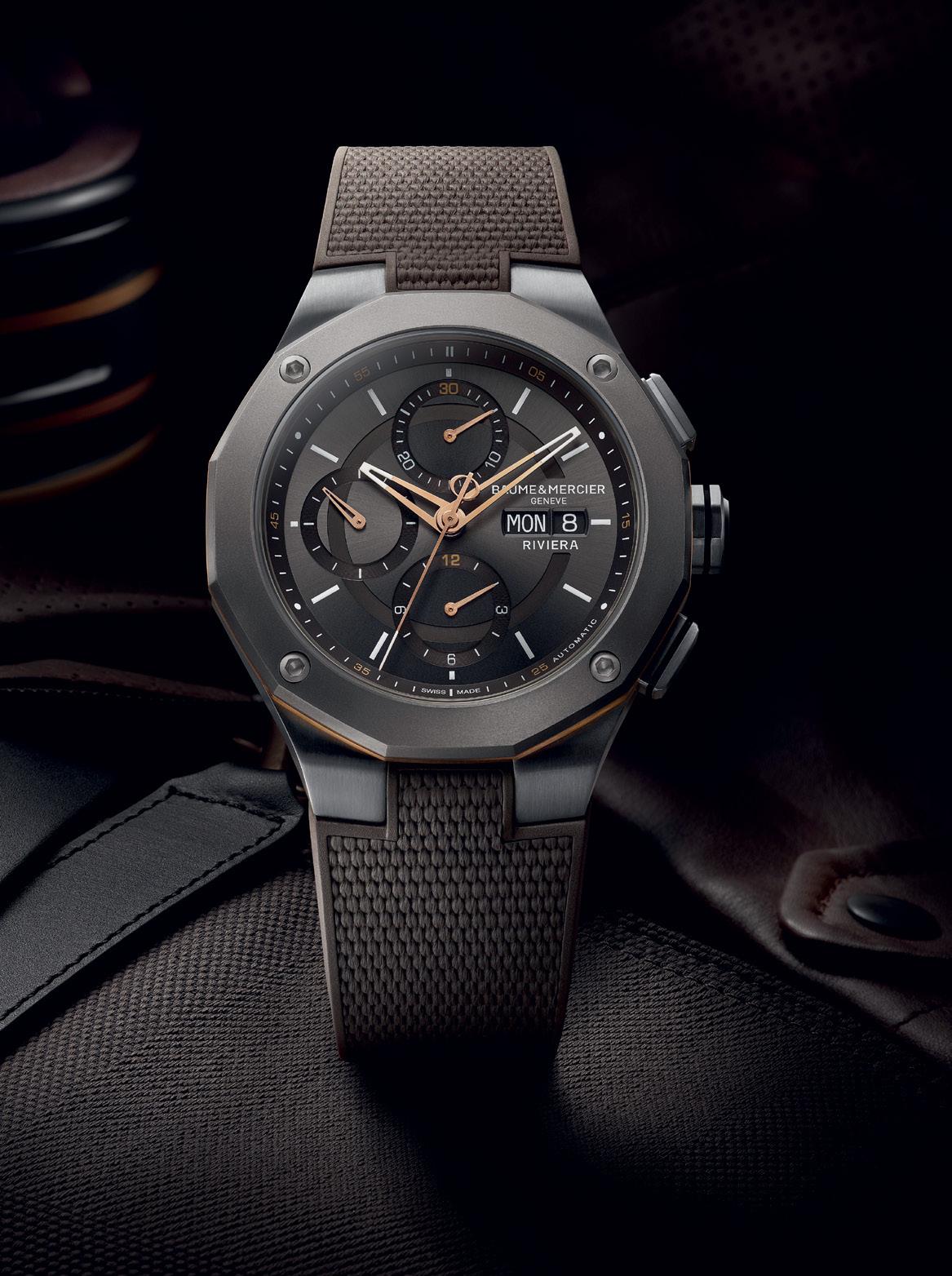
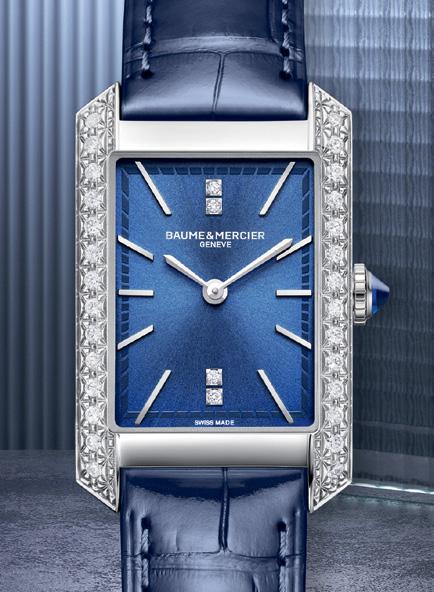
Fateci caso. Nella storia dell’orologeria svizzera non sono pochi i marchi composti da un doppio cognome. Vacheron Constantin, Patek Philippe, Jaeger-LeCoultre, Audemars Piguet, Baume & Mercier hanno alle spalle secoli di vita e grandi epopee da raccontare. Epopee che spiegano l’eccellenza degli orologi con quei cognomi scritti sul quadrante. Una storia che vale la pena conoscere è quella di Baume & Mercier, iniziata dal sogno di due fratelli, Louis-Victor e Pierre-Joseph Celestine Baume. Correva l’anno 1830 e agli esordi l’azienda, allora conosciuta come Frères Baume, vendeva i propri orologi da tasca in un negozio nel villaggio di Les Bois, nel Giura svizzero. Verso il 1850, Frères Baume si era già costruita una solida reputazione nell’orologeria di qualità, tanto da arrivare ad aprire una filiale a Londra, che allora era un mercato importante, in espansione verso India, Australia, Nuova Zelanda, Singapore e altri Paesi che facevano parte dell’Impero Britannico. Non erano segnatempo banali quelli dei fratelli Baume: comprendevano complicazioni di alta orologeria come il cronografo, il calendario, il tourbillon e la ripetizione minuti. Erano anche celebri per la precisione e l’accuratezza della rilevazione cronometrica, che valse loro 10 premi Grand Prix e sette medaglie d’oro in mostre internazionali lungo tutto l’800. Quando il XX secolo vide la progressiva affermazione degli orologi da polso su quelli da tasca, la terza generazione della famiglia Baume cavalcò quella rivoluzione grazie anche all’aiuto di un immigrato russo, Paul Tchereditchenko. Sua madre, svizzera, nata Mercier, era sposata con un ufficiale dell’esercito zarista e si trasferì in patria una volta vedova. Paul prese il suo cognome e nel 1912, mentre lavorava come venditore dal gioielliere Haas a Londra, incontrò William Baume, nipote di Louis-Victor. Insieme formarono un binomio perfetto e nel 1918 fondarono la nuova società Baume & Mercier, con sede a Ginevra, che un anno dopo fu insignita del prestigioso Poinçon de Genève per la sua produzione orologiera. Abbracciò sia la nuova era del polso, sia l’estetica Art Déco che stava investendo l’Europa e le Americhe. Baume & Mercier fu pioniere nelle casse di forma e nei movimenti di alta precisione e ampliò la distribuzione in tutto il mondo. Grazie all’esperienza di Paul Mercier nella gioielleria, il marchio produsse una serie di orologi

da donna con cassa baignoire negli anni ‘20 e ’30, mentre dalla metà alla fine del XX secolo si spostò verso le classiche casse tonde, in particolare negli orologi maschili. Negli anni ’60 avvenne l’adozione della lettera greca Phi come logo, richiamo alla sezione aurea e al relativo equilibrio naturale. In quello stesso periodo iniziarono i passaggi di proprietà per l’azienda, acquisita da Piaget nel 1964 fino a quando Cartier ne prese il controllo, nel 1988, per formare il gruppo che divenne noto come Vendôme Luxury Group nel 1993. Vendôme fu assorbito da Richemont nel 1998 e Baume & Mercier si trovò ad avere in famiglia, oltre che Cartier e Piaget, brand come Vacheron Constantin, Jaeger-LeCoultre, Panerai e IWC. Ancora oggi, le collezioni sviluppate a partire dagli anni ’50 del ‘900 costituiscono le perle della preziosa collana del brand, che hanno il nome di Clifton, Hampton, Classima e Riviera. La collezione Clifton, nata nel 2013, ha radici estetiche molto più profonde, con elementi di design che provengono da un modello degli anni ‘50 presente negli archivi del marchio. Gli orologi della collezione hanno casse classiche tonde, quadranti con finiture di alta qualità, sottili lancette “alpha” e sottili indici a bastone applicati, anche se i primi modelli presentavano a volte numeri arabi. I modelli Clifton a tre lancette sono stati i primi orologi di Baume & Mercier a essere dotati del movimento di manifattura Baumatic, certificato come cronometro, antimagnetico e con intervalli di manutenzione più ampi rispetto a quelli dei calibri standard. I modelli Clifton Baumatic si distinguono dai non Baumatic per il motivo a mirino posto al centro del quadrante, che li individua come certificati cronometro dal COSC. Negli anni i Clifton sono stati una palestra per le complicazioni di Baume & Mercier, dai cronografi ai calendari completi, specialmente dall’introduzione del calibro Baumatic, utilizzato come base cui aggiungere moduli dedicati. La complicazione più semplice dell’attuale collezione è una fase lunare con data analogica integrata in un unico quadrante a ore 6. I modelli day-date e fase lunare combinano una doppia fase lunare e una data analogica a ore 6 con un indicatore del giorno a ore 12. Il top di gamma è il calendario perpetuo, il cui quadrante bilanciato ospita le indicazioni del mese e dell’anno bisestile a ore 12, il giorno della settimana a ore 9, la data alle 3 e la fase lunare alle 6. Sebbene sia l’orologio più costoso della collezione, è uno dei calendari perpetui svizzeri meno cari sul mercato. La linea Hampton incarna invece lo stile in voga nel periodo di massimo splendore dell’Art Déco, che si traduceva nei pezzi da donna con cassa rettangolare degli anni ’40. Rilanciata da
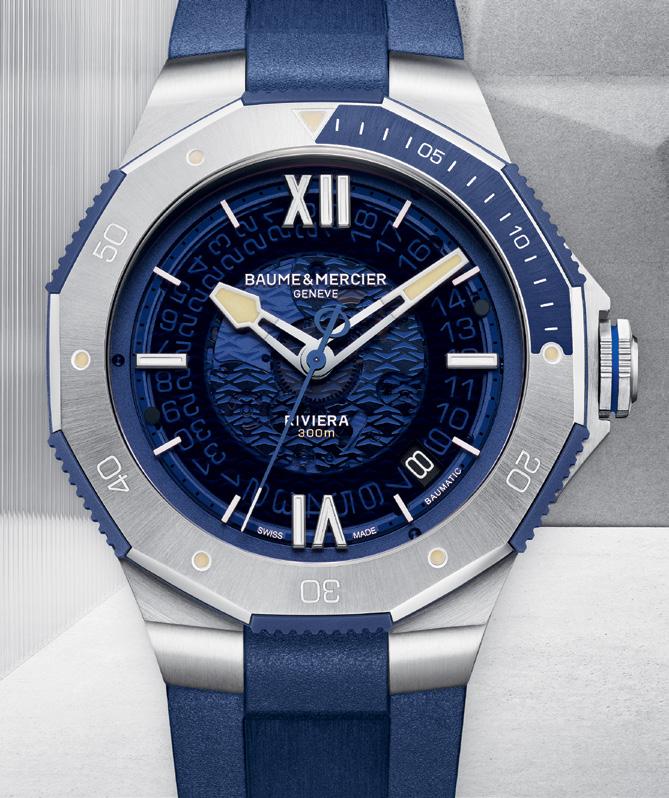
Baume & Mercier nel 2012, si è guadagnata subito la fama di collezione dal sapore retrò e dal fascino unisex. Gli orologi Hampton hanno casse di diverse dimensioni, pensate per l’uomo e per la donna e molti dei modelli più grandi hanno movimenti automatici. I quadranti sono caratterizzati da lancette a forma di spada e da un anello con indici applicati. La referenza più affascinante ha la finestra della gran data sotto le ore 12 e un indicatore combinato di giornonotte e piccoli secondi posto simmetricamente, a ore 6. La collezione di Baume & Mercier più ampia, diversificata ed eclettica in termini di dimensioni, decorazioni e calibri è la Classima. Nel suo nome sono racchiusi i concetti di eleganza discreta e design semplice e senza tempo che caratterizzano il marchio. All’interno di un assortimento che offre diverse possibilità sia al femminile sia al maschile, gli orologi di questa collezione hanno dettagli di stile ben definiti: numeri romani per le ore a 3, 6, 9 e 12 (con un datario a ore 3 in molte referenze), lancette a foglia e finiture del quadrante soleil o guilloché. La collezione comprende anche modelli femminili con quadranti in madreperla e indici di diamanti tra i numeri romani.
Nata nel 1973, la collezione Riviera traduce nella modernità delle sue forme la visione dell’orologeria di Baume & Mercier che permane da quasi 200 anni. Alla sua uscita, Riviera ha sovvertito i codici orologieri dell’epoca, grazie alla cassa con un’inedita lunetta dodecagonale
con quattro viti ben visibili e funzionali, abbinata a un bracciale integrato in metallo a maglie piatte. A distanza di cinquant’anni continua a farsi ammirare sempre con la stessa creatività che, indipendentemente dai colori e dalle funzioni, richiama la Riviera francese e i valori cui si ispira: stile, atmosfera, relax, emozioni. Indici di ore e minuti applicati, a bastone e in numeri romani, lancette Dauphine parzialmente traforate, quadranti lavorati con motivi strutturati sono le cifre estetiche caratteristiche del Riviera. Una collezione che, negli anni, si è arricchita di complicazioni come il cronografo, le fasi lunari, il calendario completo e, recentemente, l’indicazione delle maree. Una complicazione insolita che lega ancora di più l’orologio al suo DNA marinaro. «Sono nato nel 1817, il 25 agosto, alle ore 5 del mattino nella casa detta “Sui Rochats”, comune della Ferrière. Mi chiamo Louis Victor». Inizia così un modesto taccuino di memorie scritto da uno dei fondatori del marchio. Da quel giorno sono passati oltre due secoli, qualcosa meno dalla nascita dell’azienda, ma lo spirito dell’epoca rimane intatto nelle collezioni del marchio. Perché la missione dei fratelli Baume era quella di “fabbricare solo orologi di qualità”, guidati da una parola d’ordine: “Niente ci deve sfuggire”. Così era, così è ancora oggi.
Let’s think about this. In the history of Swiss watchmaking, there are many brands bearing double last names. Vacheron Constantin, Patek Philippe, Jaeger-LeCoultre, Audemars Piguet, Baume & Mercier all have centuries of experience behind them and epic stories to tell.Epic stories that showcase the excellence of watches with those last names inscribed on the dial. One story worth knowing is that of Baume & Mercier, which began with the dream of two brothers, LouisVictor and Pierre-Joseph Celestine Baume. In its early days in 1830, the firm, then known as Frères Baume, sold pocket watches in a shop in the village of Les Bois,in the Swiss Jura.By the 1850s,Frères Baume had built a solid reputation in quality watchmaking, to the extent that it opened a branch in London which, at that time, was an important market for expansion into India, Australia, New Zealand, Singapore and other countries belonging to the British Empire.These were no ordinary timepieces: they included high watchmaking complications such as the chronograph, calendar, tourbillon, and minute repeater. They were also renowned for the precision and accuracy of their chronometry,whichearnedthem10GrandPrixawards and seven gold medals in international exhibitions throughout the 19th century. When the 20th century witnessed a preference for wristwatches over pocket watches, the third generation of the Baume family was able to straddle that revolution thanks also to the helpofaRussianimmigrant,PaulTchereditchenko.His Swiss mother,née Mercier,was married to an officer in the Tsarist army but returned to her homeland after being widowed. Paul adopted her name and in 1912, while working as a salesman at the Haas jewelry firm in London,he met William Baume,grandson of LouisVictor.The pair were a perfect match,and together in 1918 they founded the new, Geneva-based company Baume & Mercier,which won the prestigious Poinçon deGenèveforitswatchmakingjustayearlater.Thefirm embraced both the new era of the wristwatch and the Art Deco aesthetic that was sweeping through Europe and the Americas.Baume & Mercier was a pioneer in shaped watch cases and high-precision movements, and expanded distribution worldwide.Thanks to Paul Mercier’s experience in jewelry, the brand produced a series of women’s watches with baignoire cases in the 1920s and 1930s, while between the mid- to the late 20th century it moved towards the classic round cases,particularly for men’s watches.In the 1960s,they
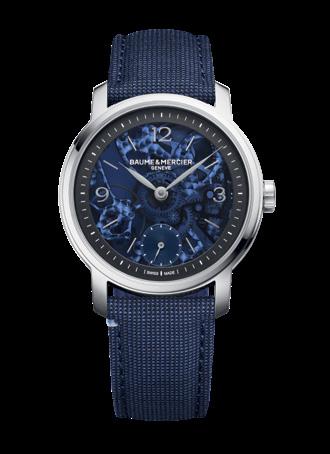
adopted the Greek letter Phi as their logo,a reference to the golden ratio and its natural proportion. In the sameperiodthechangesofownershipbegan:thefirm wasacquiredbyPiagetin1964,takenoverbyCartierin 1988,toformthegroupknownastheVendômeLuxury Group in 1993.Vendôme was absorbed by Richemont in 1998, and Baume & Mercier found itself within a familythat,besidesCartierandPiaget,includedbrands suchasVacheronConstantin,Jaeger-LeCoultre,Panerai and IWC. Even today, the collections developed since the1950sarethepreciousstringofpearlsofthebrand, bearing the names of Clifton,Hampton,Classima and Riviera.
Originated in 2013, the Clifton collection has much deeperaestheticrootswithdesignelementsthatcome from a model designed in the 1950s and found in the brand’s archives.The watches in this collection feature classic round cases, dials with high-quality finishes, slender “alpha” hands, and thin appliquéd baton indexes, although earlier models sometimes featured Arabic numerals.The three-hand Clifton models were the first Baume & Mercier watches to be equipped with the Baumatic movement,which is chronometercertified, anti-magnetic and wider service intervals than standard calibers. The Clifton Baumatic models are distinguished from non-Baumatic models by the crosshair pattern in the center of the dial, which identifies them as chronometer-certified by COSC. Over the years, the Cliftons have served as a training ground for Baume & Mercier’s complications, ranging from chronographs to full calendars, especially since the introduction of the Baumatic caliber, used as a base for adding dedicated modules. The simplest complicationinthecurrentcollectionisamoonphase withananalogdateincorporatedintoasingledialat6 o’clock.Theday-dateandmoonphasemodelscombine a double moon phase and an analog date at 6 o’clock with a day indicator at 12 o’clock. At the top of the range is the perpetual calendar, whose well-balanced dial contains the month and leap year indications at 12 o’clock,the day of the week at 9 o’clock,the date at 3 o’clock and the moon phase at 6 o’clock. Although it is the most expensive watch in the collection, it is one of the least expensive Swiss perpetual calendars on the market.
The Hampton line embodies the style that was in vogue during the Art Deco heyday, which resulted in women’s watches with rectangular cases in the 1940s. RelaunchedbyBaume&Mercierin2012,thecollection immediately gained a reputation for its retro style and unisex appeal.The Hampton watches feature cases in differentsizesdesignedforbothmenandwomen,and manyofthelargermodelshaveautomaticmovements. The dials include sword-shaped hands and a ring with

appliquéd indexes. The most handsome model has a large date window below 12 o’clock and a combined day-night indicator and a small second-hand indicator symmetrically placed at 6 o’clock.
Baume & Mercier’s largest, most diverse and eclectic collection in terms of size,ornamentation and caliber is the Classima.Its name encapsulates the concepts of discreet elegance and simple, timeless design of the brand. Offering an assortment of different watches for both women and men, the collection features well-established style details: Roman numerals for the hours at 3,6,9 and 12 o’clock (with a date window at 3 o’clock in many models),leaf hands and a dial with a soleil or guilloché finish.The collection also includes women’s models with mother-of-pearl dials and diamond indexes between the Roman numerals. Created in 1973, the modern shapes of the Riviera collection translate the Baume & Mercier’s vision of watchmaking,whichhasenduredforalmost200years. When it was launched, Riviera broke the traditional codes of watchmaking at the time,thanks to the case with a new dodecagonal bezel equipped with four clearlyvisibleandfunctionalscrewsandbuilt-inmetal strap with flat links. Fifty years later, it continues to be admired for the same creativity that, regardless of the colors and functionality,evokes the French Riviera and the values behind it: style, ambience, relaxation, emotions.Appliquéd hour and minute indexes,baton and Roman numerals, partially perforated Dauphine hands, dials with structured designs represent the aesthetic characteristics of the Riviera. A collection that, over the years, has been enhanced with complications such as the chronograph,moon phases, full calendar and, more recently, a tideograph. An unusual complication that links the watch even more closely to its seafaring DNA.
“I was born in 1817, on August 25, at 5 o’clock in the morning in a house called ‘Sur les Rochats’, in the commune of La Ferrière. My name is Louis Victor”. Thus begins a modest memoir written by one of the brand’s founders.More than two centuries have passed since that day, a little less since the company was founded,but the spirit of the era remains intact in the brand’s collections. Because the mission of the Baume brothers was to “manufacture only quality watches”, guidedbythemotto:“Acceptonlyperfection”.Soitwas then,so it still is today.

1 - BELL & ROSS BR 03-92 Diver
Bronzo e verde sono una combinazione insolita ma sofisticata, evocativa ed elegante. Anche per un subacqueo super sportivo. Inatteso.
Bronze and green are an unusual yet sophisticated, evocative and elegant combination.Even for a super sporty diver.Unexpected.
2 - BLANCPAIN Fifty Fathoms 70th Anniversary Act 3
Il terzo atto di una trilogia che celebra il capostipite degli orologi da immersione si ispira a una referenza storica. Must have.
Thethirdactofatrilogycelebratingthearchetypeofdiving watches is inspired by a historical reference.Must have.
3 - PANERAI Submersible Luna Rossa
Affidabile sia sotto le onde sia sopra il pelo dell’acqua, grazie alla partnership con il team italiano di Coppa America. Performante.
Reliable under the waves as well as above the water,thanks to the partnership with the Italian America’s Cup team. Performing.
4 - ROLEX Submariner
Se chi vuol creare orologi subacquei cerca una pietra di paragone, la può trovare solo nella Maison ginevrina. Senza tempo.
If those seeking to create divers’watches are looking for a touchstone,they will find it only at the Geneva-based firm. Timeless.
5 - SEIKO Prospex Marinemaster
Una moderna interpretazione del diver del 1965 festeggia i 100 anni del brand con una collezione che fa storia. Seducente.


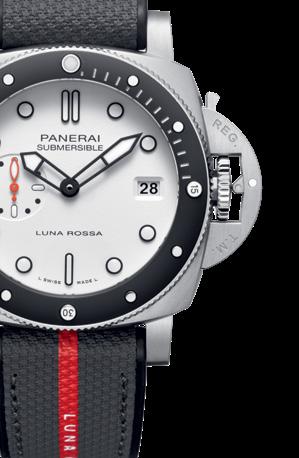
A modern interpretation of the 1965 diver’s watch celebrates the brand’s 100th anniversary with a historymaking collection.Seductive.
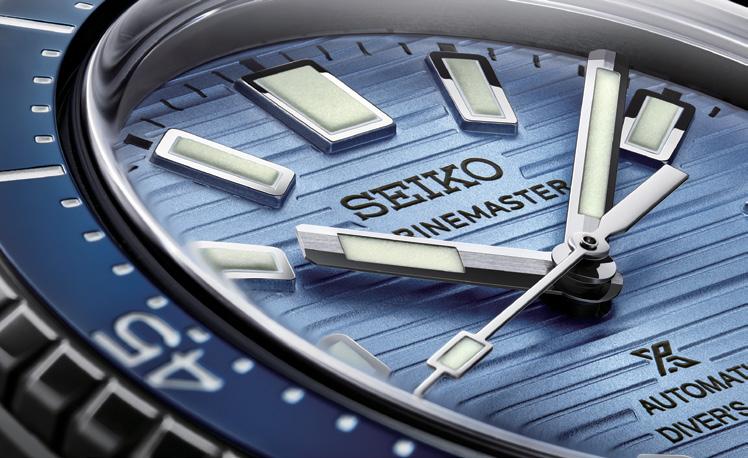
 by Davide Passoni
by Davide Passoni

1 - CHANEL Mademoiselle J12 La Pausa
Una edizione limitata che rende omaggio a Gabrielle Chanel, al suo amore per i diamanti, al suo talento per la moda e l’arte. Très chic.
AlimitededitionthatpayshomagetoGabrielleChanel,her love of diamonds and her talent for fashion and art. Très chic.
2 - DOLCE&GABBANA DG7 Gems Rainbow
Quattro topazi blu incastonati nel quadrante con un sistema brevettato dalla Maison illuminano le serate glamour. Sorprendente.
Four blue topazes set into the dial with a House-patented system to light up glamorous evenings.Surprising.
3 - JAEGER-LECOULTRE Reverso One Precious Colours
Riafferma la maestria del marchio svizzero nei mestieri d’arte e nelle tecniche di gioielleria, applicati a una cassa iconica. Supremo.
It reaffirms the Swiss brand’s mastery of handcraft and jewelry techniques,applied to an iconic case.Supreme.
4 - OMEGA Constellation Meteorite
Il più antico meteorite conosciuto rende ciascun quadrante diverso dall’altro ed esprime l’individualità di chi lo indossa. Unico.
The oldest known meteorite makes each dial distinctive and expresses the individuality of the wearer.Unique.
4 - TAG HEUER Carrera Date Plasma Diamant d’AvantGarde
Un trionfo di diamanti da laboratorio crea un orologio che è un tappeto di luce, capace di abbagliare e ammaliare. Show-off.
A triumph of lab-grown diamonds creates a watch that is a canvas of light, capable of bedazzling and bewitching. Show-off.
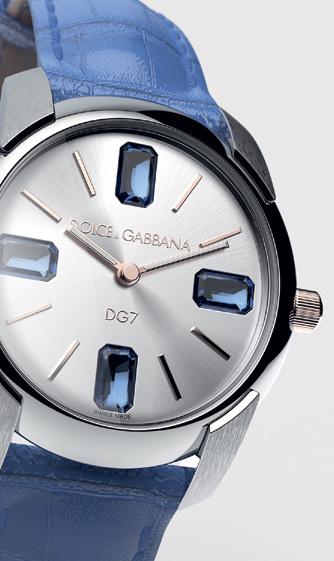

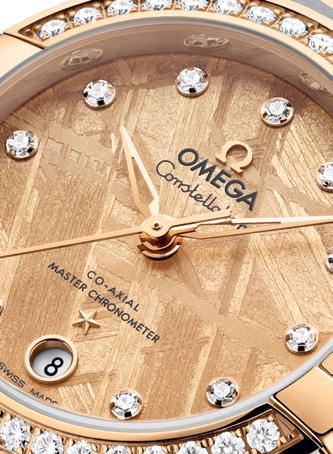

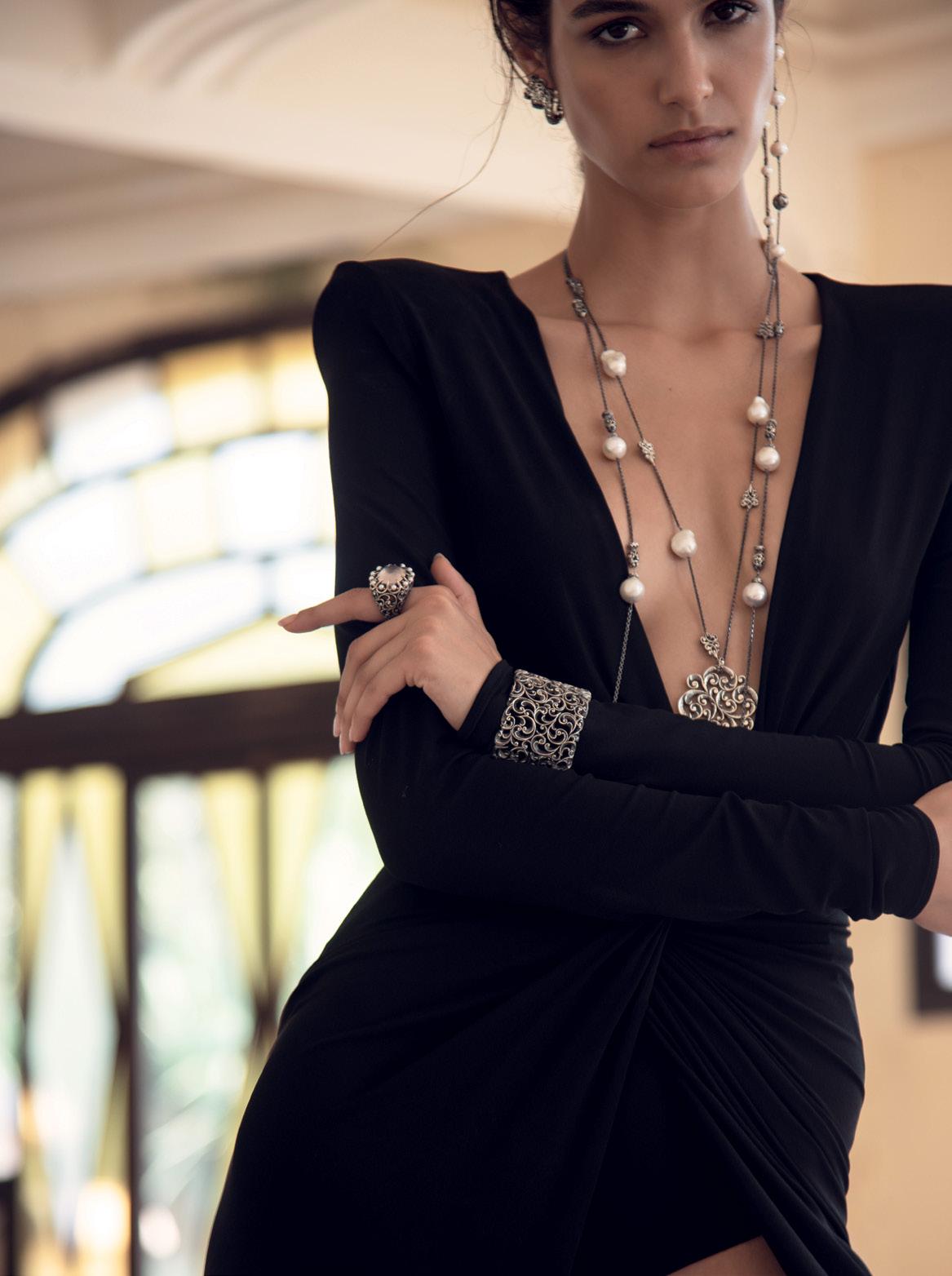 by Antonella Garello
by Antonella Garello

Partiamo dal nome. Anzi, dai nomi. Perché se non è certo raro imbattersi in brand che portano il nome dei fondatori, nel caso di Maria e Luisa quella “e” non commerciale sembra voler rimandare quasi più a una sfera privata che al mondo dell’industria e dell’economia. Maria Luisa Pianegonda racconta di non essere riuscita a trovare un nome o una parola che rappresentasse compiutamente il progetto che aveva in mente: «Così l’impresa è nata coi miei due nomi, al tempo stesso separati e uniti da questa “e”… un po’ mi piaceva pensare a due diverse anime e identità - sentimento e razionalità, Oriente e Occidente e così via - ma soprattutto mi piaceva il concetto di “stare insieme”, di comunità, che questa “e” sa esprimere. Perché la mia più grande gioia e il mio orgoglio è proprio la consapevolezza, fin dagli inizi, di “essere insieme” a tante persone, sia in azienda sia tra i clienti, che nel tempo hanno abbracciato e continuano a portare avanti il mio progetto».
Il progetto di Maria e Luisa Jewels ha visto la luce una decina di anni fa, largamente come sintesi di un periodo di profondo ripensamento
al termine dell’esperienza ultraventennale come responsabile marketing e comunicazione nell’azienda fondata dal fratello: anni di grande sperimentazione e creatività, di entusiasmo e di impegno totalizzante. «Mi sono fermata e di colpo mi sono trovata a decidere della mia vita, a decidere che cosa avrei voluto fare e che tipo di persona avrei voluto essere. In questo periodo sono stati decisivi i viaggi in Nepal, India e Afghanistan a fianco del mio compagno, che ha fondato Pangea, una Onlus a sostegno delle donne vittime di violenza e discriminazione: in queste situazioni si incontrano un mondo e un’umanità sconosciuti e in questo incontro è impossibile non farsi domande, non mettersi in discussione. Trovi un altro respiro, ti guardi intorno, e di colpo “vedi”, anche dentro di te». Altrettanto decisivo è stato l’incontro con diversi artigiani milanesi che hanno mostrato a Maria Luisa una maniera di lavorare lontana da ogni frenesia, una artigianalità fatta di gesti misurati e perfetti. «Io mi sono letteralmente innamorata di quella pace, di quei gioielli realizzati a mano al banchetto con grande passione, con grande cura,
prendendosi il tempo necessario per vivere tutta la poesia del proprio lavoro, dove ogni piccola cosa diventa importantissima. E ho capito che quella poteva essere la via per ricominciare». Correva l’anno 2013, un periodo estremamente complicato, in cui un po’ in tutti i settori erano molte le aziende che, spinte dalla crisi e dalla concorrenza, avevano scelto o erano in procinto di scegliere la via della delocalizzazione. E i gioielli in argento erano un po’ la Cenerentola del mercato: dovevano essere “facili”, pesare poco, garantire buoni margini. Maria Luisa Pianegonda è andata controcorrente: «Fin dal primo momento ho voluto che i miei gioielli fossero davvero Made in Italy, realizzati in Italia da persone che oltretutto conoscevo personalmente, di cui conoscevo anche le storie; e poi volevo che fossero in argento, un materiale che ho sempre amato, ma diversi da quelli che vedevo in giro: volevo che fossero gioielli di qualità e con contenuti di valore, con un design innovativo e che sapessero però esprimere quella verità e quella bellezza che affondano nella tradizione del passato». Da dieci anni Maria Luisa Pianegonda lavora gomito

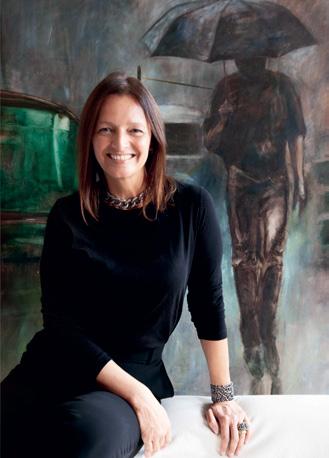
a gomito con i “suoi” artigiani di Milano, Vicenza e Valenza e l’obiettivo è rimasto lo stesso, creare gioielli capaci di suscitare emozione. L’argento brunito, nelle ultime collezioni anche placcato oro, inciso a bulino e lavorato con l’arte antica dell’intarsio - fil rouge di tutte le linee - prende vita tra volute e intagli, si illumina della luce delle perle e delle pietre, rivela dettagli sempre nuovi. «Mi piace guardare al passato, perché in quelle tecniche antiche trovo qualcosa di autentico, di profondo, di bello che mi aiuta e mi colpisce. Così come mi piace l’attenzione che viene dedicata a ogni singolo gioiello, perché è di tante piccole attenzioni che dovremmo nutrire il nostro presente e mi dà gioia pensare che i miei gioielli siano come piccoli granelli di bellezza capaci di regalare emozione».
Oggi sono circa 130 le gioiellerie che, tra Italia, Spagna, Portogallo e Francia, rappresentano Maria e Luisa Jewels e il piano di sviluppo del brand prevede l’espansione verso l’estero e il consolidamento della rete vendita.«I nostri gioielli sono apprezzati da uomini e donne che non vogliono ostentare, non vogliono apparire, ma al contrario vogliono lasciare un’impronta di stile, di fascino, e acquistano sulla base di una scelta personalissima perché ricercano qualcosa di veramente particolare». Maria Luisa Pianegonda infatti non si ispira ad alcun modello, piuttosto vive d’istinto e di curiosità, osservando quanto le sta intorno, anche in mondi lontanissimi da quello del gioiello, ricercando l’essenza di quanto è fatto bene, con passione e amore. «Mi capita di guardare con ammirazione le cose più diverse, spettacoli, concerti, sfilate, opere ed eventi… E mi dico che ogni giorno devo imparare qualcosa!».


concept of“being together”,of community,that this“e” can express. Because my greatest joy and pride is the knowledge, from the very beginning, that I am“with” so many people,both in the company and among the clients,who over time have embraced and continue to take my project further”.
The project of Maria Luisa Pianegonda is based on ancient techniques, craftsmanship and a deep love of silver
Let’s start with the name.Well,from the names,plural. Because while it is certainly not uncommon to come across brands named after their founders,in the case of Maria e Luisa that noncommercial “e” (“and” in Italian) seems kind of more meant to refer to a private sphere than to the world of industry and business. Maria Luisa Pianegonda tells that she could not find a name or word that fully represented the project she had in mind,“So the business was launched with my two names. And I chose to separate and unite them at the same time by this “e”... I liked to think of two different souls and identities - feeling and rationality, East and West and so on - but most of all I liked the
The Maria e Luisa Jewels project saw the light of day a decade ago, largely as a synthesis of a period of profound rethinking at the end of more than 20 years’experience as a marketing and communications manager in the company founded by her brother; this involvedyearsoflotsofexperimentationandcreativity, enthusiasm and all-encompassing commitment. “I stopped and suddenly found myself deciding about my life,deciding what I wanted to do and what kind of person I wanted to be.During this time,trips to Nepal, India and Afghanistan were decisive for me. I went with my partner, who founded Pangea, a nonprofit supporting women who were victims of violence and discrimination. In these situations you encounter an unfamiliar world and humanity,and in this encounter it is impossible not to ask questions, not to question yourself. You find another breath, you look around, and suddenly you“see”,even within yourself”.Equally decisive was the meeting with several Milanese artisans who showed Maria Luisa a way of working far from any frenzy; a craftsmanship made up of measured and perfect gestures.“I literally fell in love with that peace,those jewels handmade at the bench with great passion,with great care,taking the time to experience all the poetry of one’s work, where every little thing becomes most important. And I realized that that could be the way to start again”. Itwas2013,anextremelycomplicatedtime,whenthere were many companies in all sectors that, pushed by the crisis and competition,had chosen or were about to choose to branch out. And silver jewelry was like the Cinderella of the market: it had to be“easy”,weigh little, provide good margins. Maria Luisa Pianegonda went against the grain.“From the very first moment, I wanted my jewelry to be truly Made in Italy,made in
ItalybypeoplethatIknewpersonallytoo,whosestories Ialsoknew;andthenIwantedittobemadeofsilver,a material I have always loved,but it was to be different from what I saw around me; I wanted it to be quality jewelry with valuable content, with an innovative design and yet able to express that truth and beauty thatisrootedinthetraditionofthepast”.Fortenyears, Maria Luisa Pianegonda has been working shoulder to shoulder with “her”artisans in Milan, Vicenza, and Valenza,andthegoalhasremainedthesame:tocreate jewelry capable of evoking emotion. Burnished silver, also gold-plated in the latest collections, and handengraved with a burin, worked with the ancient art of inlaying (the common thread running through all the lines), comes to life amid spirals and carvings, it glows with the light of pearls and stones, and reveals ever-new details.“I like to look to the past because I find something authentic,something deep,something beautiful in those ancient techniques that helps and touches me.Just as I like the attention that is paid to each piece of jewelry,because it is from so many small detailsthatweshouldnourishourpresent,anditgives me joy to think that my jewelry is like small grains of beauty capable of triggering emotion”.
Today there are some 130 jewelry stores in Italy,Spain, Portugal and France that represent Maria e Luisa Jewels, and the brand’s development plan includes expansion abroad and a consolidation of the sales network. “Our jewelry is appreciated by men and womenwhodon’twanttoshowoff,butonthecontrary wanttoleaveanimpressionofstyle,ofcharm,andthey buy on the basis of a very personal choice because they are looking for something truly special”. In fact, Maria Luisa Pianegonda is not inspired by any model, rather she lives by instinct and curiosity, observing what is around her, even in worlds far removed from that of jewelry,searching for the essence of a job well done, with passion and love.“I happen to watch the most diverse things with admiration: shows,concerts, runway shows, operas and events... And I tell myself that every day is a learning day!”
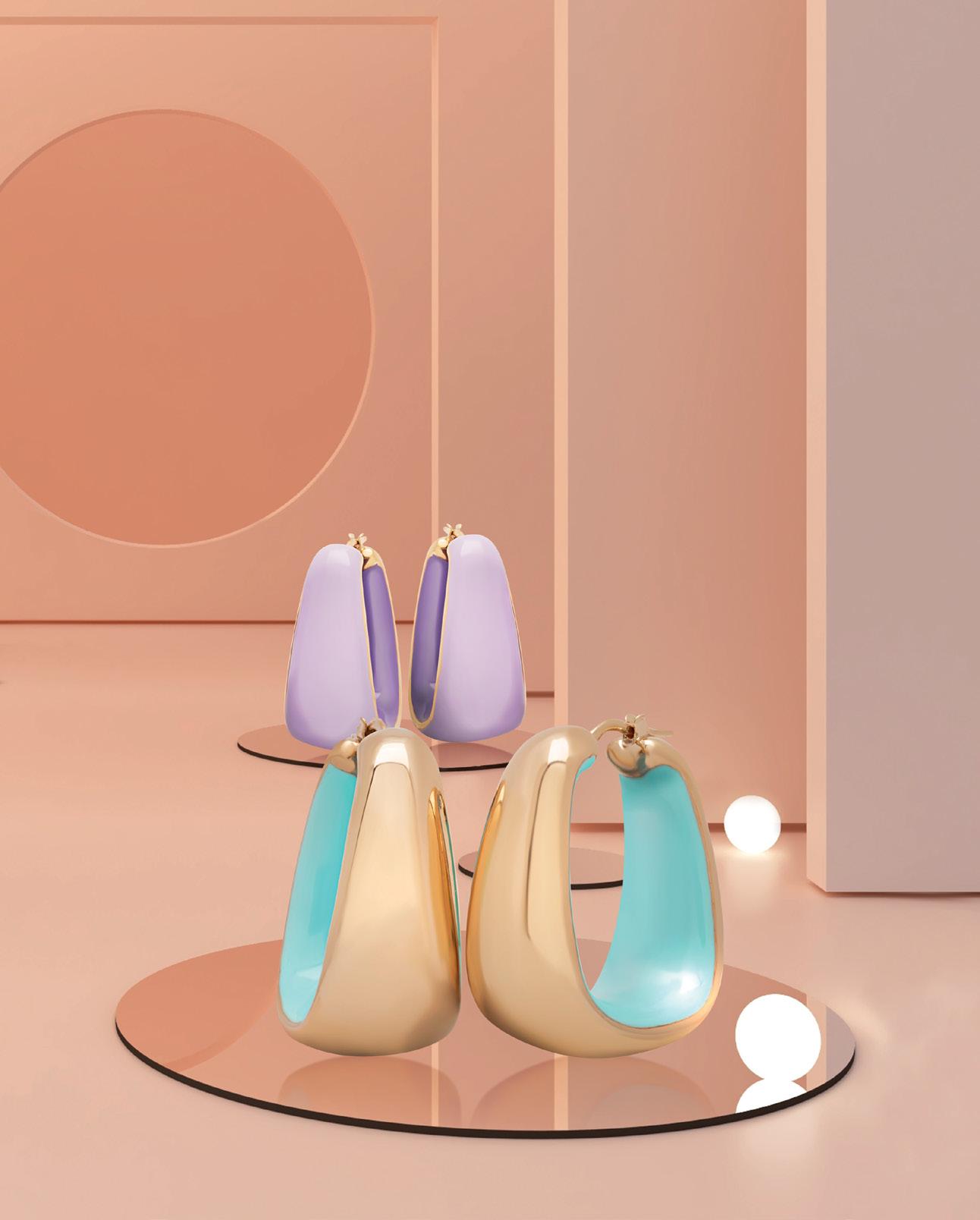 by Salvador Asensio
by Salvador Asensio

A/ TATEOSSIAN Cufflinks
Un sottile tocco di eleganza per l’uomo contemporaneo. In oro bianco e diamanti, disponibili anche con perle bianche.
A subtle touch of elegance for the contemporary man. In white gold and diamonds,also available with white pearls.
B/ RIKKE LUNNEMANN Cumulus rings
Minimalismo scandinavo in oro giallo riciclato con perle colorate d’acqua dolce, disponibile la variante con un piccolo diamante.
Scandinavian minimalism in recycled yellow gold with coloredfreshwaterpearls,theversionwithasmalldiamond is also available.
C/ AUSTY LEE The Anabolism of Red earrings
Con lo stile molto personale di Lee, questi orecchini sono realizzati in oro bianco 18 carati con perle di Tahiti Hanashinju, smalto rosso e diamanti.
With Lee’s very personal style, these earrings are made in 18kwhitegoldwithTahitianHanashinjupearls,red enamel and diamonds.
D/ McCAUL Earrings
Come rinnovare un classico: orecchini di perle (in questo caso dei Mari del Sud), con il massimo di semplicità ed eleganza.
How to renew a classic: pearl earrings (in this case from the South Seas),with maximum simplicity and elegance.
E/ ROBIN CALLAHAN Moi et Toi “Nagomi” ring
In giapponese il nome indica uno stato di equilibrio e armonia. Perla bianca e perla dorata dei Mari del Sud e diamanti neri.
In Japanese the name means a state of balance and harmony. White and golden South Sea pearls and black diamonds.
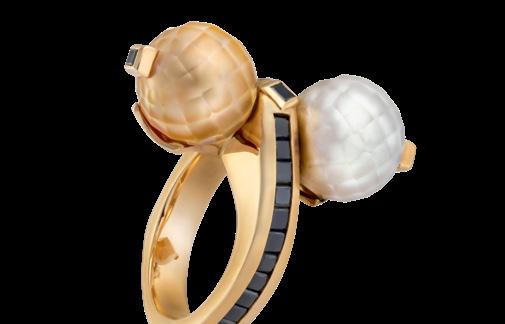
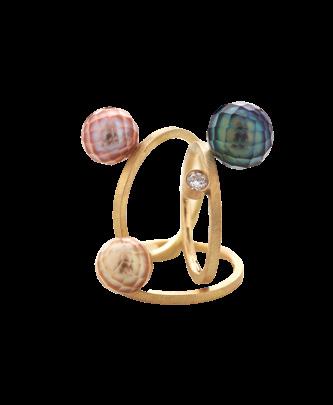

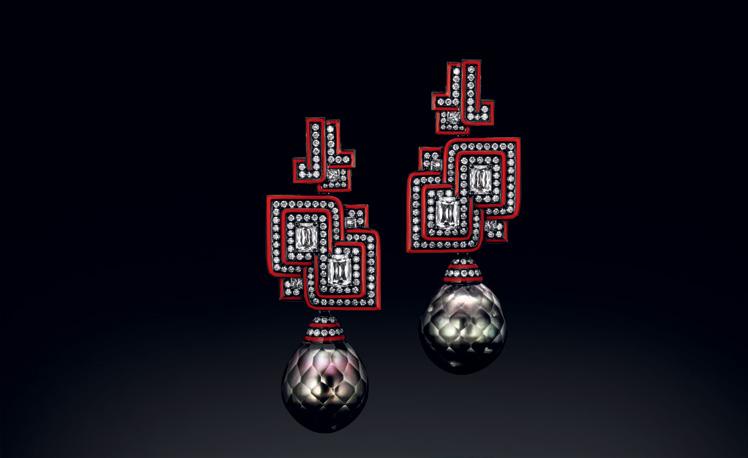
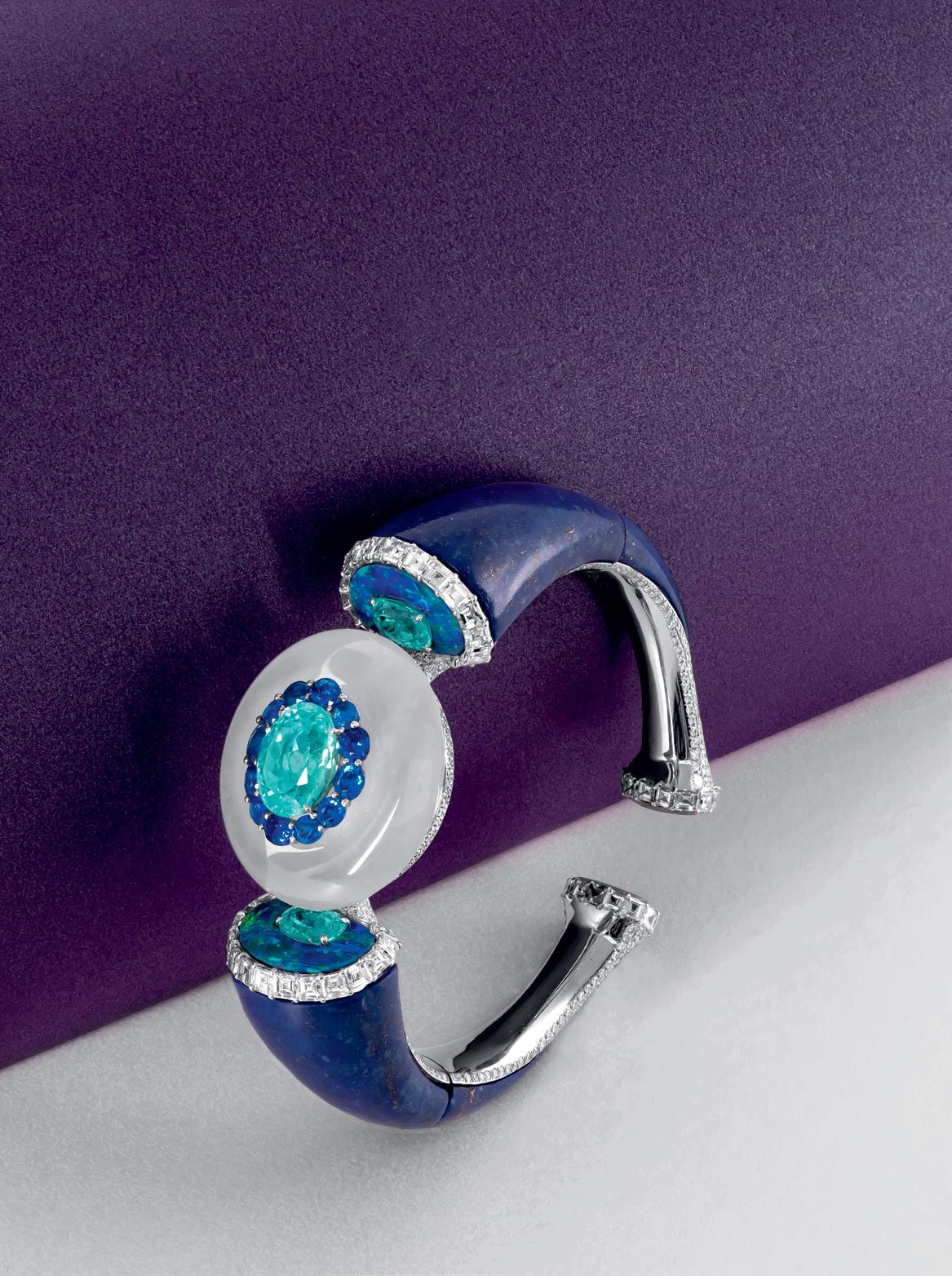
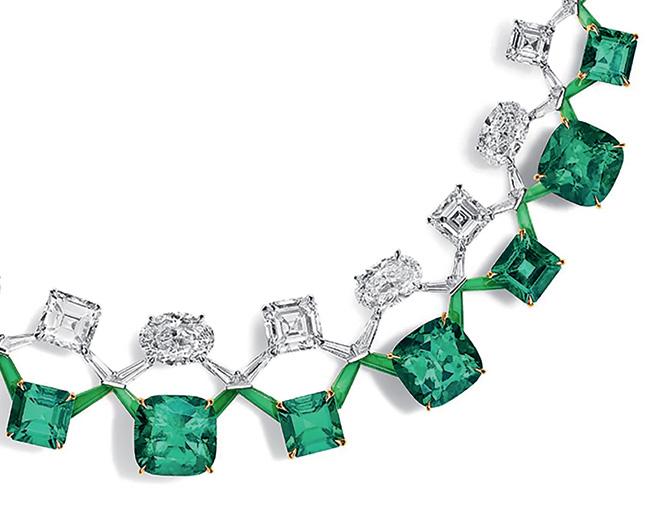
Con sede a Ginevra, la Maison è oggi nelle mani della quinta-sesta generazione guidata dal CEO Albert Boghossian, dai nipoti Roberto e Ralph e dalla figlia Dalia.
Tutto ha inizio nel 1868 con Ovaness Boghossian, di origini armene, proprio al centro della Via della Seta; una storia famigliare che si è dipanata da Est a Ovest, caratterizzata dalla innata capacità dei suoi fondatori di scovare sapientemente pietre preziose dai colori e tagli eccezionali nonché una forte capacità di identificare ed essere supportati dai laboratori di manifattura più esperti.
Proprio grazie al commercio di diamanti e pietre preziose dalla bellezza impareggiabile e alla forte ispirazione artistica e culturale, la famiglia Boghossian diventa negli anni un riferimento importante nell’universo dell’alta gioielleria.
In virtù di queste relazioni, contatti e autorevolezza a livello internazionale, Albert e suo fratello Jean si stabiliscono in Europa negli anni ’70.
Sin dalle prime creazioni del suo fondatore, Boghossian impregna le collezioni di un forte heritage artistico, fortemente legato alle origini della famiglia, supportato dall’expertise innovativa della manifattura svizzera.
Gli atelier specializzati in alta gioielleria di Ginevra rappresentano un grande supporto all’estro creativo dei Boghossian e questo segna l’apertura della sede nella città elvetica e la riconoscibilità della firma estetica Boghossian: una capacità di integrare le pietre più rare in gioielli dalle forme audaci, giocando spesso con la luce delle pietre stesse.
Roberto e Ralph, sesta generazione, sono entrati in azienda nel 2000 e a quel punto è emersa una nuova firma stilistica: un’arte dal gesto sicuro, sempre supportata dalle tecniche di manifattura svizzera e costantemente alla ricerca di nuovi stimoli e sfide.
Il 2008 segna l’apertura del monomarca in Rue de Rhône a Ginevra seguita dall’apertura della boutique a Londra nel 2013 in Old Bond Street.
Le collezioni Boghossian sono sempre caratterizzate dalla magica fusione delle culture occidentali e orientali, influenzate dall’arte e savoir-faire della Via della Seta ma supportate dalla precisa e innovativa manifattura e tecnologia svizzera.
Intricati motivi decorativi ispirati all’opulenza dell’arte e architettura orientali si mixano con colori vibranti e curve femminili che evocano il glamour e la grandeur dell’Occidente. Questa sapiente eredità stilistica oggi viene ulteriormente enfatizzata dall’esperta guida

creativa di Edmond Chin, artista visionario che da alcuni anni dirige lo studio creativo. Le cifre stilistiche della Maison Boghossian sono ancora contrassegnate da semplicità, leggerezza e fluidità, suggerendo un equilibrio tra tradizione e modernità sempre alla ricerca del magico connubio tra la pietra, il design del pezzo e il supporto di manifattura.
Boghossian non segue le vie convenzionali, detta le nuove regole nell’universo dell’alta gioielleria, e la famiglia, attraverso l’output del nuovo direttore artistico Chin, costantemente ridefinisce, reinterpreta e ri-immagina i codici del passato. La sinergia stilistica tra la famiglia Boghossian ed Edmond Chin è molto forte. Per Roberto Boghossian, il loro pensiero è sulla stessa lunghezza d’onda con una condivisione assoluta della stessa passione nella ricerca delle gemme più rare per bellezza e allure. Anche Chin possiede l’innata comprensione del valore cardine che ha la luce nel valorizzare la magia di una pietra, portando l’innovazione all’interazione massima. Ogni singolo pezzo e collezione diventa quindi un capolavoro artistico e una pietra miliare nel-
la storia della gioielleria internazionale. Boghossian ha nel tempo inventato dei nuovi modi di incassare le pietre, presentando collezioni dai nomi esotici e evocativi quali “Art of Inlay”, “Kissing technique” e “Merveilles”.
Nella tecnica “Kissing”, firma inequivocabile di Boghossian, due pietre sembrano abbracciarsi in una danza delicata, ognuna scelta a complemento dell’altra, in base al proprio colore e bellezza. “Kissing” celebra l’armonia e la semplicità del design, le pietre sono incassate con pochissimo metallo visibile, permettendo alla luce di creare una sensazione di calore e brillantezza ineguagliabili.
Nell’evoluzione delle collezioni “Kissing”, l’accento cromatico è stato posto sui colori dei quattro elementi, acqua, fuoco, aria e terra. Ognuno di essi integra ancora una volta il ricordo della Via della Seta a testimoniare i costanti viaggi tra Occidente e Oriente compiuti negli anni dalla famiglia. Con le tecniche “Art of Inlay”, Boghossian rivive una antica tradizione, caratteristica dell’artigianato della Via della Seta. In India i marmi venivano intarsiati con pietre di colore
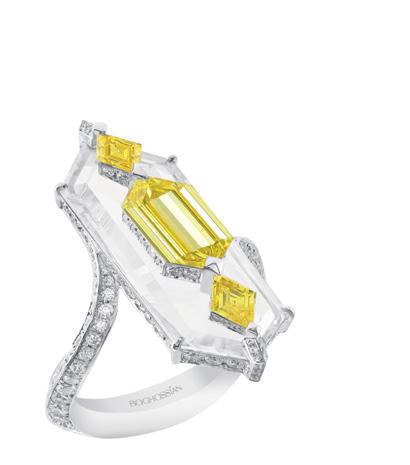
dai colori vibranti al fine di creare un’arte sofisticata che desse ulteriore brillantezza ai marmi usati come decorazione e architetture. La Maison vuole rendere omaggio a questa antica tecnica attraverso collezioni dove le pietre sono tagliate da esperti lapidari in modo da trovare tra di loro i migliori alloggiamenti e congiungersi in una straordinaria eleganza di colori, tonalità e minuzia.
“Merveilles” celebra la meraviglia della luce con collezioni che lo stesso Albert Boghossian definisce come “acquerelli con la luce”. Un metodo di incassatura brevettato dove ancora una volta diamanti taglio brillante e pietre colorate sono incassate con pochissimo metallo e a 360° intorno all’oggetto, creando un flusso di luce senza fine, ad esaltare la bellezza delle pietre. Quattro anni di ricerca e sviluppo nei migliori laboratori di gioielleria ginevrini, “Merveilles” rappresenta ancora una volta per Boghossian la costante ricerca di innovazione e la superba conoscenza delle pietre, della loro luce e la ricerca del miglior contesto per dare risalto alla loro ineguagliabile bellezza. Grazie a queste meravigliose creazioni, alla sapiente ricerca delle più belle pietre preziose, alla tecnica sofisticata, le creazioni Boghossian sono oggi ricercate dalla clientela più sofisticata, dai connaisseurs, sono spesse battute all’asta nelle più importanti Case, come ad esempio da Christie’s. Per Roberto Boghossian le forze creative e dinamiche della Maison continueranno a sorprenderci e stupirci. La massima aspirazione è quella di ispirare curiosità, ricercando sempre nuovi modi per rivoluzionare le tecniche di incassatura e manifattura. Boghossian continuerà a lungo nella sua ricerca volta a creare collezioni da sogno, profondamente radicate nel potenziale ancora inespresso dei tesori della Via della Seta.

La Fondazione Boghossian è stata istituita nel 1992 da Robert Boghossian e dai suoi due figli, Jean e Albert, con lo scopo principale di contribuire allo sviluppo e all’educazione. Nei primi quindici anni di esistenza, la Fondazione si è principalmente concentrata sul miglioramento delle condizioni di vita dei giovani in Armenia e Libano, dando loro l’opportunità di coltivare il proprio potenziale per un futuro migliore. Nel tempo la famiglia si è resa conto di poter ulteriormente ampliare il proprio approccio umanitario e dedicare il progetto della Fondazione al rafforzamento di valori umani. Sotto la guida di Jean e Albert, nel 2006 la sede si è spostata nella magica cornice di Villa Empain a Bruxelles, un capolavoro di architettura Art Déco che si stava lentamente deteriorando. Dopo quattro anni di ristrutturazione, nel 2010 Villa Empain ha riaperto le sue porte per ospitare la fondazione Boghossian, un centro di arte e dialogo tra le culture orientali e occidentali. La Fondazione oggi incoraggia e stimola le creazioni artistiche, finanzia progetti culturali ed educativi in Belgio, Libano e Armenia e ospita in modo regolare mostre e importanti artisti internazionali.
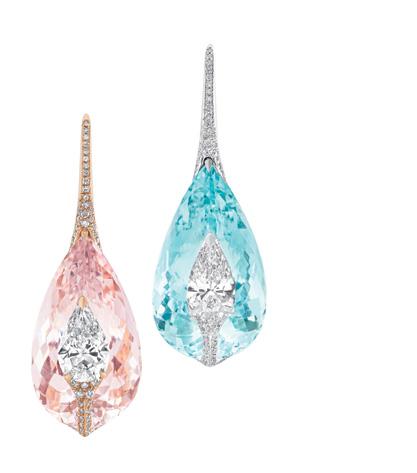
This high jewelry Maison boasts a 156-year history,from its very beginnings and still today characterized by a strong creative flair and a passionate search for the rarest and most magnificent gems
Headquartered in Geneva, the Boghossian Maison is now in the hands of the fifth-sixth generation, led by CEO Albert Boghossian, his nephews Roberto and Ralph and his daughter Dalia. It all began in 1868 with Ovaness Boghossian, of Armenian descent, at the very heart of the Silk Road; a family history that has unfolded from East to West,marked by the inborn ability of its founders to skillfully unearth gemstones with exceptional colors and cuts as well as by a great talent for identifying and being supported by the most experienced jewelry workshops. It is precisely thanks tothetradeindiamondsandgemstonesofunmatched beauty and the strong artistic and cultural inspiration that,over the years,the Boghossian family has become an important point of reference in the world of high jewelry.Onthestrengthoftheserelationships,contacts, and prominence at the international level, in the 1970s Albert and his brother Jean settled in Europe. From its founder’s very first creations, Boghossian infused the collections with a strong artistic heritage, deeply rooted in the family’s origins,supported by the innovative expertise of the Swiss craftsmanship. The ateliers specializing in high jewelry located in Geneva provided great support to the Boghossians’ creative flair,thus marking the opening of the headquarters in theSwisscityandtherecognizabilityoftheBoghossian aesthetic signature: the ability to set the rarest of gemstones in boldly shaped pieces of jewelry, often playing with the light of the gemstones themselves. Roberto and Ralph, the sixth generation, joined the company in 2000, at which point a new stylistic signature surfaced: art with a confident touch,always supported by Swiss craftsmanship techniques and the constant pursuit of new stimuli and challenges. The year 2008 marked the opening of the flagship store on Rue de Rhône in Geneva, followed in 2013 by the opening of the London boutique on Old Bond Street. The Boghossian collections always feature a magical blend of Western and Eastern cultures,inspired by the art and savoir-faire of the Silk Road but also supported bythepreciseandinnovativeSwisscraftsmanshipand technology. Intricate ornamental patterns inspired by the opulence of Eastern art and architecture are combined with vibrant colors and feminine curves that call to mind the glamour and grandeur of the West. Today, this masterful stylistic legacy is further
enhanced by the expert creative guidance of Edmond Chin, a visionary artist who has headed the creative studio for some years now. The Boghossian Maison signature styles are still characterized by simplicity, lightness, and fluidity, suggesting a balance between tradition and modernity always in search of that magical union between the gemstone, the design of the piece, and the support of the craftsmanship. Boghossian does not follow conventional routes, but instead chooses to set new rules in the world of high jewelry,and the family,through the output of the new artistic director Chin,constantly redefines,reinterprets and re-imagines the stylistic codes of the past. The stylistic synergy between the Boghossian family and Edmond Chin is very powerful. According to Roberto Boghossian,their thinking is on the same wavelength with a complete sharing of the same passion in searching for the rarest gems in terms of beauty and allure. Chin also has an innate understanding of the crucial value of light in enhancing the magic of a gemstone, bringing innovation to the highest interaction. Each individual piece and collection thus become an artistic masterpiece and a milestone in the history of international jewelry.Over time,Boghossian inventednewwaysofsettingthegemstones,presenting collections with exotic and suggestive names such as “Art of Inlay”,“Kissing technique”,and“Merveilles”.
In the “Kissing” technique, Boghossian’s unequivocal signature, two gemstones seem to embrace in a graceful dance, each one chosen to complement the other,based on their own color and beauty.
“Kissing”celebrates the harmony and simplicity of the design; the gemstones are set with very little visible metal,allowinglighttocreateafeelingofincomparable warmthandbrilliance.Intheevolutionofthe“Kissing” collections, the chromatic focus was placed on the colors of the four elements: water, fire, air and earth. Each one once again incorporates the remembrance of the Silk Road to bear witness to the many journeys between West and East undertaken by the family over theyears.Withthe“ArtofInlay”techniques,Boghossian rekindles an ancient tradition characteristic of the Silk Road craftsmanship. In India, marble was inlaid with vibrantly colored gemstones in order to create a sophisticated art that gave additional brilliance to the marble used as decoration and architecture. The Maison wants to pay tribute to this ancient technique through collections where the gemstones are cut by expert stonemasons in such a way as to find the best fitbetweenthemandjointogetherinanextraordinary elegance of colors,hues,and detail.
“Merveilles” celebrates the wonder of light with collections that Albert Boghossian himself describes as“watercolors with light.”A patented setting method where once again brilliant-cut diamonds and colored gemstonesaresetwithverylittlemetalandallaround theobject,creatinganunendingflowoflighttoenhance the beauty of the gemstones. Four years of research and development at the finest jewelry workshops in Geneva,“Merveilles”onceagainrepresentsBoghossian’s constantpursuitofinnovationandasuperbknowledge of gemstones, their light, and the search for the best context to showcase their unequaled beauty. Thanks to these magnificent creations, the skillful search for the finest gemstones,and the sophisticated technique, Boghossian’s creations are now coveted by the most refinedclientele,connoisseurs,andareoftenauctioned off at leading Houses,such as Christie’s.
For Roberto Boghossian, the Maison’s creative and dynamic forces will continue to surprise and astonish us. The highest aspiration is to spark curiosity, always searching for new ways to revolutionize the setting and manufacturing techniques. Boghossian will long persist in its quest aimed at creating visionary collections,deeplyrootedintheyetuntappedpotential of the treasures of the Silk Road.
The Boghossian Foundation was established in 1992 by Robert Boghossian and his two sons, Jean and Albert, with the primary objective of contributing to development and education. In the first fifteen years of its existence, the Foundation mainly focused on improving the living conditions of young people in Armenia and Lebanon, providing them with opportunities to nurture their potential for a better future.Over time,the family came to realize that they could further expand their humanitarian approach anddedicatetheFoundation’sprojecttostrengthening humanist values. Under Jean and Albert’s leadership, in 2006 the headquarters relocated to the magical setting of Villa Empain in Brussels, a masterpiece of Art Deco architecture that had been slowly and irreparablydeteriorating.Ittookfouryearstocomplete the restoration, and in 2010 Villa Empain reopened its doors to house the Boghossian Foundation, a center for art and dialogue between Eastern and Western cultures. Today, the Foundation encourages and stimulates artistic creations,provides funding for cultural and educational projects in Belgium,Lebanon and Armenia, and regularly hosts exhibitions and prominent international artists.
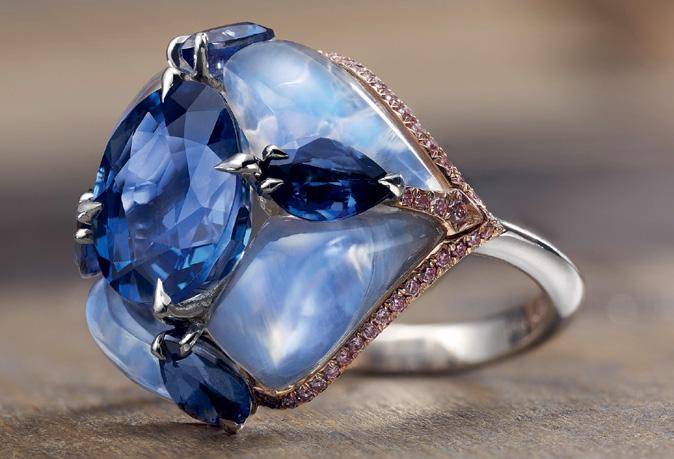
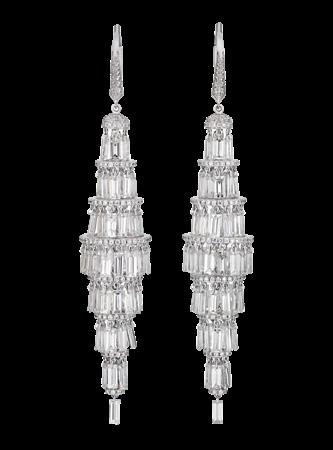
A/ M.S.RAU JEWELS Chandelier earrings
Un design con movimento, tanto classico quanto senza tempo, in oro bianco con un totale di 22.49 carati di diamanti.
A design based on movement,as classic as it is timeless,in white gold with a total of 22.49 carats of diamonds.
B/ TAFFIN Double ring
Tre opzioni per indossare questa creazione, un anello composto o due semplici, in oro rosa e platino con diamanti baguette che si incrociano.
Three options for wearing this creation,a combinable ring ortwosimpleones,inrosegoldandplatinumwithbaguette diamonds that intersect.
C/ SABBADINI Earrings
Una sofisticata onda tridimensionale è la chiave di questo gioiello con un difficilissimo micro pavé in oro bianco.
A sophisticated three-dimensional wave is the key to this jewel with a very difficult micro pavé set in white gold.
D/ BOOCHIER Nostalgia Letter Charms
Ispirate alle tipografie degli anni 80, il brand propone queste iniziali in oro giallo con ombre di colori diversi. Inspired by the typographies of the 80’s, the brand offers these initials in yellow gold with shadows of different colors.
E/ ARTËMER Golden Radio ring
Come un anello sigillo moderno, molto casual per tutti i giorni. Sei linee di diamanti baguette illuminano la mano. Likeamodernsignetring,verycasualforeveryday.Sixlines of baguette diamonds will light up your hand.






La tradizione vorrebbe confinare i gioielli con perle nel regno rarefatto di quei “classici che non possono mancare nel portagioie di una donna” - talmente classici da dovere e potere essere sfoggiati solo in occasioni importanti e con l’outfit “giusto”: Yana Nesper, invece, li proietta verso orizzonti del tutto differenti. Innovativi, trasformabili, originali, i gioielli di questo brand tedesco che porta il nome della sua fondatrice sono concepiti, studiati e realizzati per un’eleganza quotidiana e per esprimere con naturalezza la personalità di ogni donna. «I nostri gioielli non sono fatti per essere tenuti in cassaforte o per essere indossati due o tre volte all’anno - conferma Yana - Le perle, in special modo quelle bianche giapponesi Akoya o le australiane South Sea, si adattano facilmente a qualsiasi outfit e colore e io invito sempre i nostri clienti ad abbinarle a un abbigliamento casual, anche a jeans e maglietta: si faranno notare e renderanno chic qualsiasi look! Inoltre, la principale caratteristica di quasi tutti i nostri pezzi è che possono essere indossati in modi diversi, ogni volta trasformandosi e cambiando aspetto». È il caso, per esempio, della collana LOVE, che lo scorso Febbraio, in occasione degli Inhorgenta Award, è valsa al brand il titolo di “Designer of the Year”: un gioiello dal look minimal che può essere indossato in tre modi diversi, a choker o come collana lunga, andando a formare le lettere O oppure V (quelle centrali del suo stesso nome), impreziosito da una splendida perla South Sea. Le perle sono da sempre al centro delle attività della famiglia Nesper: oltre mezzo secolo fa Heinz Nesper fondò a Pforzheim il brand eponimo, e in breve lui e la moglie Ilse seppero conquistarsi un posto di rilievo tra gli importatori di perle di ogni varietà - Akoya, South Sea, Tahiti e Freshwater. All’inizio degli anni Novanta il figlio Frank, terminati gli studi in business administration, fece il suo ingresso in azienda. «Ci siamo incontrati e innamorati in quel periodo - ricorda Yana, nata in Ucraina, studi da pianista professionista - e dopo il matrimonio anche io ho cominciato a lavorare in azienda. Il mio amore per le perle e la gioielleria in generale è stato immediato, ho capito fin dal primo momento che quello era il mio posto e che il lavoro sarebbe diventato la mia grande passione. All’importazione delle perle è sempre stato affiancato un lavoro di design per i clienti che lo richiedevano, ma al tempo stesso abbiamo sempre avuto il desiderio di creare i nostri gioielli e quando ci siamo sentiti pronti, nel 2010, è nato il brand che porta il mio nome». Yana Nesper interpreta in chiave moderna e non convenzionale la gioielleria con perle: minimalismo,

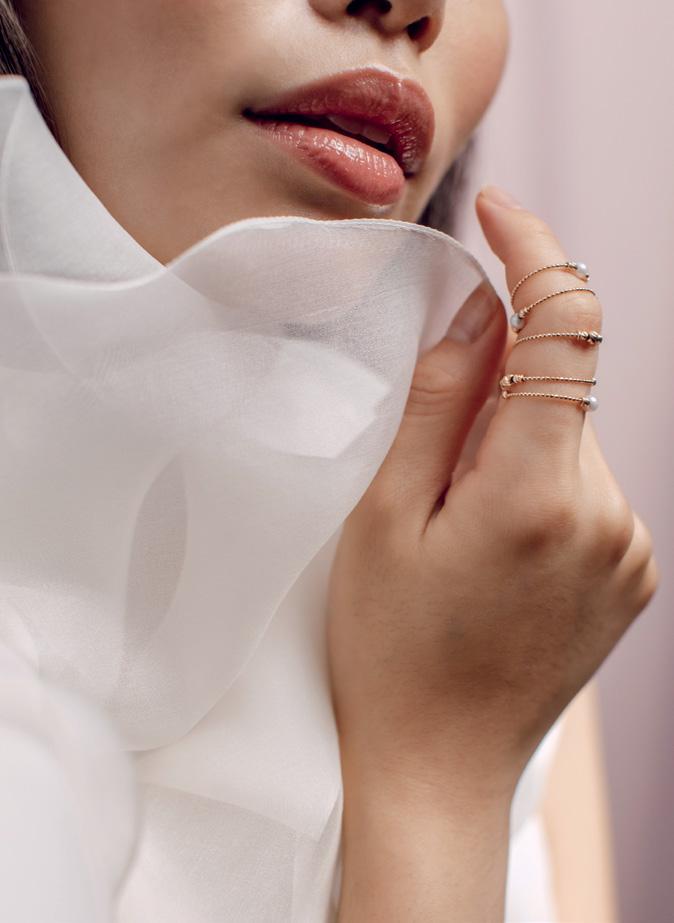
perle preziose selezionate individualmente, oro 18 carati, design moderni e originali sono i tratti distintivi del brand, che è parte della Heinz Nesper Jewellery House e che può ormai contare anche sulla terza generazione di famiglia con Yannick Nesper, approdato in azienda dopo la laurea in business administration. I gioielli Yana Nesper esaltano le perle in tutta la loro purezza e preziosità, evitando qualsiasi cliché estetico: dalla versatilità dei singoli articoli alle catenelle reggi-occhiali regolabili in lunghezza, dalle collane scomponibili in diversi bracciali alle perle che scorrono lungo le catene di collier e orecchini e possono essere fissate a qualsiasi altezza grazie a un ingegnoso meccanismo, tutto in questi gioielli parla di artigianalità con un originalissimo tocco contemporaneo. Nel corso della terza stagione di Emily in Paris - una delle serie Netflix più seguite e popolari di sempre - ne ha indossati diversi la protagonista Lily Collins, donando enorme visibilità al brand, che, già molto apprezzato in Europa, per il prossimo futuro ha l’obiettivo di espandere la propria presenza nel mercato US. «È davvero un momento di grande vitalità e ricco di soddisfazioni per la nostra impresa - continua Yana - che vogliamo far crescere anche oltreoceano con mirate strategie di sviluppo. Anche se, come designer, devo dire che per me la gioia più grande resta il pensiero che tante donne abbiano eletto i miei gioielli a loro accessorio del cuore e che ne abbiano fatto una sorta di amuleto che le accompagna nelle loro attività di tutti i giorni!».

Far removed from traditional aesthetic clichés,the jewelry of this German brand gives pearls a modern and sophisticated new feel
Tradition would have it that pearl jewellery be confined to that rarefied realm of“classics that must be found in any woman’s jewellery box”.So classical that theycouldandshouldonlybeshownoffonimportant occasions and together with the “right” outfit. For Yana Nesper, however, pearls are to be celebrated on a daily basis. Innovative, transformable, and original, all jewellery pieces of this German luxury brand are designed by Yana herself. The brand YANA NESPER bears the name of its founder and her designs are crafted for everyday elegance and aim to express any woman’s personality in a completely natural way.“Our jewellery is not designed to be kept in a safe or worn just a couple of times a year,” Yana confirms.“Pearls, especially white Japanese Akoya or Australian South Sea pearls, easily adapt to any outfit and colour, and I always encourage our customers to pair them with casual looks. This makes them stand out so that even jeans and a T-shirt look chic! The most important feature of almost all of our pieces is that they can be worn in different ways, transforming and changing the look of each piece when worn differently”.This is the case,for example,with one of the signature pieces of the brand, the LOVE collier. The necklace won the “Designer of the Year”award at the Inhorgenta show awardsinFebruary.Itisaminimalistpieceofjewellery that can be worn in three different ways: as a choker or as a long necklace, forming the letters O or V (the central letters of its name), embellished with a beautiful South Sea pearl.
Pearls have always been central to the Nesper family’s business activities: Heinz Nesper founded the eponymous brand in Pforzheim over 50 years ago and he and his wife Ilse quickly established themselves


among the leading importers of all varieties of pearls - Akoya, South Sea, Tahitian and Freshwater. In the early 1990s their son Frank joined the company after completing his studies in business administration.“We met and fell in love in that period,”recalls Yana,who was born in Ukraine and studied as a professional pianist,“andafterwegotmarriedIalsostartedworking for the company. I quickly developed a real love for pearls and jewellery in general; I knew right away that this was where I belonged and that my work would become my greatest passion.In addition to importing pearls we always carried out design work for clients who requested it,but at the same time we always had a desire to create our own jewellery and when we finally felt the time was right we launched the YANA NESPER brand in 2010”. YANA NESPER interprets pearl jewellery in a modern and unconventional way: minimalism, the use of hand-selected precious cultured pearls,18-carat gold and modern designs are the hallmarks of the brand which is part of the Heinz Nesper Jewellery House.
The firm now also counts on the contribution of the third generation of the family with Yannick Nesper having joined the company after graduating from university in Business Administration. Yana Nesper’s jewelry showcases the purity and preciousness of pearls while avoiding all aesthetic clichés: from the
versatility of the individual items to the adjustable glasseschains,fromnecklacesthatcanbetransformed into different bracelets to the pearls that slide along the chains of chokers and earrings and can be fixed at any height thanks to an ingenious mechanism, every detail about her pieces exude a highly original touch of modernity.
In the third season of “Emily in Paris” - one of the most watched and popular Netflix series ever - lead character Lily Collins wore several Yana Nesper pieces,giving enormous visibility to the brand which, already very popular in Europe, for the near future aims to expand its presence in the US market.“This is a really vibrant and exciting time for our business,” Yana continues,“which we also want to grow overseas with targeted development strategies. However, as a designer, for me the greatest joy is knowing just how many women have made my items of jewellery their go-to accessories, turning them almost into kinds of amulets that accompany them during their everyday activities!”.
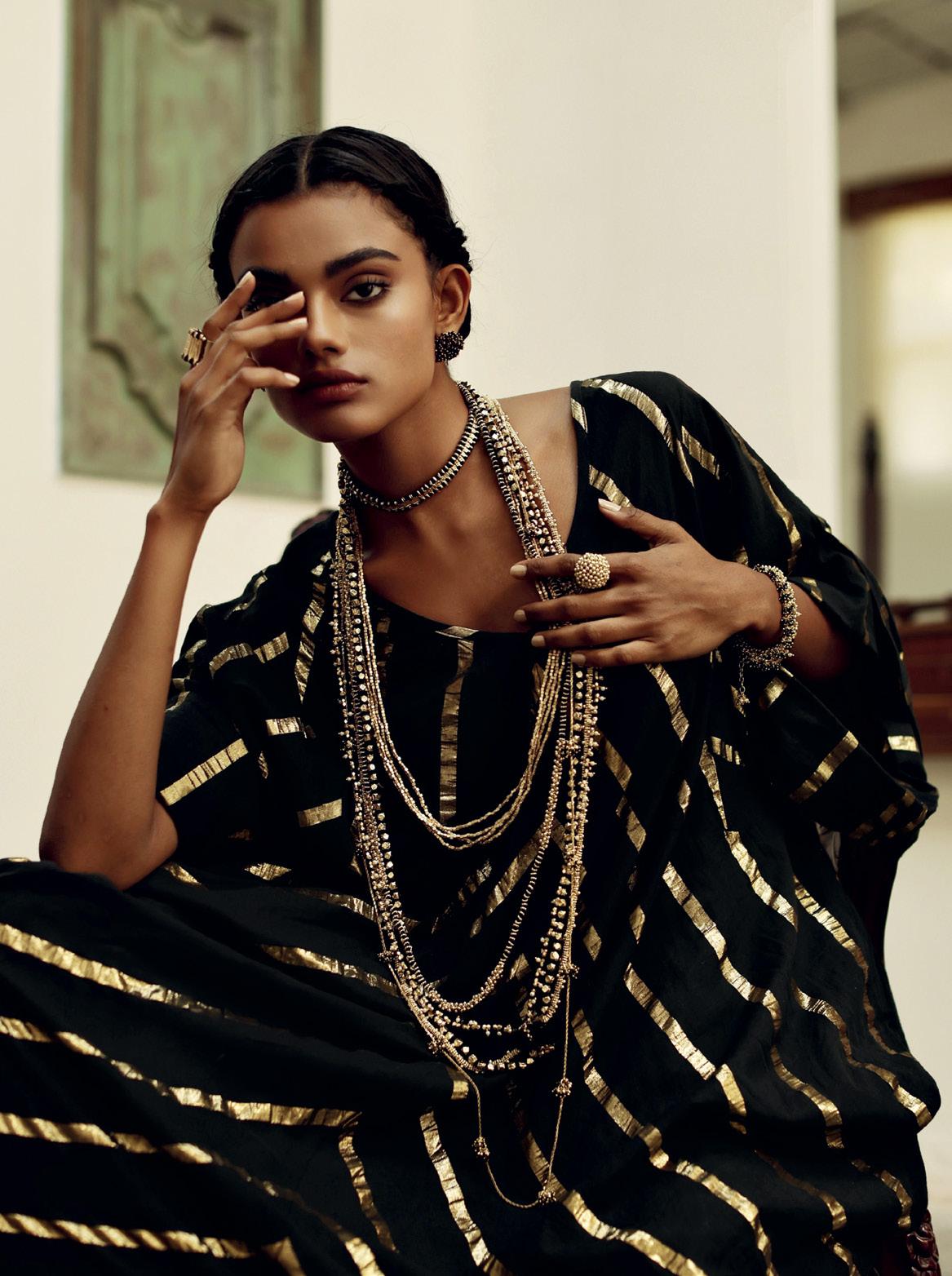
ISPIRATI ALLE ANTICHISSIME TRADIZIONI ARTIGIANALI

E ORAFE DELL’INDIA, I GIOIELLI DI HOUSE OF TUHINA
SONO REALIZZATI DA DONNE CHE NON AVEVANO
IMPIEGO,
LAVORO “TAILOR MADE”
Da lei, cresciuta in una famiglia indiana di medici, ci si aspettava che intraprendesse la medesima professione, solida e rispettata: invece Tuhina Goyal ha provato fin da giovanissima un grande, innato amore per il design di gioielli e ha tenacemente perseguito questa passione. Dopo la laurea in design tessile e abbigliamento presso il prestigioso National Institute of Design (NID) di Dehli, si è catapultata a Londra per specializzarsi nella creazione di gioielli e in strategie di sviluppo industriale. Ma ciò che rende unica l’esperienza di Tuhina non è solo il suo occhio per la qualità e l’estetica delle creazioni, quanto la convinzione che «si cresce solamente insieme agli altri»: per lei la questione fondamentale non è solo realizzare gioielli dal gusto e dal design unici, ma incoraggiare, rafforzare ed emancipare le persone intorno a sé. Così, più di dieci anni fa, ha fondato il suo brand House of Tuhina: nei suoi laboratori i gioielli, ispirati alla millenaria cultura e all’artigianato dell’India, sono realizzati da donne prima disoccupate alle quali vengono insegnate le tradizionali tecniche di lavorazione del Paese e garantite condizioni di lavoro “tailor-made”. Un aspetto, questo, di particolare importanza nella società indiana, all’interno della quale le donne disoccupate provenienti da famiglie a basso reddito devono spesso affrontare sacrifici incredibili per la loro sopravvivenza e quella dei loro cari, e quelle che entrano nel mondo del lavoro devono comunque continuare a svolgere a pieno titolo le funzioni di madri, mogli, figli e nuore: una mole di lavoro che rende loro praticamente
impossibile un impiego a tempo pieno che sia remunerativo e al tempo stesso gratificante a livello di crescita personale. «Nel 2012racconta Tuhina - ho capito che era finalmente giunto il momento di mettermi alla prova e di testare le reazioni del mercato. Praticamente ho cominciato nel seminterrato di casa, dove realizzavo personalmente i gioielli che avevo disegnato per poi esporli e promuoverli a livello locale. Un inizio modesto, che però ben presto ha portato a risultati straordinari: i miei gioielli piacevano moltissimo e ben presto la domanda ha cominciato a crescere oltre le aspettative, tanto che a un certo punto ho cominciato a non potervi fare fronte perché non avevo artigiani che potessero aiutarmi nella produzione». La svolta, come spesso accade, è giunta per caso: proprio in quel periodo due donne del posto, Bina e Babita, si sono proposte a Tuhina per svolgere lavori domestici: lei le ha invece convinte ad affiancarla nella sua impresa, adottando un approccio diretto e pratico: «Ho subito reindirizzato Bina e Babita a un lavoro creativo e full-time ma mi sono resa conto che i loro impegni in famiglia, in particolare l’obbligo di rientrare a casa in determinati orari per adempiere a responsabilità domestiche, era un ostacolo di non poco conto. Una volta messe a fuoco queste problematiche, ho studiato un programma di lavoro su misura per le loro esigenze e il loro benessere: orario di lavoro flessibile e la scelta tra lavoro da casa o in laboratorio. Oggi Bina e Babita coordinano ciascuna un team di un centinaio di lavoratrici, tutte impiegate alle loro medesime condizioni!».
Le neoassunte, alle quali vengono richieste capacità di base nei lavori di cucito e filato, vanno incontro a un periodo di apprendistato di diversi mesi - affidate a tutor, motivate e seguite in ogni loro progresso - superato il quale sono in grado di realizzare gioielli che corrispondono agli stringenti standard qualitativi ed estetici di House of Tuhina, diventando membri permanenti dell’organizzazione.
Lavorati interamente a mano in leghe di metallo e cotone, smalti, vetro e pietre naturali, i gioielli di House of Tuhina mostrano chiaramente tutto l’amore e la profonda conoscenza di Tuhina Goyal per la cultura, l’artigianato tradizionale e l’arte orafa del proprio Paese, pur con un tocco contemporaneo che li rende appetibili anche per i mercati internazionali - oggi sono ampiamente rappresentati e richiesti negli USA e in Europa e in crescita anche in Medio Oriente e Australia - e apprezzati da una clientela femminile del tutto trasversale per provenienza, stili e fasce d’età. «In generale sono io a disegnare i pezzi - conclude Tuhina - ma può capitare, ed è già successo anche per alcuni nostri best seller internazionali, che alcuni modelli siano invece disegnati da qualcuna delle nostre artigiane, tra le vincitrici di uno dei concorsi di design che organizziamo in azienda con una certa frequenza. Il successo è sempre frutto di un lavoro condiviso e noi crediamo fermamente in quei valori di rispetto, empowerment, cultura e resilienza che, soli, garantiscono il benessere all’interno di una comunità».
The jewelry of this Indian brand is inspired by the ancient craftsmanship and goldsmithing traditions of the country: they are crafted by women who were unemployed, for whom tailor-made working conditions have been studied

Having grown up in an Indian family of doctors,Tuhina Goyal was expected to follow the same well-trodden and respected path. Yet, the pulse of her passion beat to a different rhythm - a profound and innate love for jewelry design. With determination as her compass, she embarked on an academic journey, earning her stripes in textile-apparel design from the illustrious National Institute of Design (NID) in Delhi and moving to London after her degree,where she honed her skills in jewelry design and business development strategies. What sets Tuhina apart isn’t just her keen eye for the exquisite quality and aesthetic of her pieces, but her core belief that“you grow when your people grow”.For Tuhina, what really matters is not only the design and creation of unique jewelry, it’s about lifting others up, empowering and emancipating those around her.It was withthisvisionthat,overadecadeago,shelaunchedher brand,House of Tuhina.Here,in her workshops,the rich tapestry of India’s ancient culture and craftsmanship comesaliveinthejewelrymadebythehandsofwomen who were once unemployed.These women are not only taught the traditional techniques of their homeland but arealsoprovidedwith“tailor-made”workingconditionsabeaconofhopeinasocietywhereunemployedwomen from low-income families have to endure profound sacrifices for the survival of their family and those entering the workforce often juggle an overwhelming
arrayofresponsibilities:mother,wife,childanddaughterin-law,a series of duties that make full-time work that is bothwell-paidandgratifyingintermsofpersonalgrowth nigh on impossible.“In 2012”,Tuhina reflects,“I felt the tugtochallengemyself,toseeifmycreationscouldstand the test of the market.My journey began in the humble confines of my basement, designing each piece and crafting it by hand,and slowly introducing them to the local scene.What started as a modest endeavor quickly spiraled into something remarkable. Demand for my designs surged,outpacing my capacity to produce them single-handedly”.As so often is the case,fate intervened whenBinaandBabita,twolocalwomenseekingdomestic work, crossed paths with Tuhina. Seizing the moment, and adopting a practical approach, Tuhina steered them towards a different destiny - joining her creative crusade. “I immediately redirected Bina and Babita towards a creative and full-time job but I recognized that their family obligations, specifically the imperative to return home within prescribed hours for domestic responsibilities, presented a challenge of no small importance. Therefore, I studied a work environment tailoredtotheircomfortandcircumstances,withflexible workinghoursandofferingthemtheoptiontoworkfrom home or in the workshop.Today,Bina and Babita both leadaclusterofaround100women,allflourishingunder thesameempoweringconditions!”.Theseartisans,armed


with basic skills in needle and thread handling,undergo a meticulous apprenticeship of several months. Under the watchful eyes of their encouraging and motivating tutors,they evolve,ready to produce jewelry that meets the stringent quality standards of House of Tuhina,thus becomingintegralmembersoftheorganization.Entirely made by hand in metal alloys and cotton,enamel,glass andnaturalstones,thecreationsbyHouseofTuhinaare a testament to Tuhina’s love and deep understanding of the culture, traditional craftsmanship and jewelry traditions of her homeland, with a modern flair that captivates a global audience.From the shores of the U.S. andEuropetotheexpandingmarketsoftheMiddleEast and Australia, her jewelry pieces are widely requested and appeal to a wide female clientele comprising women of completely different styles and ages.“I usually design our jewelry pieces myself”, Tuhina concludes, “But occasionally, designs are also picked up from our in-house creative design competition winners. Some of our international best-sellers have been designed by our artisans.Success,in our book,is a collective achievement, and we firmly believe in those values of mutual respect, empowerment, culture and resilience which, alone, ensurewell-beingwithinacommunity”.
 Nick Maltese is wearing a suit with peaked lapels and a cachemire-blend cannage sweater, DIOR. Custom-made glasses in natural horn, DEVERCELLI. Necklace, SWAROVSKI.
by Alberto Corrado
Nick Maltese is wearing a suit with peaked lapels and a cachemire-blend cannage sweater, DIOR. Custom-made glasses in natural horn, DEVERCELLI. Necklace, SWAROVSKI.
by Alberto Corrado
MATERIA E SENTIMENTO

Da due traiettorie diverse scaturisce l’identità culturale e progettuale di Nick Maltese Studio. Un redazionale racconta il loro linguaggio stilistico quanto mai articolato ed eclettico, mai banale
“NON CI ACCONTENTIAMO DI FARE PROGETTI CHE PIACCIONO,
NICK MALTESE E FEDE PAGETTI
Sarebbe buon dettame, ancor di più nell’attuale società dilagante di ego trip, evitare all’io dell’autore incursioni evidenti nella stesura di questo testo.
Eppure in questa specifica occasione non c’è altro modo di affrontare la trattazione, perché Nick Maltese Studio, società di progettazione vocata principalmente all’architettura d’interni del mondo dell’hospitality, ma che spazia anche nel settore del residenziale e degli allestimenti, è un progetto nel quale sono stato personalmente coinvolto varie volte fin dall’inizio, per quella concretezza e sensibilità di approccio vincente di due menti creative antitetiche, meglio complementari.
Ho conosciuto Nick Maltese, figlio della Magna Grecia, e Fede Pagetti, lombardo purosangue, nel 2021, quando le due traiettorie professionali hanno fatto scaturire l’identità culturale progettuale dello studio, per creare quel linguaggio stilistico, quanto mai articolato ed eclettico, mai scontato, capace di dare una risposta ad ogni tipo di esigenza.
Per questa loro vita professionale appassionante, gli proposi di realizzare un progetto, perché ero affascinato da quel loro districarsi nel dialogo tra le mille texture, che attivano memorie e immaginazione, tra i colori declinati in una palette che mixa con efficacia il naturale e pittorico, grazie alla giustapposizione o alla contrapposizione di cromie piene e vivide, ora armoniche ora dissonanti in vista di dare corpo ad atmosfere sempre sensorialmente stimolanti e insieme rassicuranti. Loro accettarono. Le mie parole sarebbero state accompagnate da un servizio redazionale, realizzato con una serie di abiti dalle più prestigiose Maison de mode, dove Nick Maltese doveva posare senza tralasciare il suo carattere sulfureo ed istintivo, prototipo di una straripante e colta mediterraneità, mentre Fede Pagetti, riflessivo e immaginifico, espressione di una cultura fatta di concretezza e sensibilità dell’altro, mi confidò di desiderare una sola situazione creativa assieme al suo co-founder.
L’intento dietro questo progetto, che si dipana in parallelo, per immagini e pensieri scritti, è stato di creare un parallelo, sottile ma palpabi-
le, tra le due personalità e nell’esplorare quella intricata relazione tra il designer che crea luoghi e oggetti e chi ne usufruisce. Basta pensare a quel linguaggio stilistico quanto mai articolato ed eclettico rappresentato nella creatività di alberghi d’eccezione come il Didimos di Salina con i suoi accenti picassiani o il LAdimora di Ferrara dove a dominare sono le tinte della Padania, o al dialogo tra diverse luminosità nei ristoranti come il Basho e L’Otium a Milano e l’Aqua a Reggio Calabria, in cui si avverte l’influenza di Nanda Vigo e James Turrell, fino alle forme fluide e ai colori e alle luci pop dei bar come Bella, Breaddy, Tema e Dirty, locale irriverente e scorretto di Milano, aperto fino alle 4 del mattino, vincitore Premio Bar Rivelazione dell’Anno al Barawards 2023. Tempo, desiderio e luce: ecco le tre variabili del loro gioco, specchio o amplificatore delle altre. La luce con cui i due designer costruiscono quella grande forza evocativa che hanno i club, e gli straordinari florilegi di invenzioni scenografiche nel campo della hotellerie, e qui merita una citazione d’onore il TRG - The Royal Garden Hotel a Milano.
“Nella nostra architettura d’interni la luce, quella naturale, ma soprattutto quella artificiale e regolabile nell’intensità e nelle cromie, gioca un ruolo preminente. Il buio non ci piace come nei quadri di Emilio Vedova, il fratello italiano di Jack Pollock,” dichiara Nick Maltese “a meno che, giocando sul contrasto, non acquisti una valenza narrativa ed emozionale”.
“La nostra non è mai, comunque, una luce utilitaristica che si limita ad illuminare e basta” prosegue Fede Pagetti “al contrario serve a connotare, a caratterizzare gli spazi: ne esalta le forme, fa brillare i colori che li popolano, contribuisce a dichiararne il sentimento e il significato”.
Un desiderio di svelare un rapporto intimo e viscerale con l’architettura e con i loro oggetti che hanno guidato il loro percorso e aiutato a superare le inevitabili difficoltà, prendendo tutto il tempo, perché ogni cosa fosse collocata al posto giusto.
Una declinazione dell’essere umano, che dà vita a una vivace incoerenza estetica ed espres-
siva, intesa come possibilità di esercitare un pensiero libero, di sfuggire alla omologazione e all’inumanità, attraverso una sagace e ironica applicazione dell’arte della contraddizione. Oppure, con le relative differenze caratteriali, nella dedizione di quella poetica di frammentazione-contrasto-ricomposizione che trova la sua sintesi espressiva nel concetto di complessità, rielaborando la lezione del Futurismo e dei Cubisti. E ancora lemmi come opulenza, irriverenza, contaminazione, linearismo, che rimandano al Barocco e al Pop, alle vibrazioni energetiche del Rock, alla ruvidezza garbata dell’Industrial Style e dell’Underground, alle esuberanze del Massimalismo, alla sofisticazione del Minimalismo.
«In assoluto nulla è standardizzato» spiega Fede Pagetti «In realtà non avere uno stile codificato credo sia uno dei nostri principali pregi. Per questo potrei aggiungere che il nostro universo è quello di scoprire il mondo e tradurlo nella conoscenza, in idee».
«I nostri interventi hanno a che fare con la storia dei luoghi, con le emozioni di chi vivrà gli spazi» conclude Nick Maltese. «Anche perché entrambi abbiamo un “animus poetico”, non meramente materialistico. In realtà la poesia non la ricerchiamo espressamente, piuttosto scaturisce spontaneamente dall’incrocio delle tante discipline che ci appassionano. Ma soprattutto dalle dicotomie concettuali che innervano il nostro linguaggio architettonico: contrasto/armonia, pieno/vuoto, eccesso/rarefazione, imperfezione/accuratezza, scomposizione/ricomposizione, decadenza/riscatto, linearismo/opulenza, irriverenza/rispetto».
Per lo scrivente, invece, le emozioni più forti sono nate nella conversazione con Nick Maltese e Fede Pagetti, nella scoperta del loro viscerale attaccamento a mettere in scena segni e situazioni che attraggono emotivamente le persone, suscitando il desiderio di entrare e scoprire la vera essenza di quel luogo.
Un aggrovigliamento sentimentale e materiale che, da solo, è la perfetta sinossi di Nick Maltese Studio, dello sviluppo di tempo e memoria, materia e sentimento che la loro estetica in ultimo descrive.
 Kimono suit, MORDECAI.
Kimono suit, MORDECAI.

 Relaxed pants made of enamel linen, fluid viscose and cotton yarn knit, and flip-flop sandal with matte calfskin band and titanium detail, FERRAGAMO. CUTLER AND GROSS Glasses.
Relaxed pants made of enamel linen, fluid viscose and cotton yarn knit, and flip-flop sandal with matte calfskin band and titanium detail, FERRAGAMO. CUTLER AND GROSS Glasses.

 Cotton overall with buttons, ISSEY MIYAKE. Cotton shirt and tie, FERRAGAMO. Cashmere pence pants, LOROPIANA. Boots, NEIL BARRETT. AKONI Glasses.
Cotton overall with buttons, ISSEY MIYAKE. Cotton shirt and tie, FERRAGAMO. Cashmere pence pants, LOROPIANA. Boots, NEIL BARRETT. AKONI Glasses.
 Double-breasted viscose and stretch wool gabardine jacket with contrasting details and wide-leg pants, MOSCHINO. Vintage ‘70s Glasses.
Double-breasted viscose and stretch wool gabardine jacket with contrasting details and wide-leg pants, MOSCHINO. Vintage ‘70s Glasses.
Two different trajectories give rise to the cultural and design identity of Nick Maltese Studio.An editorial narrates their stylistic language,as complex and eclectic as ever,never trite
“We do not settle for just making projects that people like,we want our spaces and our projects to say something, that there be a story behind every single choice”.
Nick Maltese and Fede Pagetti
It would be good etiquette, even more so in today’s rampantly ego-tripping society, to prevent the author’s self from making any blatant forays in the writing of this text. However, in this specific case, there is no other way to approach the subject, because Nick Maltese Studio,a design firm dedicated mainly to interior architecture in the world of hospitality but that also operates in the residential and fit-out sectors,is a project in which I have been personally involved several times since the very beginning,due to that pragmatism and sensibility of winning approach of two contrasting, or better yet complementary,creative minds.
I met Nick Maltese,a son of the Magna Graecia,and Fede Pagetti,a full-blooded Lombard,in 2021,when thetwoprofessionalpathssparkedthefirm’scultural design identity to create that stylistic language, as complex and eclectic as ever, never predictable, capable of providing an answer to all kinds of needs. Due to their enthralling professional life, I asked them to carry out a project, as I was intrigued by their unraveling in the dialogue among thousands

of textures, which trigger memories and the imagination,amongcolorsdisplayedinapalettethat efficiently combines the natural and the pictorial, thanks to the superimposition or juxtaposition of full and vivid hues, at times harmonious and at other times discordant in order to give substance to atmospheres that always manage to stimulate the senses while reassuring at the same time. They accepted. My words would be accompanied by an editorial shoot,featuring a series of outfits from the most prestigious fashion houses,where Nick Maltese was to pose without forsaking his sulfurous and instinctive personality, prototype of an overflowing and educated Mediterranean-ness, while Fede Pagetti, thoughtful and imaginative, an expression of a culture made up of pragmatism and sensibility towardsothers,confidedtomethathewishedforonly one creative situation together with his co-founder. The intention behind this project, which unfolds in parallel by way of images and written thoughts,was to create a subtle yet tangible comparison between the two personalities and explore that intricate relationship between the designer who creates places and objects and the people who make use of them. One only has to think of the extremely complex and eclectic stylistic language represented in the creativity of exceptional hotels such as the Didimos in Salina, with its Picasso-like overtones, or the LAdimora in Ferrara, dominated by the hues of Padania, or the dialogue between the different luminosities in restaurants such as Basho and Otium in Milan and Aqua in Reggio Calabria, where the influence of Nanda Vigo and James Turrell can be felt,to the fluid forms and Pop Art colors and lights of bars such as Bella, Breaddy, Tema, and Dirty, an impertinent and anomalous venue in Milan, open until 4 am,winner of the Bar Revelation of the Year Award at Barawards 2023. Time, desire and light: these are the three variables of their game, mirror or amplifier of the others. The light with which the two designers create that strong evocative power that night clubs have, and the extraordinary florals of scenic inventions in the hôtellerie sector,and here the TRG - The Royal Garden Hotel in Milan deserves honorable mention.
“In our interior architecture, light, the natural kind, but above all artificial light, which can be adjusted in terms of intensity and color, plays a major role. We do not like darkness as in the paintings by Emilio Vedova, Jack Pollock’s Italian brother” Nick Maltese says,“unless, by playing with contrast, it takes on a narrative and emotional meaning”.
“In any case, ours is never a utilitarian light that merely illuminates and nothing more” continues Fede Pagetti “On the contrary, our light is used to
distinguish, to characterize spaces: it emphasizes their form, makes the colors that inhabit them sparkle, and helps to declare their emotion and meaning”.
A desire to reveal an intimate and visceral relationship with the architecture and the objects that have guided their professional journey and helped them overcome the inevitable challenges, taking all the time that was needed, so that everything would be placed in the right spot.A facet of the human being that breathes life into a lively aesthetic and expressive incoherence, understood as the possibility to exercise free thinking,to escape standardization and inhumanity, through a shrewd and ironic application of the art of contradiction.Or, with the relative differences in their personalities, in the devotion of that poetics of fragmentationcontrast-reassembly that finds its expressive synthesis in the concept of complexity, reprocessing the lessons of Futurism and of the Cubists.
And again, terms such as opulence, irreverence, contamination, linearism, which refer to Baroque and Pop, the high-energy vibrations of Rock music, the polite roughness of the Industrial Style and the Underground, the flamboyance of Maximalism, the sophistication of Minimalism. «Absolutely nothing is standardized.» as Fede Pagetti explains «In fact, I believe that not having a codified style is one of our main assets. That’s why I could add that our universe is to discover the world and translate it into knowledge and ideas».
«Ourdesignsdealwiththehistoryofplaces,withthe emotionsofthosewhowillbelivingthem»concludes Nick Maltese.«Also because we both have an“animus poetico”, not merely a materialistic one. Indeed, we do not explicitly seek poetry, rather it emerges spontaneously from the intersection of the many disciplines that we are passionate about. But above all, from the conceptual dichotomies that energize our architectural language: contrast/harmony, full/ empty, excess/rarefaction, imperfection/precision, disassembly/reassembly, decadence/redemption, linearism/opulence,irreverence/respect».
For the writer, on the other hand, the strongest emotions originated from the conversation with Nick Maltese and Fede Pagetti, in the discovery of their primordial devotion to staging signs and situations that emotionally appeal to people, sparking the desire to enter and discover the true essence of that place.An emotional and materialistic entanglement that, by itself, is the perfect synopsis of Nick Maltese Studio, of the development of time and remembrance, matter and emotion that their aesthetics ultimately describes.
 by Rosa Chiesa
by Rosa Chiesa
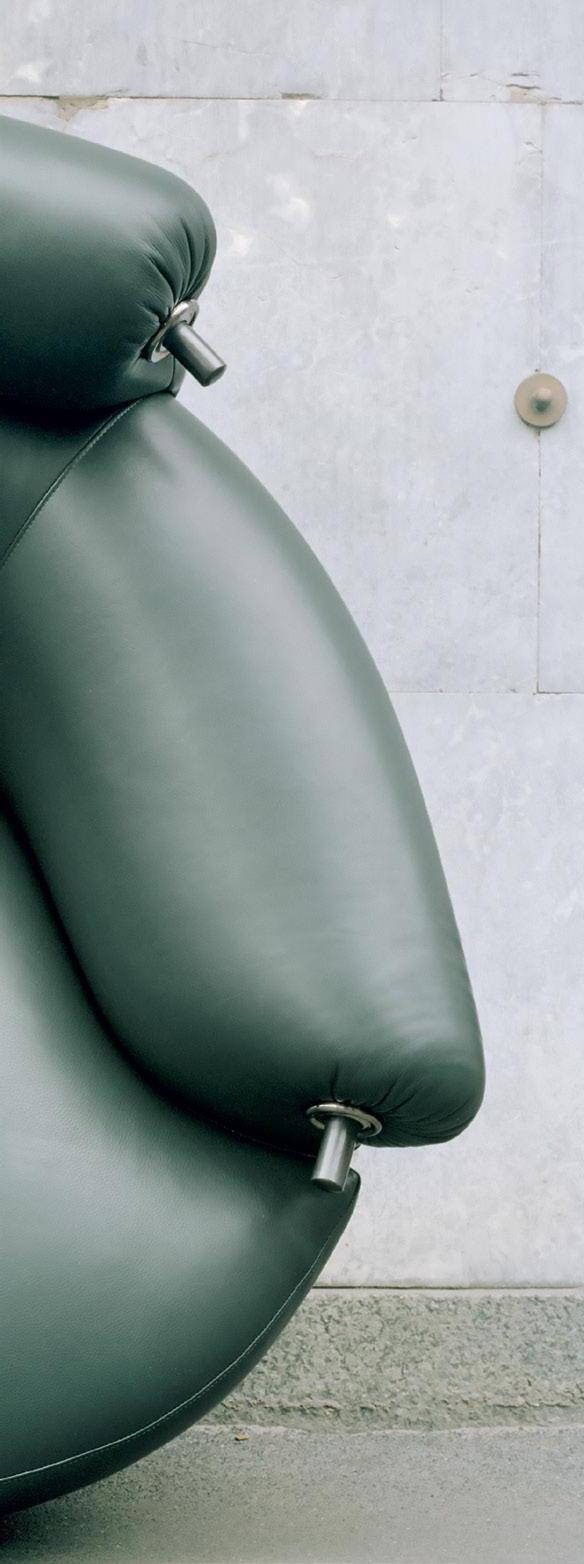
ZINGARA DELL’OPERA TEATRALE
VERDIANA TROVATORE IL
DELL’AZIENDA
FONDATO NEL 1947 DAGLI
ARCHITETTI LUIGI CACCIA
DOMINIONI, IGNAZIO GARDELLA E CORRADO CORRADI
DELL’ACQUA, ALCUNI TRA I PIÙ
IMPORTANTI PROTAGONISTI
ITALIANI DEL DESIGN E DELL’ARCHITETTURA DEL DOPOGUERRA


Luigi Caccia Dominioni, architetto e designer, spicca come vivace interprete della tradizione milanese e lombarda ma anche come progettista sensibile nella ridefinizione del rapporto tra modernità e tradizione a tutte le scale, dal livello urbano (in particolare a Milano) alla scala dell’oggetto. La poltrona Catilina (1957) è, tra gli oggetti di design, un progetto certamente emblematico della suddetta attitudine del progettista a innovare mantenendo fermo il riferimento alla tradizione. Il contesto italiano del primo dopoguerra in cui Azucena si inserisce è già caratterizzato dalla presenza di aziende che, impegnate nel trovare risposte per un numero crescente di acquirenti, mantengono una produzione ibrida, artigianale e semimeccanizzata, spesso sperimentale, dove convivono armoniosamente le piccole serie o i pezzi unici “artistici” e le produzione seriali che si avviano a produzioni di tipo industriale. Azucena nasce dall’esigenza di produrre e mettere in commercio (attraverso un proprio punto vendita) arredi e complementi nati, originariamente, come pezzi site specific per arredare gli interni di edifici progettati dagli stessi fondatori. Si tratta di design di piccole serie, da cui vengono selezionati solo alcuni elementi e fatti realizzare da maestranze specializzate. Frutto di un connubio armonioso tra maestria artigianale e sistema industrializzato, il processo di design di Azucena si fonda sulla selezione qualitativa dei materiali (poveri e pregiati), dai marmi agli ottoni, e sulle sperimentazioni e innovazioni tecnologiche su materiali e superfici. Azucena rappresenta dunque una delle aziende che concorrono felicemente alla creazione del “sistema design italiano”, mostrando come il radicamento al territorio e il ruolo della componente artigianale siano stati fondanti nella costruzione di una disciplina progettuale, il design, più largamente conosciuta dagli anni Cinquanta. Non a caso proprio a Luigi Caccia Dominioni è stato riconosciuto il Compasso d’Oro alla carriera (2008) per il suo “contributo oggettivo alla definizione stessa di cosa sia il design italiano e dell’originalità dei suoi contenuti”. Dall’ottobre 2018 il Gruppo B&B Italia – quest’ultimo marchio storico italiano fondato nel 1966 da Piero Ambrogio Busnelli, e da dicembre 2018 parte di Design Holding – ha siglato un accordo con gli eredi di Luigi Caccia Dominioni per produrre e distribuire in licenza esclusiva una riedizione di 20 prodotti disegnati da Luigi Caccia Dominioni. I prodotti Azucena tornati in commercio – alcune tra le icone del design italiano – esprimono appieno i tratti tipici di tutta la produzione aziendale: la padronanza del linguaggio formale, l’eleganza misurata e la raffinatezza mai scissa dal contenuto tecnologico e dalla funzionalità. La sedia Catilina (1957), per esempio, sintetizza un approccio che nella pulizia delle linee si apparenta alla lezione razionalista, allontanandosene però per sposare un recupero storicistico della tipologia romana

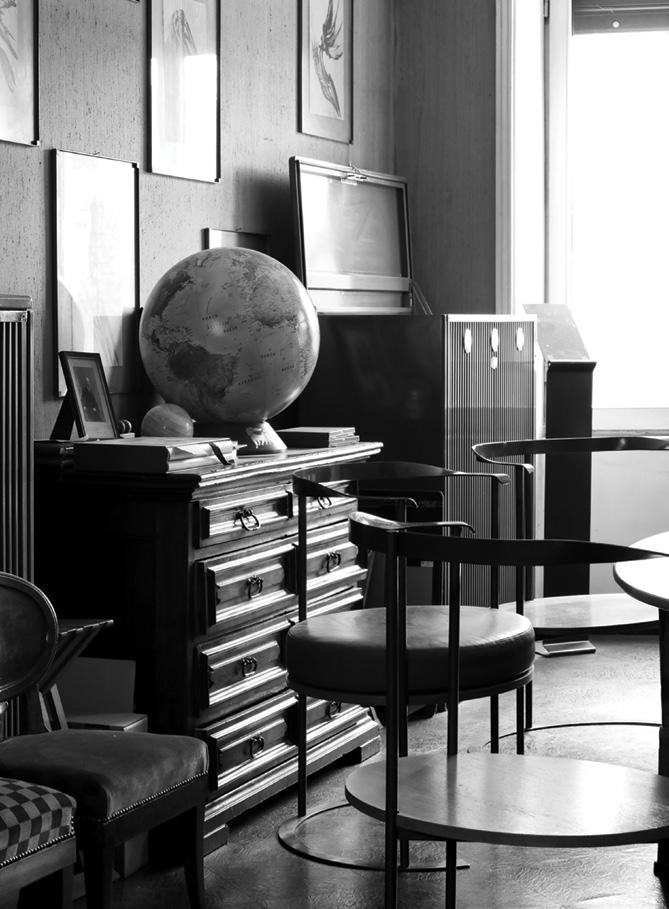
“a pozzetto” della seduta. La struttura realizzata in ferro, verniciato a fuoco, mostra la predilezione per un materiale “povero” ma potentemente espressivo: rievocando le ringhiere delle case popolari milanesi, la piattina in ferro, gentilmente curvata come fosse un nastro, funge da schienale e iconico bracciolo.
Realizzati per le sale del Club House di Monticello, il divano e la poltrona Toro (1973) sono oggetti ‘protagonisti’ che possono vivere anche al centro di una stanza e che, grazie ai terminali della struttura metallica che fuoriescono dall’imbottitura, possono essere agevolmente sistemati in diverse posizioni, configurando spazi interni flessibili.
Una parte della produzione di Caccia Dominioni esprime una riflessione sulla semplicità e sugli elementi archetipi: dalla rivisitazione delle forme dei classici arredi dei giardini italiani, ma anche dalla rilettura di affreschi dell’antica Roma o di pitture rinascimentali, nascono le sedute Nonaro (1959-1961) realizzate per i visitatori della Pinacoteca Ambrosiana; oggi declinata
in versione outdoor, la collezione rappresenta la sintesi dell’incontro tra design, arte e storia, filtrata ancora una volta dai ricordi della villa familiare del progettista.
Evocazione della seduta per eccellenza, la poltrona – e oggi divano – ABCD (1960) propone un oggetto tradizionale connotato però da dettagli che lo rendono ben riconoscibile: dal piedino anteriore – quasi una miniaturizzazione di un elemento architettonico – che ospita la ruota, alla gentile curvatura terminale dello schienale imbottito e al motivo decorativo, al contempo funzionale, creato dalla sequenza delle borchie che fissano il rivestimento.
Essenzialità e purezza sono invece il registro usato nel disegno del tavolo – e oggi anche nei tavolini – Cavalletto (1947), memoria degli anni di studio trascorsi al Politecnico di Milano, distillata attraverso la sofisticazione dei dettagli e da un intento minimalista che eleva l’oggetto ad astrazione, ad archetipo del “buon design”.
A volte però nella produzione dell’architetto designer ci si imbatte in un guizzo, un’originalità
sempre misurata, come accade per lo spiazzante gioco di scale e proporzioni che caratterizza la seduta Chinotto (1973), una piccola poltrona informale, adatta a qualsiasi ambiente, che lascia spazio a una comodità inattesa.
O la semplice ma geniale lampada Poltrona (1979), da alloggiare sullo schienale di imbottiti o sulle testate dei letti, composta da una fascia in pelle, tenuta in posizione dai pesi inseriti nelle due estremità, che ospita un riflettore orientabile e un interruttore.
Tra le lampade però il tratto caratteristico, che connota anche il lavoro di altri noti architetti a lui coevi, è una chiara propensione verso la semplicità e la geometrizzazione delle forme; accade con Base Ghisa e Monachella (1953) entrambe estremamente funzionali ed eleganti, o nella lampada Imbuto (1953), rivisitazione della famosa tipologia del luminator, ma anche evocazione di un design anonimo presente in tutti gli interni domestici.
Eleganza mai ostentata, affetto per quegli oggetti che compongono il panorama domestico e sguardo vivace del progettista sono alcuni tra gli ingredienti che rendono i pezzi Azucena contemporanei e insensibili allo scorrere del tempo.
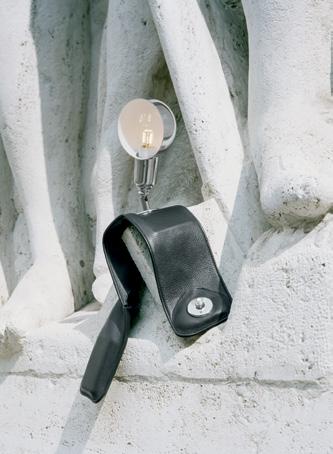
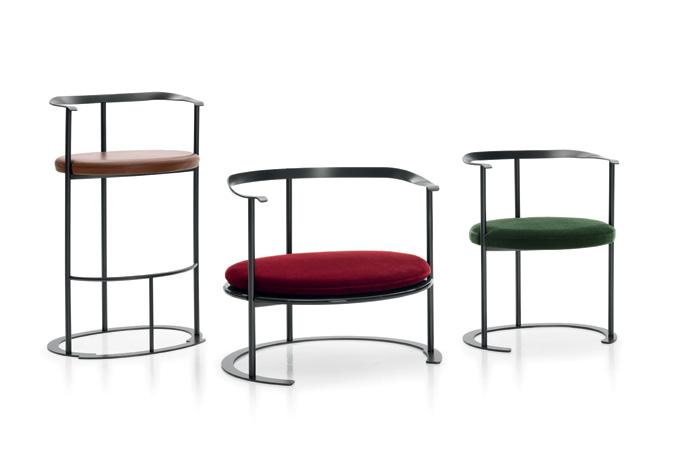

The name of the company Azucena,a historic Italian brand founded in 1947 by architects Luigi Caccia Dominioni,Ignazio Gardella and Corrado Corradi
Dell’Acqua,among the leading protagonists of the Italian postwar design and architecture scene,was taken from the famous gypsy woman from Verdi’s opera Il Trovatore
Luigi Caccia Dominioni,architect,designer and urban planner, stood out as a vibrant interpreter of the Milanese and Lombard tradition but also as a sensitive designerinhisredefinitionoftherelationshipbetween modernity and tradition at all scales, from the urban level (particularly in Milan) to the object. Among his designobjects,theCatilinaarmchair(1957)iscertainly emblematic of his aforementioned aptitude for innovation while paying tribute to tradition.
TheItalyoftheearlypostwarperiodinwhichAzucena wasfoundedwasalreadycharacterizedbythepresence of companies which, seeking to finding solutions for a growing number of buyers, maintained a hybrid, artisanal, semi-mechanised and often experimental production process in which limited series or“artistic” one-off pieces coexisted in harmony with serial products that were soon to be mass produced. Azucenawasbornfromaneedtoproduceandmarket (through its own outlet) furniture and accessories that wereoriginallycreatedassite-specificpiecestofurnish the interiors of buildings designed by the founders themselves. Limited edition designs, from which only a few elements were selected and made by skilled workers. The result of a harmonious combination of craftsmanship and mass production, Azucena’s design process was based on its selection of quality materials(humbleandfine),frommarbletobrass,and on experimentation and technological innovations on materials and surfaces.
Azucena therefore happily contributed to the creation of the “Italian design system,” showing how deep local roots and the role of craftsmanship were key elements in the construction of the design discipline, which grew as a concept from the 1950s onwards. It is no coincidence that Luigi Caccia Dominioni was awarded the Compasso d’Oro Lifetime Achievement Award (2008) for his “objective contribution to the very definition of Italian design and the originality of its products”. In October 2018, the B&B Italia Group - historic Italian brand founded in 1966 by Piero Ambrogio Busnelli and part of Design Holding since 2018 - signed an agreement with the heirs of Luigi Caccia Dominioni to produce and distribute, exclusively under license, re-editions of 20 products designed by Luigi Caccia Dominioni.

The Azucena products that have returned to the market - some of which icons of Italian design - fully express the typical traits of the company’s products: mastery of formal language, understated elegance and a sophistication that can never be separated from technological content and functionality.
tables - which recall the years he spent studying at Milan Polytechnic, conveyed in the sophisticated details and by a minimalist intent that elevates the objecttoanabstraction,thearchetypeof“gooddesign”.
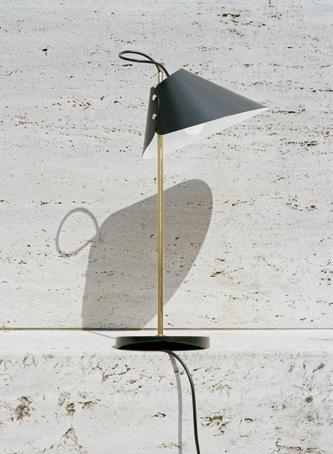
The Catilina chair (1957), for example, embodies an approach that takes its inspiration from Rationalism in the cleanliness of its lines while at the same time distancing itself from this style to revisit the Romanstyle tub chair. The frame in stove-enameled iron shows a predilection for a“poor”but highly expressive material: recalling the typical Milanese “case di ringhiera” (tenements with communal balcony), the ironplate,gentlycurvedasifitwerearibbon,servesas a backrest and iconic armrest.
Made for the halls of the Monticello Club House, the Toro sofa and armchair (1973) are‘prominent’objects thatalsositcomfortablyatthecenterofaroom.Thanks to the terminals of the metal frame which protrude from the padding,they can also be easily arranged in different positions to create flexible interior spaces.
Part of Caccia Dominioni’s portfolio expresses a reflection on simplicity and archetypal elements: from a revisitation of the forms of classic Italian garden furniture, but also from a reinterpretation of Ancient Roman frescoes or Renaissance paintings, come the Nonaro chairs (1959-1961), made for visitors to the Pinacoteca Ambrosiana; now available in an outdoor version,the collection embodies the meeting between design,artandhistory,filteredonceagainbymemories of the designer’s family villa.
Revisitation of the seat par excellence, the ABCD (1960) armchair - and now sofa - is a traditional object characterized by highly distinctive details: from the front foot - almost an architectural element in miniature-thathousesthecastor,tothegentlecurveat the end of the upholstered backrest and the decorative yet functional motif,created by the sequence of studs used to fasten the upholstery.
Meanwhile,simplicity and purity are the key concepts of the Cavalletto table (1947) - and today also coffee
Sometimes, however, you also come across a flicker of measured originality in the architect-designer’s catalogue, as is the case with the disorienting series of scales and proportions that characterize the Chinottoseat(1973),asmall,informalandsurprisingly comfortable armchair suitable for any setting.
Or the simple but ingenious Poltrona lamp (1979), to fit to the backrests of padded furniture or on the headboards of beds,consisting of a leather band,held in place by weights inserted at either end,that houses an adjustable spotlight and a switch.
However, the characteristic trait of the lamps, a feature also common to the work of other well-known contemporary architects, is the clear propensity for simple, geometric forms; this is the case with Base Ghisa and Monachella (1953), both extremely functional and elegant, as well as the Imbuto (1953), a revisitation of the famous luminator lamp but also an evocation of an anonymous design present in all domestic interiors.
Understated elegance, affection for the objects of the domestic landscape and the vibrant approach of the designer are some of the ingredients that keep Azucena’s pieces contemporary and impervious to the passage of time.

È UN OGGETTO DESUETO OGGI MA ONNIPRESENTE NELLE ‘CASE DELLA NONNA’, IL SERVOMUTO –QUELLO A CUI SI APPOGGIAVANO I PANTALONI E LA CAMICIA – MA, COME ESPRIME LA COLLEZIONE I WANNA BE YOUR DOG, STRETTAMENTE LEGATA AL MONDO “PUNK E HARDCORE”, ANCHE UN’IMMAGINE TRASFERIBILE A MONDI LONTANI
Nato nel 2010, il brand Servomuto rivisita il paralume tradizionale per farne un oggetto di sofisticata sperimentazione linguistica, attingendo al mondo dell’interior, e adottando un approccio quasi sartoriale.
La duplicità dei rimandi, cui il termine rinvia, riflette la natura “giocosa” del brand ma al contempo esplicita l’idea del connubio tra l’evocazione di un mondo di oggetti rassicuranti del passato e l’apertura ad altre interpretazioni, altri mondi, altri codici. Lo racconta efficacemente il logo: «una maschera sado-maso che ben contrasta con il mondo romantico e vezzoso del paralume» afferma Alessandro Poli, il suo fondatore. Attratto dal mondo dei colori e rapito dal fascino ‘maniacale’ per il dettaglio, Alessandro è leccese (barocco dunque) ma si forma come designer grafico allo I.E.D. di Milano. La molteplicità degli interessi del fondatore rappresenta il cuore e l’idea profonda di un brand che propone oggetti ibridi, di fattura interamente artigianale ma riattualizzati in chiave contemporanea.

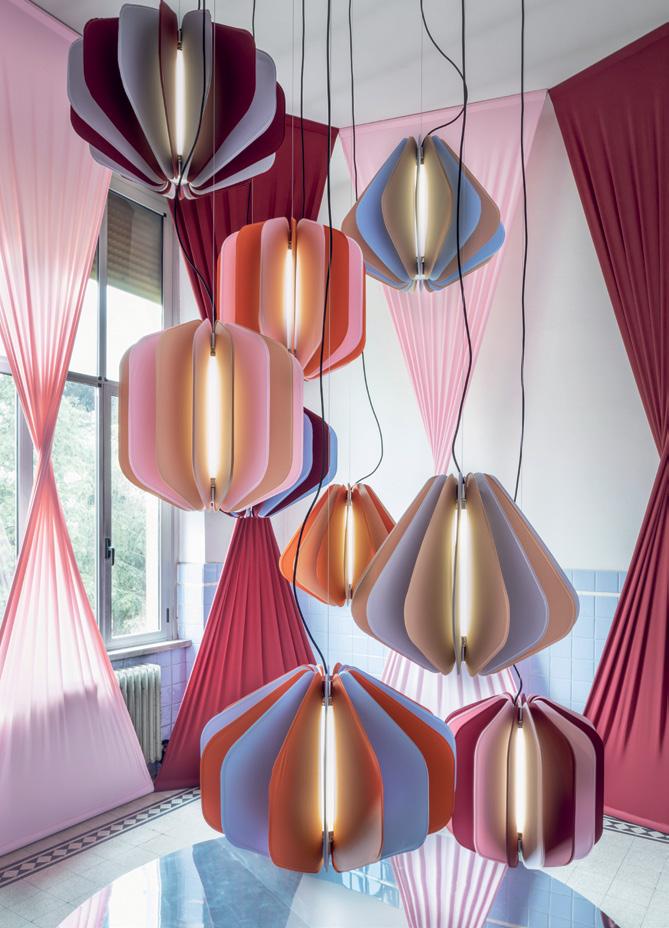
«Il design italiano è storicamente una fonte di ispirazione costante e continuativa» afferma Alessandro, citando maestri storici, da Aldo Rossi e Gio Ponti, da Albini a Sottsass e Castiglioni, e arrivando ai nutrienti confronti avuti con Rodolfo Dordoni. «Servomuto nasce in un periodo in cui il design era ancora molto connotato dal minimalismo, una coda degli anni Novanta che aveva ridotto e depurato il prodotto da ogni decorazione, estremizzando una sintesi delle forme. Le lampade di Servomuto, invece, sembrano appartenere a un’altra epoca; scelgono, all’inizio del decennio, di abbracciare un registro di rottura, un ‘decorativismo essenziale’ fatto di forme semplici ma anche di accostamenti di colore, di passamanerie equilibrate, finiture misurate –continua Alessandro – pur mantenendo saldo il rapporto con l’intimità quotidiana, con quella ‘atmosfera morbida, fatta di ombre, di sfumature’ che proprio i paralumi sono in grado di creare, trasformando gli ambienti».
I prodotti Servomuto dichiarano anche una forte propensione e una profonda conoscenza
del mondo fashion, non solo per gli interessi personali di Alessandro – appassionato conoscitore di tendenze e avanguardie fashion come lo street-wear degli anni ’70 e ’80 – ma anche per la ricerca sempre aggiornata sui tessuti e sui patterns.
Si tratta di un processo autenticamente artigianale “lento e consapevole”: «Proprio come in un atelier di alta moda, le lampade di Servomuto, pian piano, prendono vita: seguono un processo che molto si accosta a quello di una sartoria, spesso anche le tecniche sono quelle sartoriali, molti dei paralumi vengono realmente ‘cuciti a mano’». Dall’ispirazione iniziale – un’immagine, una forma naturale o un materiale – nasce il processo progettuale vero e proprio, con le sue fasi legate alla rappresentazione dell’idea (schizzo progettuale), la ricerca di tecniche adeguate alla realizzazione dell’idea, l’affiancamento con gli artigiani, e la ricerca su materiali e sulle finiture per arrivare al prodotto finito. Apprezzate da un pubblico colto, spesso appassionati di arti visive, arte, architettura, fotografia,
ma anche da chi ama contornarsi di oggetti domestici ‘sensibili’, più che adattarsi a una tipologia di ambiente, le lampade Servomuto si inseriscono armoniosamente in una idea di casa creata sul “giusto bilanciamento tra tradizione e innovazione, con un gusto per il design autorale, con molta attenzione ai dettagli; un ambiente contemporaneo che vuole mantenere un’atmosfera intima e familiare, restituire comfort e accoglienza a chi lo vive”.
E naturalmente l’attenzione alla sostenibilità nel progetto ha ricoperto, fin dalla nascita del brand, un ruolo fondamentale sia in rapporto al sistema e al mercato, sia nell’offerta dei prodotti: «Sin dall’inizio, e non solo quindi negli ultimi anni – precisa Alessandro – Servomuto ha avuto un approccio antitetico rispetto alla produzione industriale fatta di grandi numeri; abbiamo scelto da subito di favorire un prodotto artigianale con un’elevata attenzione al dettaglio che necessita di lavorazione lenta e consapevole, uno ‘slow-design’ che ha tutte le caratteristiche e i tempi del ‘made to order’».
Lontano dunque dalle logiche della globalizzazione, Servomuto propone un modello sostenibile, per qualità e durevolezza, ma anche per l’unicità del prodotto tipicamente made in Italy. Pur nell’ottica del continuo cambiamento richiesto dal contesto, Servomuto prosegue il suo felice percorso restando fedele ai valori fondanti del marchio: «Servomuto ha ben chiaro il percorso che ha già fatto ed è in continuità con il suo DNA e con la sua storia che proseguirà pur rinnovandosi continuamente».
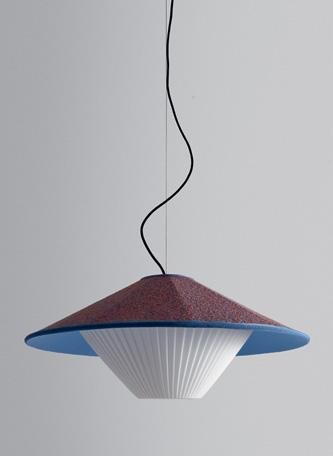

Born in 2010, the Servomuto brand revisits the traditional lampshade to transform it into an object of sophisticated linguistic experimentation, drawing on the world of interior design, and taking an almost sartorialapproach.
very much marked by minimalism, a tail end of the 1990s that had reduced and purged the product of all decoration, taking a synthesis of forms to extremes. Servomuto’slamps,ontheotherhand,seemtobelongto another era; at the beginning of the decade,they chose to embrace a rupture register,an‘essential decorativism’ made of simple shapes but also of color combinations, balanced trimmings, measured finishes”, Alessandro continues,“while maintaining a firm relationship with everyday intimacy,with that‘soft atmosphere made of shadows, of nuances’ that lampshades themselves are abletocreate,transformingenvironments”. Servomuto’s products also declare a strong inclination and deep knowledge of the fashion world, not only becauseofAlessandro’spersonalinterests-apassionate connoisseur of fashion trends and vanguards such as street-wear of the 1970s and 1980s - but also because of hisalwaysup-to-dateresearchonfabricsandpatterns. It is a genuinely “slow and deliberate” artisan process: “Just as in a haute couture atelier, Servomuto’s lamps slowly come to life: they follow a process that closely resembles that of a tailor’s shop, often even the techniques are sartorial ones,many of the lampshades are actually ‘hand-sewn’”. From the initial inspiration - an image, a natural form, or a material - comes the actual design process, with its stages related to the representationoftheidea(designsketch),thesearchfor appropriatetechniquestobringtheideatolife,working alongside artisans, and research on materials and finishestoarriveatthefinishedproduct.
It is an object that is obsolete today but which was ubiquitous in ‘grandmother’s houses,’the servomuto stand - in English the valet stand,the one pants and shirts rested onbut,as the“I wanna be your dog”collection shows,which is strictly linked to the “punk and hardcore”world, also an image transferable to distant worlds
Theduplicityofthecross-referencesthatthetermrefers to reflects the“playful”nature of the brand, but at the same time makes the idea of the union between the evocation of a world of reassuring objects of the past andtheopennesstootherinterpretations,otherworlds, other codes,explicit.This is effectively told by the logo: “a sado-masochistic mask that contrasts well with the romantic and vexatious world of the lampshade,”says AlessandroPoli,itsfounder.
Attracted to the world of color and enraptured by a ‘manic’fascinationwithdetail,AlessandroisfromLecce (so he’s baroque) but trained as a graphic designer at I.E.D.inMilan.Themultiplicityofthefounder’sinterests represents the heart and profound idea of a brand that offers entirely handcrafted hybrid objects that have beenrefashionedinacontemporarykey.
“Italian design has historically been a constant and ongoing source of inspiration,” says Alessandro, citing historical masters from Aldo Rossi and Gio Ponti,Albini to Sottsass and Castiglioni, and reaching back to the nourishing discussions he had with Rodolfo Dordoni. “Servomuto was born at a time when design was still
Appreciated by an educated public, often passionate about the visual arts, art, architecture, photography, but also by those who like to surround themselves with ‘sensitive’ domestic objects, rather than adapting to a type of environment, Servomuto lamps fit harmoniouslyintoanideaofhomecreatedonthe“right balance between tradition and innovation,with a taste for authorial design,with extreme attention to detail; a contemporary environment that wants to maintain an intimate and familiar atmosphere, restoring comfort and welcome to those who live in it”.
And of course,the focus on sustainability in the project has played a key role since the inception of the brand, both in relation to the system and the market, and in the product offerings: “From the very beginning, and not only then,in the last few years”,Alessandro points out, “Servomuto has had an antithetical approach to industrialproductionwithsomebignumbers;wechose from the beginning to favor a handcrafted product with extreme attention to detail that needs slow and conscious processing, a ‘slow-design’ that has all the characteristicsandtimingof‘made-to-order’”. Thus, far from the logic of globalization, Servomuto proposesasustainablemodel,forqualityanddurability, but also for the uniqueness of the typically made-inItaly product.Despite the constant change required by the environment, Servomuto continues its successful course by staying true to the brand’s founding values: “Servomuto is very clear about the path it has already takenandisincontinuitywithitsDNAandhistorythat itwillcontinuewithwhileconstantlyrevampingitself”.

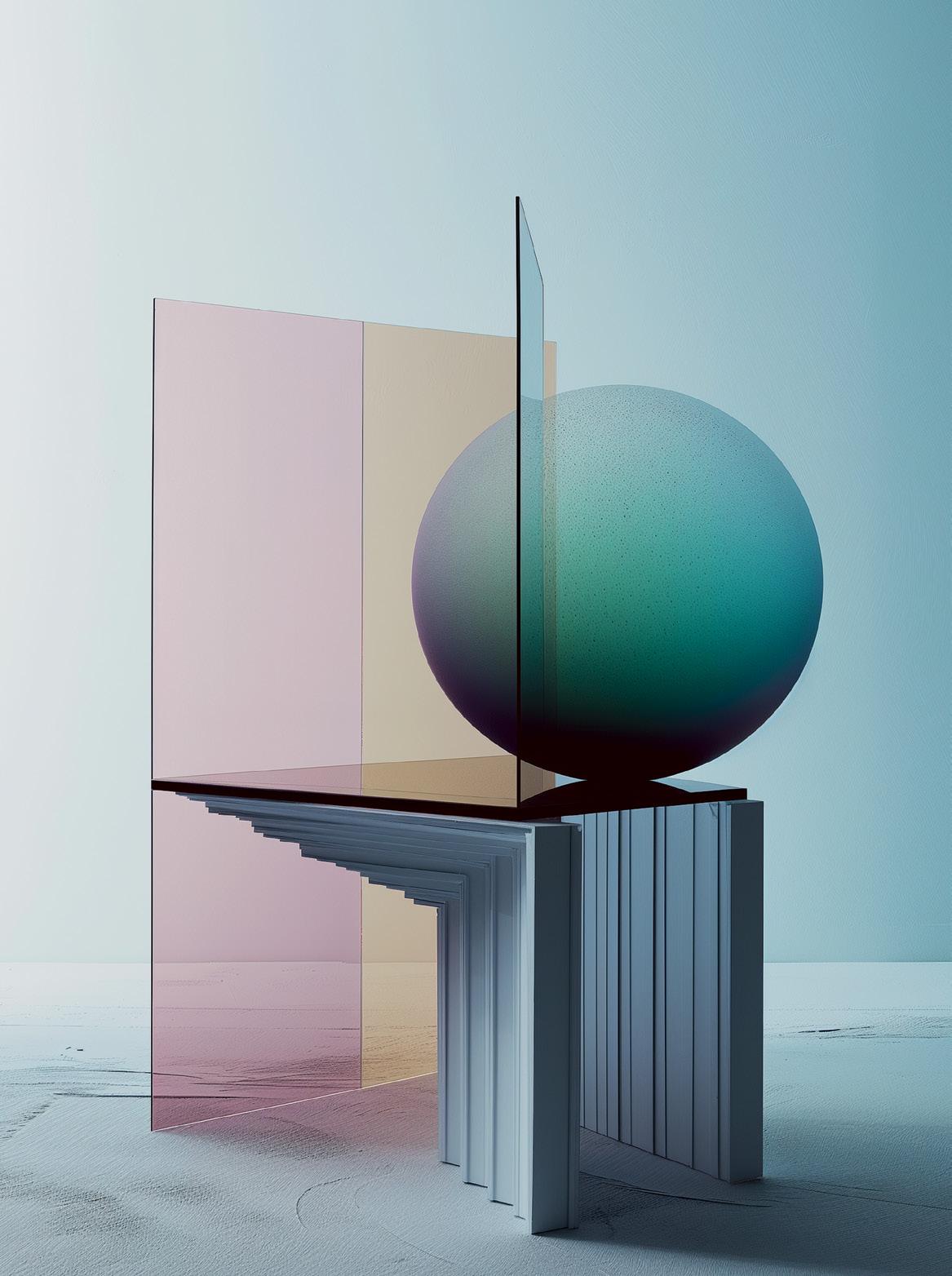
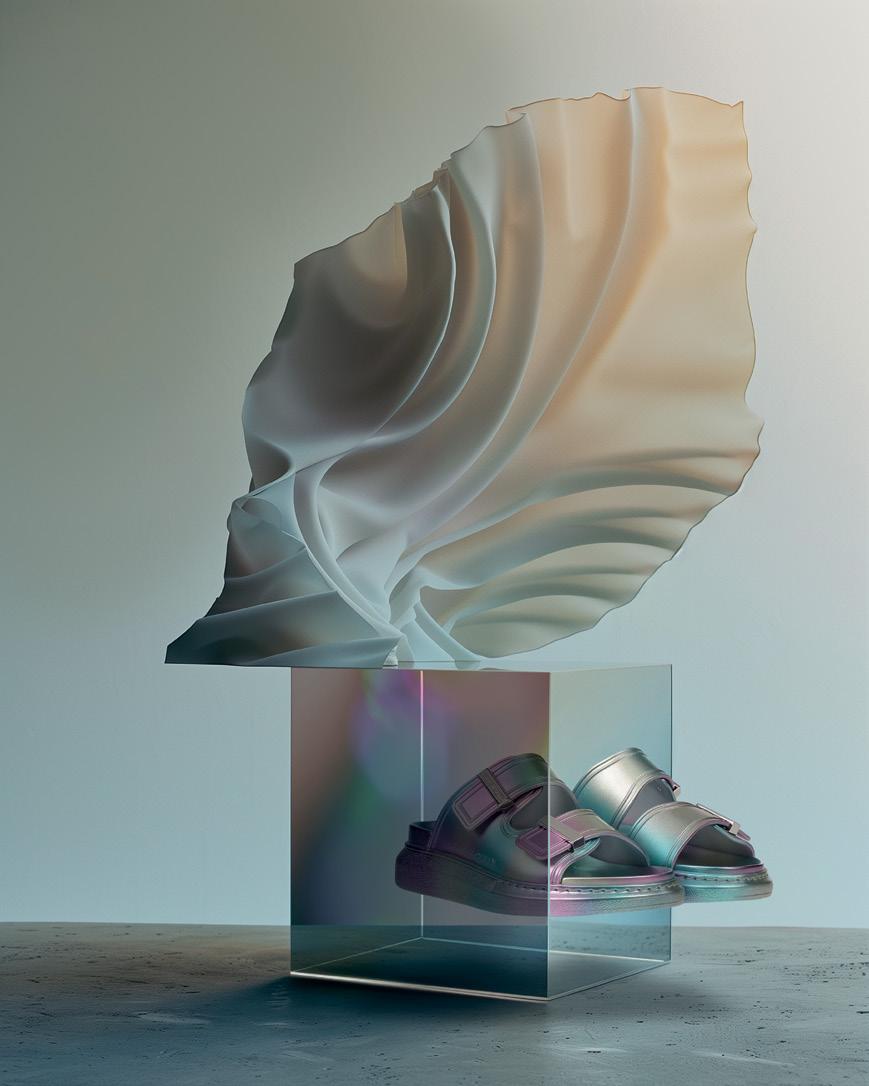 ALEXANDER McQUEEN shoes | PALMIERO earring
ALEXANDER McQUEEN shoes | PALMIERO earring


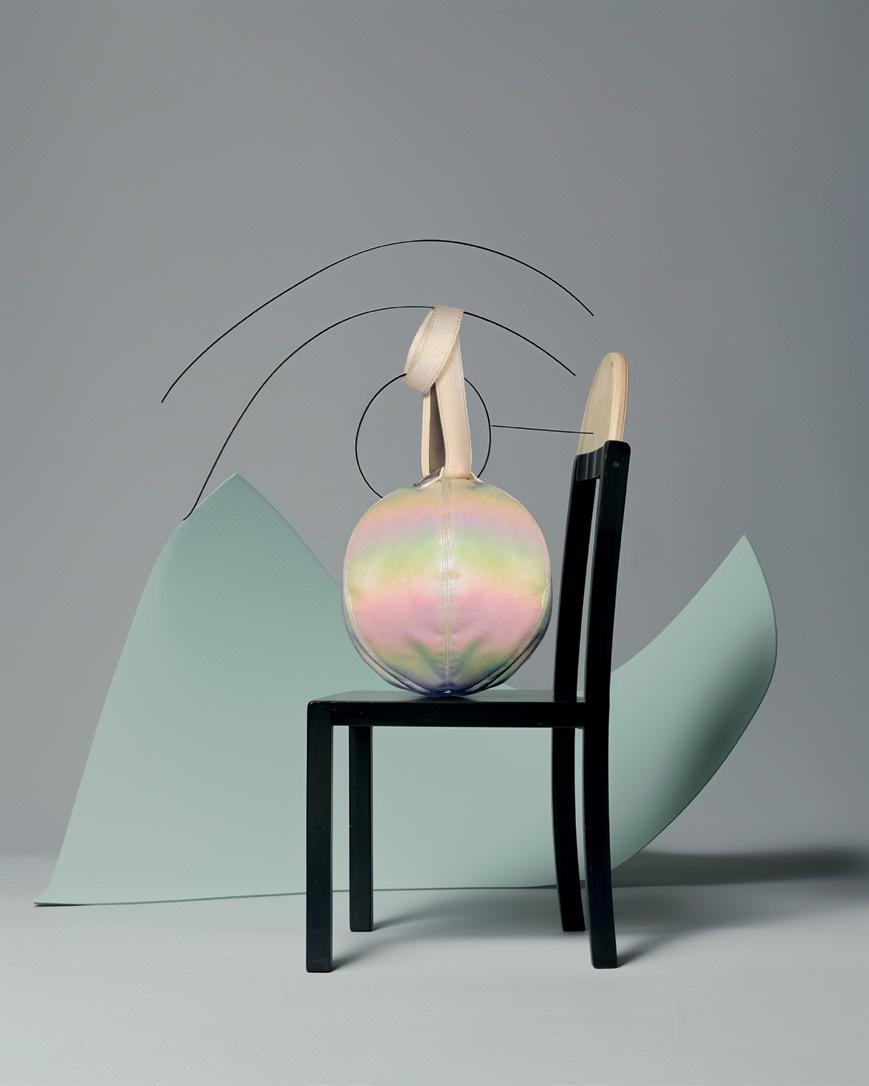


 TORNAGHI ring
TORNAGHI ring
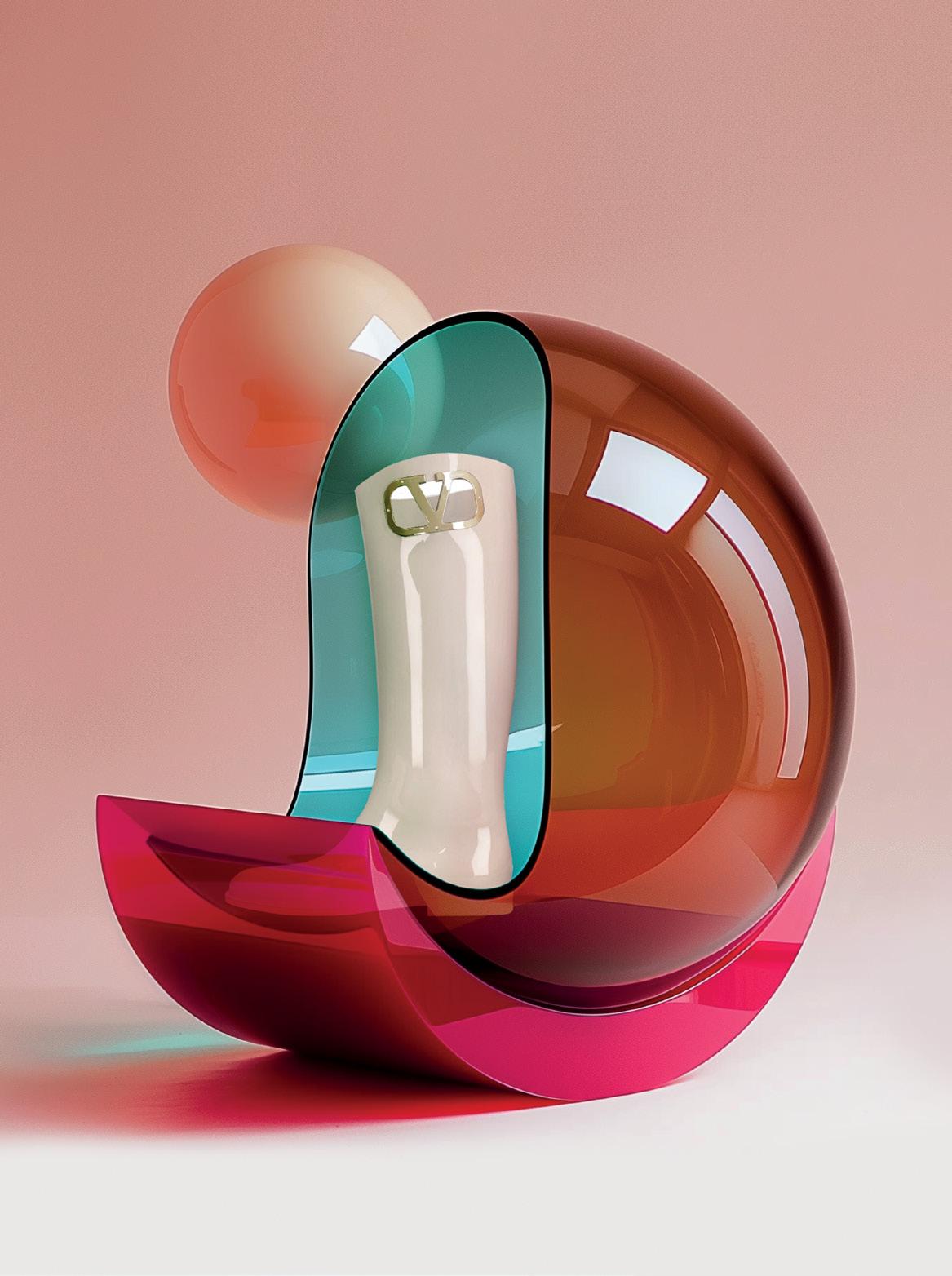



Riva nasce a Sarnico, sul lago di Iseo, inizia costruendo barche da trasporto prima e motoscafi da corsa poi. Oggi la sua produzione spazia da imbarcazioni da diporto lunghe 8 metri fino ai superyacht lunghi 90. La leggenda di Riva inizia negli anni del secondo dopoguerra, quando Carlo Riva prende il timone del cantiere di famiglia fondato nel 1842. Sono gli anni della Dolce Vita e le immagini di Brigitte Bardot, di Sofia Loren, di Anita Ekberg incantate a bordo dei Riva Aquarama (diventato un vero modello cult), Ariston, Junior... fanno il giro del mondo. Esplode il mito Riva con il suo mogano lucido, le cromature splendenti,

i dettagli di quel turchese iconico noto oggi come “Riva Acquamarina” (marchio di colore unico registrato). Eleganza e performance trovano una unica forma.
Dal 2000 Riva fa parte del gruppo Ferretti e da allora il design di tutte le sue imbarcazioni è firmato da Officina Italiana Design (OID). Una collaborazione stretta capace di mantenere una cifra stilistica di estrema coerenza.
Riva 130 Bellissima incarna in modo puro i Riva di oggi, concepiti sì nel rispetto del passato, ma ben attenti a non restare intrappolati nella storia: sono un mix di innovazione, dettagli ricercati, stile senza tempo in cui trovano posto anche quegli stilemi che richiamano un heritage che solo questo brand può vantare.
Lunga 40 metri, è l’ammiraglia della gamma Flybridge (il nome che prende il “tetto” dello yacht quando viene attrezzato con lounge, zone prendisole, bar, postazione di comando ecc.). Sportiva, elegante, si apre ai suoi ospiti con una serie di zone giorno fluide, capaci di esprimere il vero lusso che deve essere ricercato a bordo di uno yacht: il contatto con il mare.
Pronto a cavalcare le tendenze di questi ultimi anni, che hanno visto stravolgere le priorità degli spazi a bordo a favore di esterni prima troppo spesso poco valorizzati, il cantiere ha acceso i riflettori su una lounge a prua oversize con vasca idromassaggio e su uno spazio a poppa che dal livello del mare sale gradualmente fino al pozzetto: si sviluppa su tre livelli - tre terrazze sul mare - perfettamente collegati tra loro (per un totale di 60 metri quadrati) che poi vanno a dialogare con il salone del ponte principale. Qui enormi vetrate scorrevoli avvolgono lo spazio e insieme a un continuo gioco di trasparenze e riflessi proiettano gli ospiti ancora una volta all’esterno.
Più intimo e rilassante il mood delle cabine, pur nel rispetto di una uniformità di stile rigorosa di tutto lo yacht. Sul lower deck ci sono quattro doppie per gli ospiti mentre la suite armatoriale è sul main deck.
E se armatore e ospiti si godono da un punto di osservazione tanto sofisticato quanto privilegiato il mare, anche chi dal mare osserva Riva 130 Bellissima ha il suo spettacolo: con la sua livrea color shark e le sue linee scolpite è un vero yacht d’autore, sintesi tra design, ingegneria navale, artigianalità e tecnologia.
Ma le performance? Riva non si smentisce, Bellissima è un superyacht che in crociera naviga a 20 nodi, con spunti massimi che superano i 22.
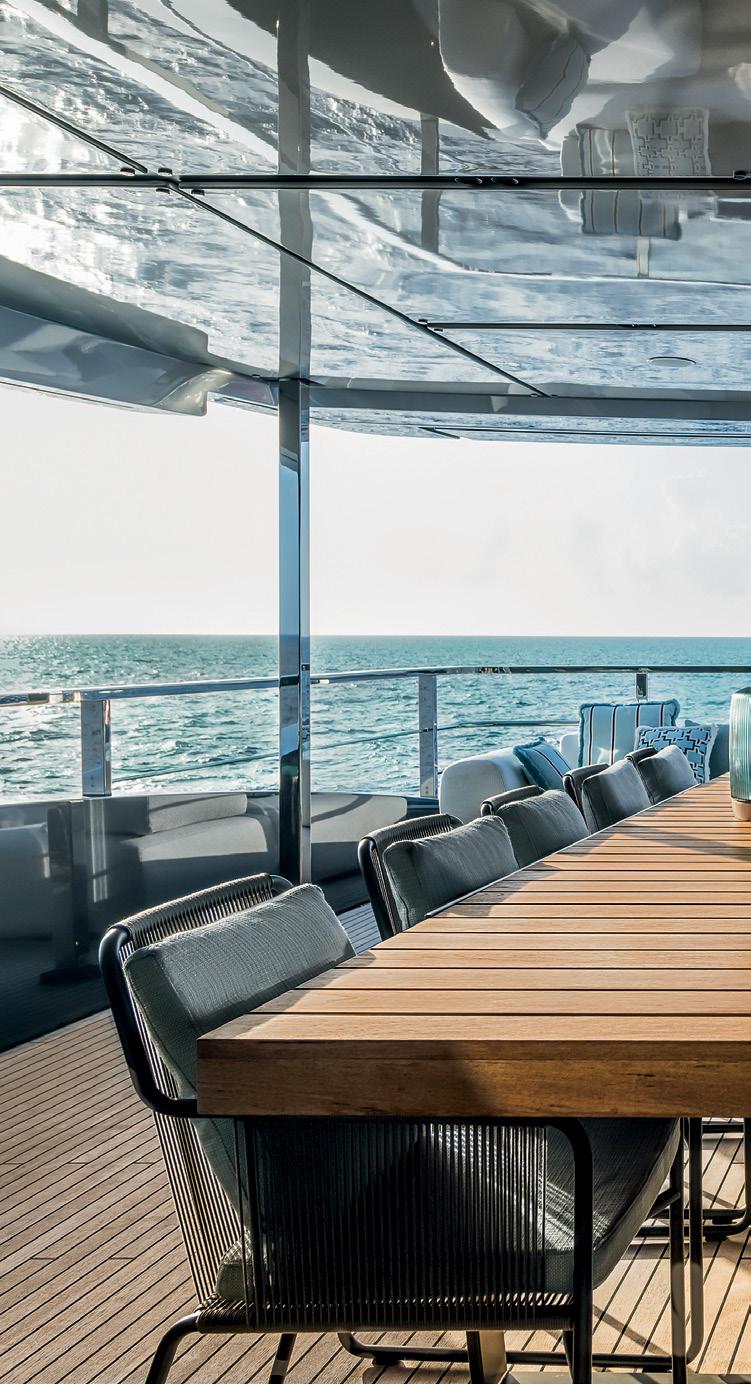
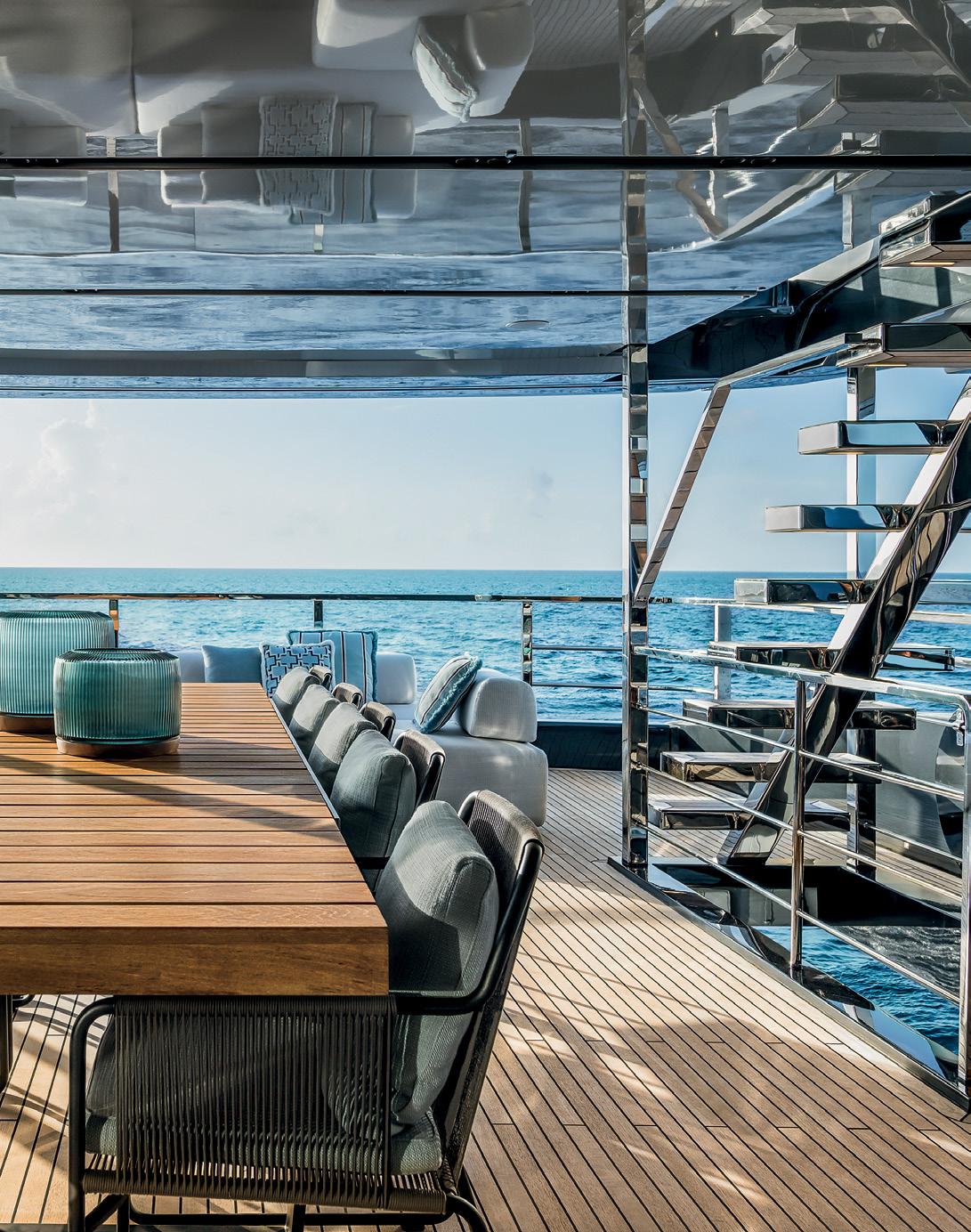
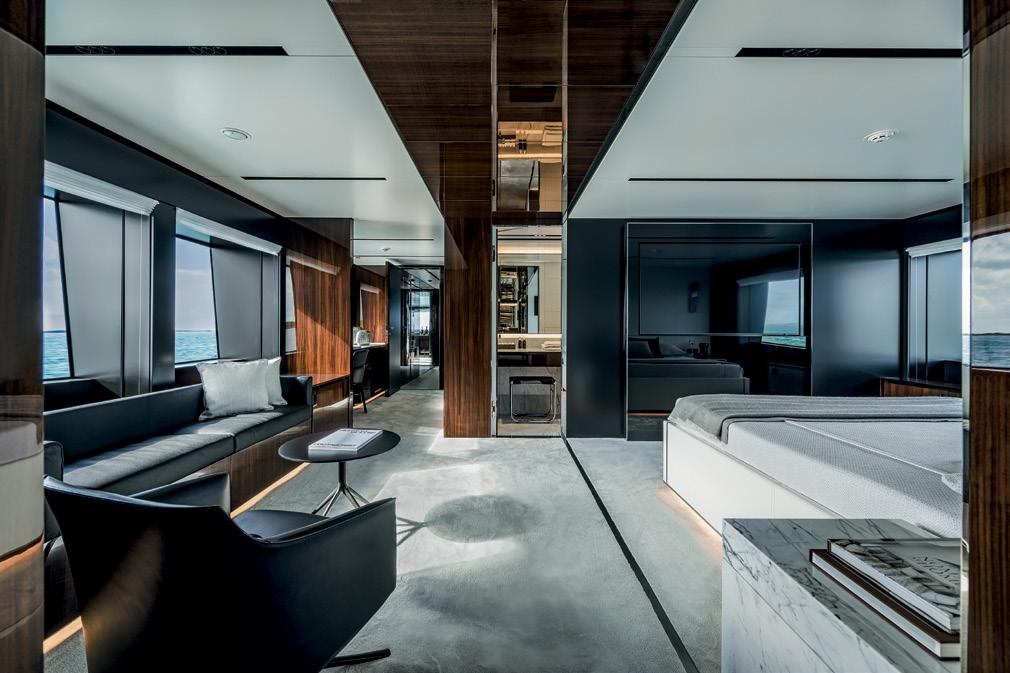
Founded in Sarnico on Lake Iseo, Riva began by first building transport boats and then racing powerboats. Today its production ranges from 8m pleasure boats to 90m superyachts.
guests with a series of flowing living areas,capable of expressingthetrueluxurythatshouldbepursuedaboard a yacht: contact with the sea.
A shipyard,a brand,a myth. Riva has the power to always captivate attention and to amaze
Riva’s legend began in the post-World War II years, when Carlo Riva took the helm of the family shipyard founded in 1842.These are the years of the Dolce Vita, when the images of Brigitte Bardot,Sofia Loren,Anita Ekberg spellbound aboard the Riva Aquarama (which became a veritable cult model),Ariston,Junior...made their way throughout the world.The Riva myth exploded with its polished mahogany, gleaming chrome finishes, and details of that iconic turquoise known today as “Riva Aquamarine” (unique registered color trademark).Elegance and performance combined in a single form.
Since 2000 Riva has been part of the Ferretti Group and, since then, the design of all its boats has been signed by Officina Italiana Design (OID). A strong collaboration capable of maintaining an extremely consistent signature style.
Riva 130 Bellissima embodies in a pure fashion the Rivas of today,conceived certainly in respect of the past, but very careful not to get trapped in history: they are a mix of innovation, refined details, timeless style in whichthereisalsoroomforthosestylisticfeaturesthat call to mind a heritage that only this brand can boast. Fortymeterslong,itistheflagshipoftheFlybridgerange (the name comes from the“roof”of the yacht when itisequippedwithlounges,sunbathingareas,bar,command post,etc.).Sporty and elegant,it opens up to its
Ready to ride the trends of recent years,in which onboard space priorities have been overturned in favor of exteriors that had been previously too often undervalued,the shipyard has switched the spotlight on an oversized bow lounge with Jacuzzi and an aft space that gradually rises from the sea level to the cockpit: it develops on three levels - three decks overlooking the sea - which are perfectly connected one to the other (for a total of 60 square meters) and then communicate with the main deck lounge.Here,huge sliding glass windows envelop the area, where a continuous interplay of transparencies and reflections project guests once again into the open air.
The mood of the cabins is more intimate and relaxed,while maintaining a stringent uniformity of style throughout the yacht.There are four guest doubles on the lower deck while the owner’s suite is located on the main deck.And if the owner and the guests enjoy the sea from a vantage point that is as sophisticated as it is privileged,those watching the Riva 130 Bellissima from the sea are also in for a treat: with its shark-colored livery and sculpted lines, it is a true signature yacht, a synthesis of design, naval engineering, craftsmanship and technology.But what about performance? Riva once again fulfills expectations; Bellissima is a superyacht that cruises at 20 knots,with maximum peaks exceeding 22 knots.
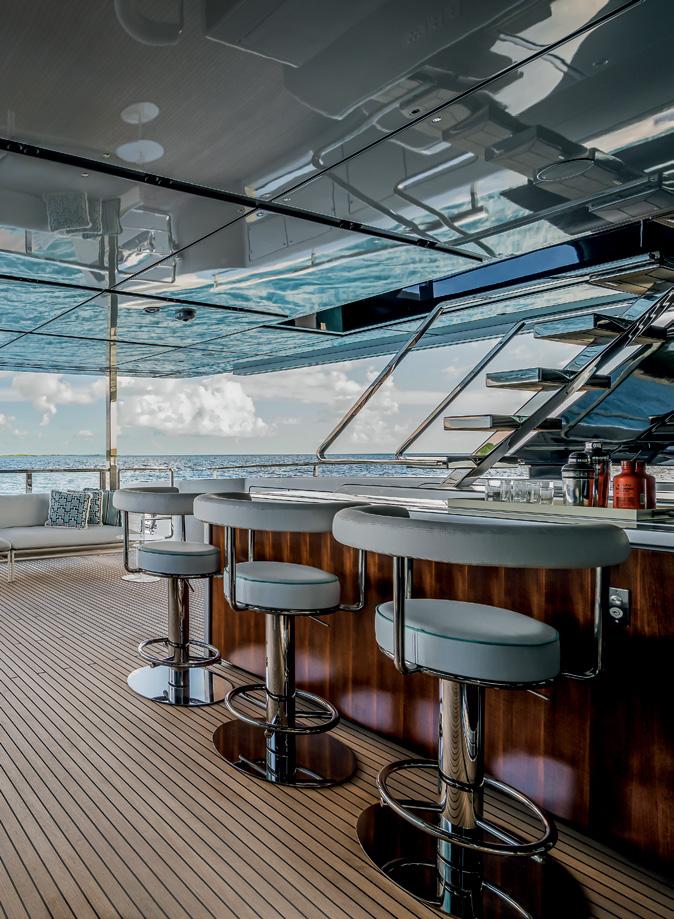



UNA STORIA DI GRANDE LUNGIMIRANZA
E DI STILE INCONFONDIBILE
by Elisa FacchettiIL GRUPPO LVMH, CUI APPARTIENE LA DIVISIONE MOËT HENNESSY, È LEADER MONDIALE DEL LUSSO. FONDATO NEL 1987, È GUIDATO DAL PRESIDENTE
E AMMINISTRATORE DELEGATO BERNARD
ARNAULT E CONTA OGGI 75 MAISON
ICONICHE CHE INCARNANO UN’ART DE VIVRE DISTINTIVA CHE UNISCE TRADIZIONE E MODERNITÀ



La storia di Bernard Arnault e del suo percorso verso la creazione di un universo del lusso in diversi ambiti e in tutto il mondo è uno straordinario esempio di intelligenza e acume commerciale, nonché di grande impegno a fornire una qualità senza pari in ogni categoria, dalla moda al vino. Le strategie messe in atto e la filosofia alla base del successo del Gruppo LVMH, in particolare nella sua divisione vini e liquori, offrono una visione su come il concetto di lusso sia parte intrinseca del DNA dell’azienda. LVMH, con la divisione Moët Hennessy, ha acquisito e gestito alcune delle cantine e dei marchi di liquori, vini e champagne più prestigiosi al mondo. Queste acquisizioni non solo hanno ampliato la presenza sul mercato globale, ma hanno anche rafforzato l’impegno per la qualità e l’eccellenza, sinonimo di un savoir-faire unico, dalla vinificazione all’art de vivre, all’ospitalità e alla gestione della vendita. Moët Hennessy raggruppa oggi ben venticinque Maison, molte delle quali esistono da secoli.
IL MONDO DEL LUSSO DI MOËT HENNESSY
Sotto la guida di Bernard Arnault, LVMH ha rafforzato il suo portafoglio di vini tradizionali e ha puntato verso una diversificazione in altre categorie di bevande. L’acquisizione di cantine e distillerie in regioni chiave del mondo ha ampliato la portata globale dell’azienda e consolidato il suo impegno per la diversità e la qualità del settore con una presenza capillare in oltre 140 Paesi. Moët Hennessy può vantare dunque un ventaglio di marchi senza eguali, rappresentato dall’eccellenza degli Champagne più famosi con un’eredità storica e una qualità eccezionale come Moët & Chandon, Veuve Clicquot, Ruinart, Dom Pérignon, Armand de Brignac e Krug. Tra i brand, sono presenti alcuni tra i più conosciuti luxury spirits internazionali, quali Hennessy, top incontrastato del mercato del cognac, i single malt Glenmorangie e Ardbeg, la vodka Belvedere, il tequila Volcán de mi Tierra, Eminente, rum di Cuba e Whistle Pig, il rye whiskey più premiato dell’industria. Inoltre, la gamma comprende anche vini provenienti da pregiati terroir in tutto il mondo, come Cloudy Bay dalla Nuova Zelanda, Terrazas de los Andes dall’Argentina, Bodega Numanthia dalla Spagna, Château Galoupe, Château d’Esclans e Minuty dalla Provenza, in Francia. Infine, Moët Hennessy si è recentemente lanciata nel settore degli aperitivi readyto-serve, con Chandon Garden Spritz, referenza della maison Chandon.
TASTE EXPERIENCE: ECCELLENZA E RISPETTO PER LA BIODIVERSITÀ
DALLA VIGNA AL BICCHIERE
Un aspetto chiave della strategia di LVMH è stata l’espansione nei mercati emergenti. Le acquisizioni di aziende vinicole e la creazione di nuovi marchi in regioni localizzate in Cina e in America Latina dimostrano la lungimiranza del Gruppo nell’esplorare nuove frontiere nell’universo vino e delle bevande. Scopriamo insieme alcune eccellenze perfette per la stagione primaverile ed estiva.

Chandon Garden Spritz from Argentina
Ideato dalla winemaker di Chandon Argentina
Paula Bertolucci, Chandon Garden Spritz rispecchia l’autenticità dei sapori argentini: «Sapevamo di voler creare qualcosa di amaro, perché questo paese ama i sapori amari. Beviamo il mate tutti i giorni e poi amiamo Fernet e vermouth – spiega la winemaker –. Per questa creazione, i nostri enologi hanno studiato le arance come se fossero uva, in modo da (ri)creare la migliore Spritz experience possibile. Abbiamo deciso di selezionare un’azienda tradizionale, sostenibile e a gestione famigliare che non usasse pesticidi sulle arance. Questo aspetto è fondamentale per noi, perché utilizziamo solamente le bucce”. La base comprende uve Chardonnay, Pinot Noir e Sémillon che provengono dalla tenuta Chandon in Argentina e ogni varietà è vinificata separatamente utilizzando il metodo Charmat lungo per una lenta fermentazione. Ci sono voluti quattro anni e ben 64 prove prima di raggiungere la ricetta perfetta che comprende anche un mix di spezie sapientemente dosato, erbe e piante aromatiche provenienti dai migliori terroir del mondo. Chandon Garden Spritz è adatto ad essere degustato con gli amici in moltissime occasioni ed è ottimo anche abbinato al cibo. Proposto in bottiglie da 75 cl, è stato pensato anche in mini formato da 187 ml riscontrando un notevole successo.

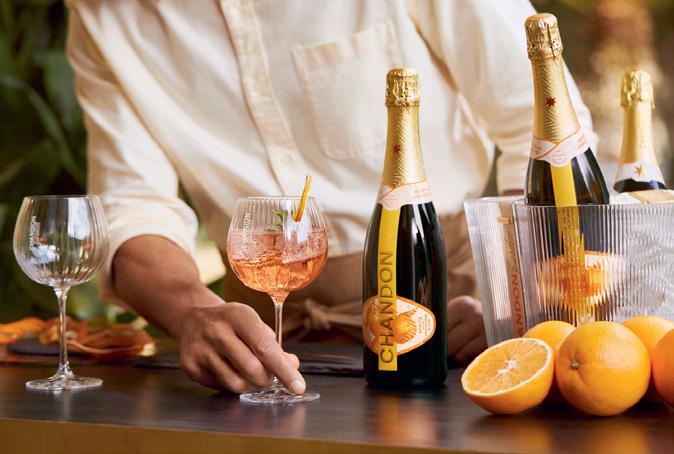
Chandon,sparklingwinemadeinCalifornia Sempre in cerca di nuovi terreni, nuove possibilità e nuove sfide, il Gruppo LVMH arriva a Napa, in California, con il brand Chandon. In questo territorio nasce la prima vigna avamposto per la produzione di spumanti negli Stati Uniti: la vigna Carneros di Chandon. Situata nell’estremità settentrionale di San Pablo Bay, rappresenta una posizione ideale per coltivare Chardonnay di qualità. Fiori bianchi, pompelmo e limone con sentori di brioche, mandorla e miele, rendono questa varietà ricca, elegante e minerale, complessa e cremosa. La “casa” Chandon a Napa, progettata da ROMA Architects nel 1977 e recentemente ristrutturata con uno straordinario progetto, si trova in un edificio all’avanguardia di 4000 m2 Segue le linee del paesaggio in modo discreto ed è realizzata usando materiali eco-sostenibili; il design e gli elementi riprendono le botti da fermentazione e le barrique in legno. Arnaud de Saignes, Presidente Chandon da luglio 2023, ma presente nella Maison dal 2017, illustra: «Anche qui abbiamo dato inizio a numerose
pratiche di coltura sostenibile che prendono in considerazione l’intero ecosistema: vigne, insetti, animali, altre specie vegetali, tipo di suolo, ecosistemi confinanti; il nostro obiettivo è ridurre parassiti e malattie e creare un rapporto simbiotico sano tra le nostre piante e l’ambiente». Oggi Chandon California si spinge oltre i limiti dell’avanguardia tecnologica, per produrre spumanti leader del mercato statunitense. A seguire ogni processo c’è Pauline Lhote, Chef de cave Chandon California. Esempio di eccellenza è lo spumante nato per il 50° anniversario dalla fondazione nel 1973, prodotto da quattro winemakers di Chandon con decennale esperienza. Iconico Chandon Blanc de Pinto Noir, un classico Pinot della Napa Valley raccolto di notte: morbido e speziato, con note di nettarina e frutti rossi. Chandon Brut Rosé è un affascinante e vivace rosé frizzante secco: il classico Chandon California rosé è perfetto da sorseggiare tutto l’anno, con vivaci sapori di fragola, ciliegia e cracker Graham che terminano con un accento vivace.
Rosè della Provenza,Chateau Galoupet
Château Galoupet è una tenuta innovativa situata in Costa Azzurra, un Cru Classé de Provence certificato da agricoltura biologica da maggio 2023. Un santuario della biodiversità e modello di sostenibilità, che comprende 77 ettari di boschi protetti e 69 ettari di vigneti. La tenuta è stata acquistata da Moët Hennessy nel 2019 come primo Cru Classé per dare vita a espressioni uniche di un territorio d’eccezione, con un’attenzione particolare all’ambiente. A portare avanti questo progetto ambizioso è Jessica Julmy, direttrice generale della tenuta che in quattro anni, con la propria equipe, ha collaborato con un gruppo di esperti per ristabilire un ecosistema raro e adattare le pratiche enologiche per rispettare al meglio l’equilibrio della vigna. L’obiettivo è sempre stato quello di porsi come esempio positivo di sostenibilità all’interno del Gruppo LVMH e modello di pratiche biologiche e ambientali per il settore enologico. A seguito di un processo di rigenerazione della tenuta durato anni per poterne proporre i frutti migliori, Château Galoupet ha presentato alcuni tra i suoi primi
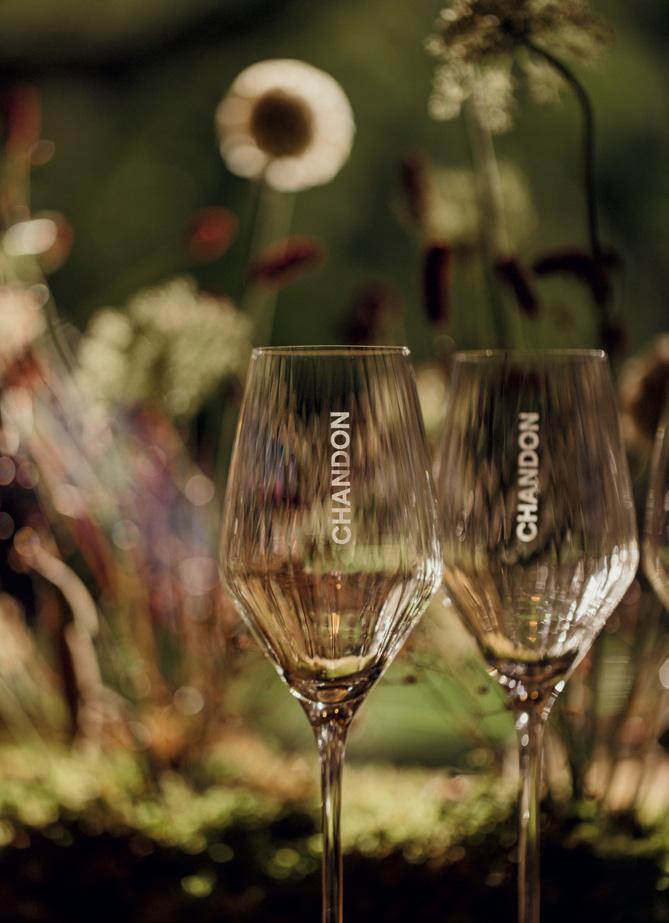
vini in conversione biologica: Château Galoupet Cru Classé Rosé 2021 e Galoupet Nomade 2021. Il Cru Classé Rosé 2021 è composto da 40% Grenache, 35% Bourbes, 12% Tibouren e 11% Syrol (unione di Syrah e Rolle - il loro Vermentino) e un 2% di Syrah in purezza. Questo porta a un vino fresco, equilibrato, ma al contempo fruttato con note di pesca, pompelmo rosa, sapidità sul finale con lievi cenni di pepe. La filosofia che anima la tenuta nei confronti del rispetto per l’ambiente si riflette anche nel packaging, sicuramente innovativo, costituito da una bottiglia ambrata e molto leggera, prodotta con il 70% di vetro riciclato. Anche per Nomade 2021 è stata pensata una bottiglia interamente realizzata in plastica riciclata, recuperata dagli oceani, del peso di appena 63 grammi. La forma piatta la rende adatta al trasporto, in barca o per un picnic all’aperto. Il blend di uve è lo stesso usato per il Cru Classé con una piccola quantità di Cinsault. Al naso si esprime con sentori di frutti di bosco, pompelmo rosa e melagrana. Al palato è leggero e rinfrescante; la mineralità è decisa. Perfetto per allietare l’aperitivo.
DEGNO DI NOTA
Una caratteristica distintiva del Gruppo è stata quella di fondere l’innovazione con il rispetto della tradizione. Pur investendo in moderne tecnologie di vinificazione e distillazione, LVMH ha mantenuto un forte impegno nei confronti delle tradizioni e dell’eredità di ciascun marchio. Come nella moda, il Presidente Bernard Arnault ha applicato una filosofia di libertà creativa in enologia, lasciando ai viticoltori e ai maestri distillatori lo spazio per sperimentare e innovare. Questo approccio ha portato alla creazione di prodotti unici e ha rafforzato il carattere distintivo di ciascun marchio all’interno del portafoglio LVMH. Negli ultimi anni, LVMH ha inserito la sostenibilità e la responsabilità sociale come pilastri della propria strategia per il mondo wine & spirits. Ciò include pratiche agricole sostenibili, gestione responsabile delle risorse e sostegno alle comunità locali nelle regioni in cui operano.
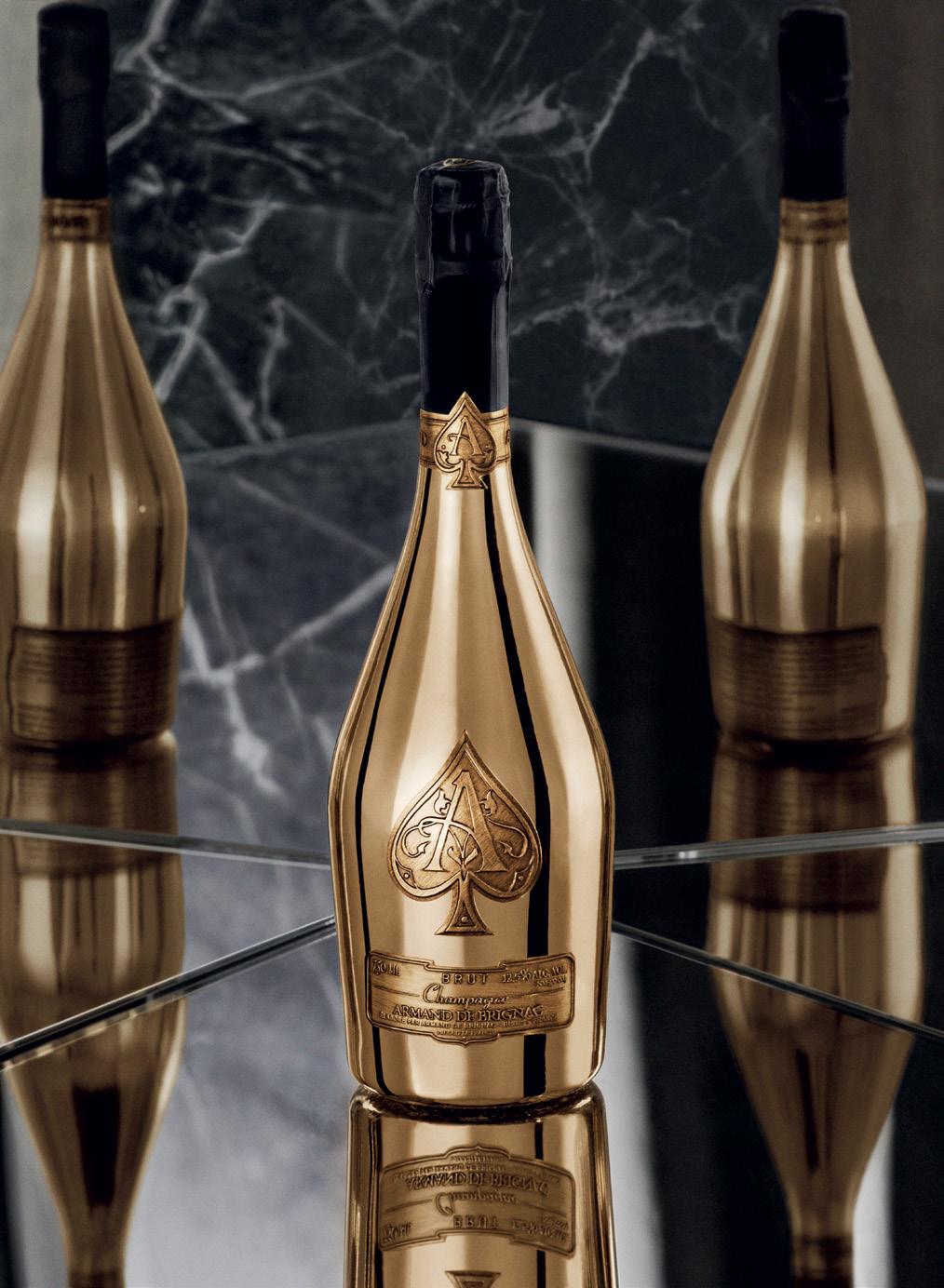

Moët Hennessy: a story of great foresight and unmistakable style
LVMH,which the Moët Hennessy division is part of, is a world leader in luxury. Founded in 1987,the Group is under the leadership of Chairman and CEO Bernard Arnault and now has 75 iconic maisons that embody a distinctive art de vivre that combines tradition and modernity
ThestoryofBernardArnaultandhispathtocreatinga universe of luxury in different spheres and all around the world is an extraordinary example of intelligence andbusinessacumen,aswellasagreatcommitmentto delivering unparalleled quality in every category,from fashion through to wine. The strategies implemented and the philosophy behind the LVMH Group’s success, particularly in its wine and spirits division, offer insight into how the concept of luxury is an intrinsic part of the company’s DNA. With its Moët Hennessy division, LVMH has acquired and managed some of the most prestigious wineries and spirit, wine and champagne brands in the world. These acquisitions

not only expanded the global market presence, but also strengthened the commitment to quality and excellence, something which is synonymous with unique savoir-faire, from winemaking to art de vivre, hospitality and sales management. Moët Hennessy now has as many as twenty-five Maisons, many of which have existed for centuries.
Under the leadership of Bernard Arnault, LVMH has strengthened its portfolio of traditional wines and moved towards diversification into other beverage categories.The acquisition of wineries and distilleries in key global regions has expanded the company’s reach around the world and solidified its commitment to diversity and quality in the industry with a widespread presence in more than 140 countries. Moët Hennessy can thus boast an unparalleled array of brands, represented by the excellence of the most famous Champagnes with a historical legacy and exceptional quality such as Moët & Chandon, Veuve Clicquot, Ruinart, Dom Pérignon, Armand de Brignac and Krug.The brands include some of the best-known international luxury spirits, such as Hennessy, the undisputedleaderofthecognacmarket;Glenmorangie and Ardbeg single malts; Belvedere vodka; Volcán de mi Tierra tequila; Eminente, rum from Cuba; and WhistlePig,theindustry’shighestawardedryewhiskey. In addition, the range also includes wines from fine terroirs around the world, such as Cloudy Bay from New Zealand, Terrazas de los Andes from Argentina, Bodega Numanthia from Spain,and Château Galoupe, Château d’Esclans,and Minuty from Provence,France. Finally,Moët Hennessy has recently launched into the ready-to-serve aperitif sector, with Chandon Garden Spritz,a reference of the Chandon maison.
TASTE EXPERIENCE: EXCELLENCE AND RESPECT FOR BIODIVERSITY FROM THE VINEYARD TO THE GLASS
AkeyaspectofLVMH’sstrategyhasbeenitsexpansion into emerging markets. Acquisitions of wineries and the creation of new brands in regions located in China and Latin America demonstrate the Group’s foresight in exploring new frontiers in the wine and beverage
universe.Let’sdiscoversometopoptionsperfectforthe spring and summer season.
Chandon Garden Spritz from Argentina
Created by Chandon Argentina winemaker Paula Bertolucci, Chandon Garden Spritz reflects the authenticityofArgentineflavors:“Weknewwewanted to create something bitter because Argentinians love bitter flavors. We drink mate every day and we love Fernet and vermouth”, the winemaker explains.“For this creation, our winemakers studied oranges as if they were grapes in order to (re)create the best Spritz experience possible.We decided to select a traditional, sustainable, family-run business that did not use pesticides on their oranges. This aspect is crucial for us because we only use the peels”. The base includes Chardonnay,PinotNoirandSémillongrapesthatcome fromtheChandonestateinArgentina,andeachvariety is vinified separately using the long Charmat method for slow fermentation. It took four years and no less than64trialsbeforereachingtheperfectrecipe,which also includes an expertly dosed mix of spices, herbs and botanicals from the world’s best terroirs.Chandon Garden Spritz can be enjoyed with friends on many occasions and is also great paired with food.Offered in 75clbottles,ithasalsobeendesignedina187mlmini format,a size that has been rather successful.
Chandon,sparkling wine made in California
Always looking for new plots of land,new possibilities and new challenges, the LVMH Group arrived in Napa, California, with the Chandon brand. The first outpost vineyard for sparkling wine production in the United States was developed in this area: the Carneros vineyard by Chandon. Located at the northern end of San Pablo Bay,it is the perfect location for growing quality Chardonnay. White flowers, grapefruit and lemon with hints of brioche,almond and honey make this variety rich, elegant and mineral, complex and creamy.The“house”of Chandon in Napa,designed by ROMA Architects in 1977 and recently renovated with an extraordinary project,is located in a state-of-the-art 4,000 m2 building.It follows the lines of the landscape unobtrusively and is made using environmentally sustainable materials; the design and elements echo fermentation casks and wooden barrels. Arnaud de

Saignes, who has been Chandon’s president since July 2023 but present at the Maison since 2017,states: “Here, too, we have launched many sustainable cultivation practices that take into consideration the entire ecosystem: vineyards, insects, animals, other plant species, soil type, neighboring ecosystems; our goal is to reduce pests and diseases and create a healthy symbiotic relationship between our plants and the environment”. Today Chandon California is pushing the boundaries of cutting-edge technology to produce market-leading sparkling wines in the United States.Following each process is Pauline Lhote,Chef de cave Chandon California.An example of excellence is the sparkling wine created for the 50th anniversary since its founding in 1973,produced by four Chandon winemakers with decades of experience. Iconic Chandon Blanc de Pinto Noir, a classic Napa Valley Pinot harvested at night: smooth and spicy,with notes of nectarine and red fruits. Chandon Brut Rosé is a charming and vibrant dry sparkling rosé: the classic Chandon California rosé is perfect for sipping all yearround, with lively strawberry, cherry and Graham cracker flavors that finish with a lively accent.
Rosé of Provence,Chateau Galoupet
Château Galoupet is an innovative estate located on the French Riviera,a Cru Classé de Provence certified organic since May 2023. It is a biodiversity sanctuary and model of sustainability, comprising 77 hectares of protected forests and 69 hectares of vineyards.The estate was acquired by Moët Hennessy in 2019 as the
firstCruClassétobringtolifeuniqueexpressionsofan exceptional terroir with a focus on the environment. Leading this ambitious project is Jessica Julmy, the estate’s general manager,who over four years,with her team,has worked with a team of experts to reestablish a rare ecosystem and adapt winemaking practices to best respect the balance of the vineyard. The goal has always been to stand as a positive example of sustainability within the LVMH Group and a model of organic and environmental practices for the wine industry.Followingayears-longprocessofregenerating the estate in order to offer its best fruits, Château Galoupet presented some of its first wines in organic conversion: Château Galoupet Cru Classé Rosé 2021 and Galoupet Nomade 2021.
Cru Classé Rosé 2021 is made up of 40% Grenache, 35% Bourbes,12% Tibouren and 11% Syrol (Syrah and Rolle - their Vermentino) and a 2% pure Syrah. This leads to a fresh, balanced yet fruity wine with notes of peach, pink grapefruit, sapidity on the finish with slight hints of pepper.The estate’s philosophy towards respect for the environment is also reflected in its packaging, which is certainly innovative, consisting of an amber-colored,very lightweight bottle made from 70% recycled glass. Also designed for Nomad 2021 is a bottle made entirely of recycled plastic recovered from the oceans,weighing just 63 grams.Its flat shape makesitsuitablefortransportation,boatingoroutdoor picnics. The blend of grapes is the same as that used for Cru Classé with a small amount of Cinsault. The nose boasts hints of berries, pink grapefruit and
pomegranate. The palate is light and refreshing; the minerality is firm.Perfect for livening up aperitifs.
One of the Group’s distinguishing characteristics has been to blend innovation with respect for tradition. While investing in modern winemaking and distillation technologies,LVMH has maintained a strong commitment to the traditions and heritage of each brand.Like in fashion,President Bernard Arnault has applied a philosophy of creative freedom in winemaking,leavingspaceforwinemakersandmaster distillers to experiment and innovate. This approach has led to the creation of unique products and strengthened the distinctive character of each brand within the LVMH portfolio.In recent years,LVMH has included sustainability and social responsibility as pillars of its wine and spirit strategy. This includes sustainable agricultural practices,responsible resource managementandsupportforlocalcommunitiesinthe regions where they are present.


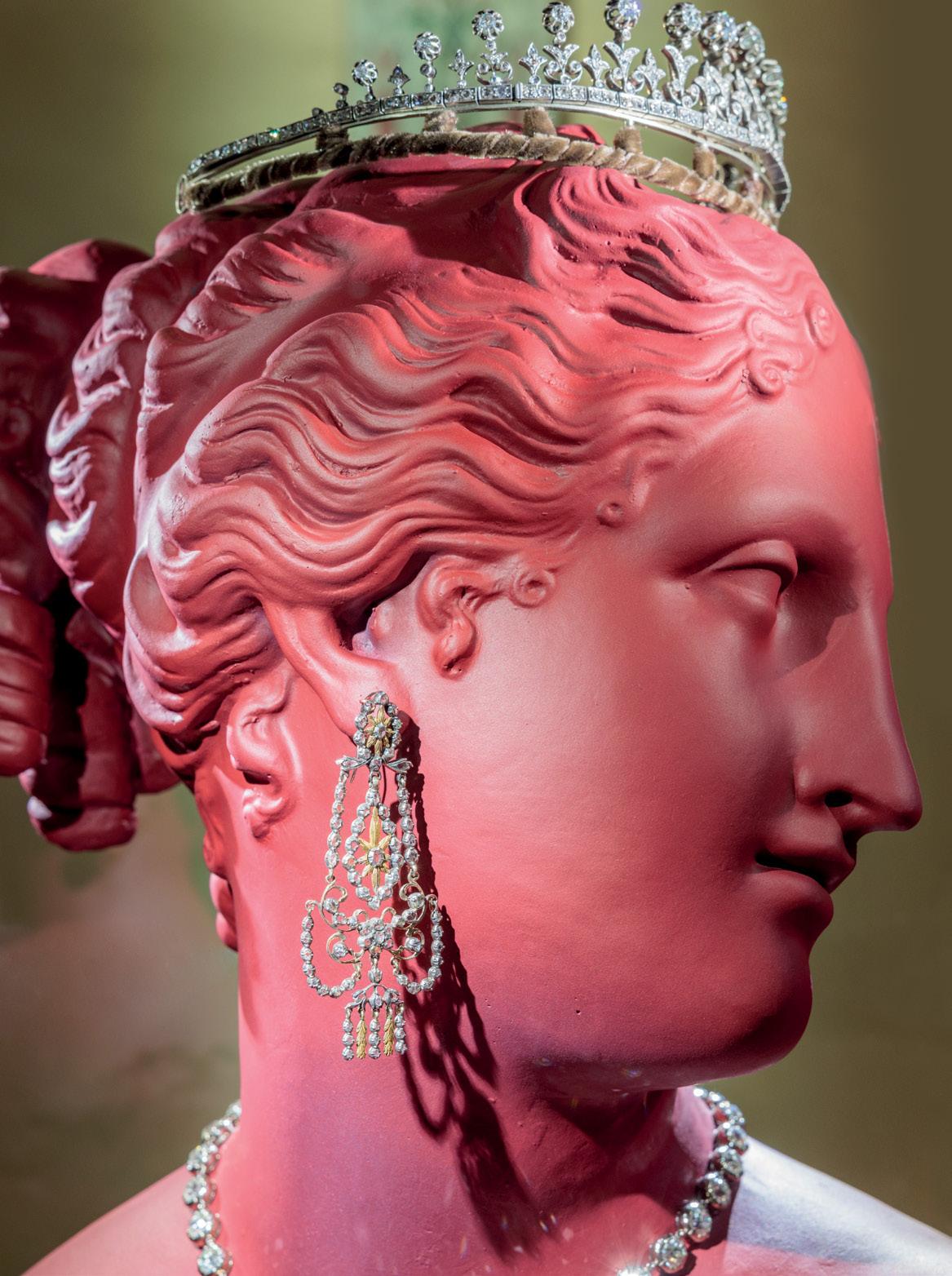
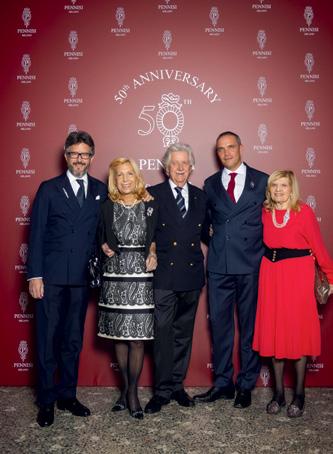
Fondata oltre cinquant’anni fa da Giovanni Pennisi, questa rinomata attività è diventata sinonimo di eleganza, raffinatezza e profonda venerazione per l’arte del passato. Il percorso di Giovanni Pennisi nel mondo dei gioielli inizia a Catania, dove si immerge nelle tradizioni del lavoro artigianale in giovane età. Sotto la guida di suo zio, un maestro “diamanteur”, Giovanni affina le sue abilità nell’arte delicata di lavorare con pietre preziose e metalli. È durante questi anni formativi che Giovanni sviluppa una profonda ammirazione per la bellezza e il savoir faire dei gioielli antichi, una passione che avrebbe plasmato la sua vita e la sua eredità.
Dopo la Seconda Guerra Mondiale, Giovanni prende la coraggiosa decisione di lasciare la sua città natale e cercare fortuna a Milano, il vivace epicentro della rinascita post-bellica italiana. Armato della sua conoscenza e competenza, Giovanni si impegna per affermarsi come figura rispettata nel fiorente panorama gioielliero meneghino. La sua reputazione di intenditore di gioielli antichi si diffonde rapidamente, attirando clienti da ogni classe sociale, tra cui nobili, celebrità e collezionisti. Nel 1971, Giovanni, compiendo un atto
di fede, apre le porte del negozio “gioielli antichi e oggetti di valore” Pennisi al 29 in via Alessandro Manzoni. Situato accanto allo storico Grand Hotel et De Milan, il negozio diviene velocemente un punto di riferimento per gli amanti dell’artigianalità raffinata e della bellezza senza tempo. Guido e Paola Pennisi, figli di Giovanni, decidono di seguire il padre nella sua impresa, apportando i loro talenti e punti di vista unici all’attività di famiglia. Unita, la famiglia Pennisi si è da allora impegnata nel curare una collezione di tesori rari e squisiti che abbraccia tre secoli di storia, dal 1750 al 1950. Ogni pezzo nella collezione racconta una storia a sé, riflettendo le tendenze culturali, artistiche e sociali del suo tempo. Dalle spille Georgiane adornate con filigrane intricate ai collier Art Déco che scintillano con lo splendore dei diamanti: ogni oggetto nella collezione Pennisi è, oggi, una testimonianza dell’abilità, dell’ingegno e della raffinatezza del suo creatore.
Pennisi, però, è più di una semplice boutique di gioielli ricercati: è un’istituzione culturale, un testimone vivente alla ricca trama della storia e della creatività umane. Negli anni, il negozio è diventato un luogo d’incontro per artisti,
studiosi e appassionati, attratti dall’incanto dei suoi tesori e dalla calda ospitalità dei proprietari.
Un viaggio, quello di Pennisi, lungo cinquant’anni, la cui eredità è stata raccolta in un’opera letteraria che ne racchiude l’essenza: il libro intitolato La Collezione Pennisi, curato da Alba Cappellieri. Questa meticolosa antologia porta la testimonianza del fascino eterno esercitato dai gioielli antichi e oggetti virtuosi, offrendo ai lettori uno sguardo su tre secoli di squisita artigianalità e significato culturale. Diviso in tre capitoli, il libro narra l’evoluzione dello stile, della cultura e della società usando i gioielli come fil rouge: dalla rivoluzione culturale dell’Illuminismo all’eleganza del diciannovesimo secolo, alla velocità del ventesimo secolo. Con commenti illuminanti e immagini mozzafiato, La Collezione Pennisi trasporta i lettori in un viaggio attraverso le epoche, invitandoli a esplorare la ricca trama della storia e della creatività che definisce l’anima di Pennisi. È un tesoro letterario che celebra la bellezza, l’artigianalità e il significato culturale dei gioielli antichi, permettendo all’heritage di Pennisi di continuare a brillare per le generazioni a venire.


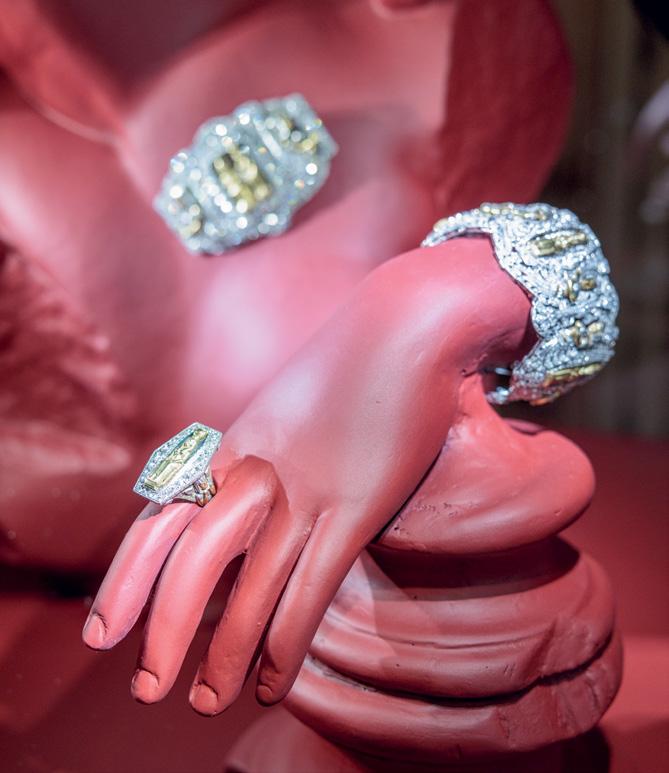
«SONO AFFASCINATA DA COME QUESTI OGGETTI SIANO IN GRADO DI RACCHIUDERE IN SÉ, E IN QUALCHE MODO TRASMETTERE, NON SOLO LA STORIA E IL GUSTO DI UN’EPOCA, MA ANCHE QUELLA DI CHI LI HA PORTATI» – MIUCCIA PRADA, PREFAZIONE AL LIBRO “LA COLLEZIONE PENNISI”
Nel dicembre 2023, per commemorare questi cinquant’anni di eccellenza, Pennisi ha collaborato con la rinomata designer e direttrice creativa Paula Cademartori per organizzare un evento speciale al Palazzo Serbelloni. Situato in Corso Venezia, il palazzo neoclassico è stato lo sfondo perfetto per un’immersione nel mondo Pennisi. L’evento, intitolato “Pennisi, 50 anni di gioielli
e di oggetti virtuosi”, ha visto esposti alcuni dei pezzi più esclusivi della collezione, tra cui oggetti rari e unici nel loro genere, mai mostrati prima in pubblico.
Dai pendenti rinascimentali ornati da intagli intricati ai locket Vittoriani finemente scolpiti, ogni pezzo esposto ha offerto uno sguardo su un’epoca passata.
Mentre i visitatori vagavano per le sale di Palazzo Serbelloni, venivano trasportati nel tempo, guidati dalle ricche tonalità del bordeaux delle vetrine di Pennisi e dalle eleganti esposizioni create da Cademartori stessa. Una celebrazione dell’artigianalità, della creatività e, soprattutto, una testimonianza dell’eterna essenza di Pennisi – un’essenza che continua a ispirare e incantare il pubblico a livello internazionale.
In un mondo che spesso, oggi, valorizza il nuovo rispetto al vecchio, Pennisi si erge a faro di tradizione e eleganza senza tempo. Dai suoi umili inizi al suo illustre presente, il viaggio di Pennisi è una testimonianza del potere indomito della bellezza, dell’abilità manuale e dello spirito umano.
Celebrare insieme a Pennisi cinquant’anni di gioielli e oggetti virtuosi ci ricorda che ci sono tesori destinati a durare una vita intera - e oltre.
Nestled amidst the grandeur of Milan’s historic streets,Pennisi stands as a testament to the enduring allure of antique jewellery and virtuous objects
Founded over fifty years ago by Giovanni Pennisi, this renowned establishment has become synonymous with elegance, sophistication, and a deep reverence for the artistry of the past. Giovanni Pennisi’s journey into the world of jewellery began in Catania,where he was steeped in the traditions of artisanal work from a young age. Under the tutelage of his uncle, a master diamantaire, Giovanni honed his skills in the delicate art of working with precious stones and metals.It was during these formative years that Giovanni developed a profound appreciation for the beauty and savoir faire of antique jewellery,a passion that would shape his life and legacy.In the aftermath of World War II,Giovanni made the bold decision to leave his hometown and seek his fortune in Milan, the bustling epicentre of Italy’s post-war renaissance. Armed with his knowledge and expertise, Giovanni set out to establish himself as a respectedfigureinthecity’sburgeoningjewelleryscene. His reputation as a discerning connoisseur of antique jewelsquicklygrew,attractingclientsfromallcornersof society,includingnobility,celebrities,andcollectors.
In 1971, Giovanni took a leap of faith and opened the doors to Pennisi’s “antique jewellery and objets de vertu” shop on via Alessandro Manzoni, 29. Located next to the historic Grand Hotel et De Milan,the shop quickly became a beacon for lovers of fine artisanry andtimelessbeauty.GuidoandPaolaPennisi,Giovanni’s children, joined him in his endeavour, bringing their uniquetalentsandperspectivestothefamilybusiness. Together, the Pennisi family embarked on a mission to curate a collection of rare and exquisite treasures spanning three centuries of history,from 1750 to 1950. Each piece in the collection told a story of its own, reflecting the cultural,artistic,and societal trends of its time. From Georgian brooches adorned with intricate filigree to Art Deco necklaces shimmering with the brilliance of diamonds, every item in the Pennisi collection was a testament to the skill and ingenuity of its creator. But Pennisi was more than just a purveyor of fine jewellery – it was a cultural institution,a living testament to the rich tapestry of human history and creativity.Over the years,the shop became a gathering place for artists, scholars, and enthusiasts alike, drawn by the allure of its treasures and the warmth of its hospitality.At the heart of Pennisi’s fifty-year legacy lies a literary masterpiece that encapsulates the essence of its illustrious journey—the book titled “The Pennisi Collection” by Alba Cappellieri. This meticulously curatedanthologyservesasatestamenttotheenduring allureofantiquejewelleryandvirtuousobjects,offering readersaglimpseintothreecenturiesofexquisitecrafts
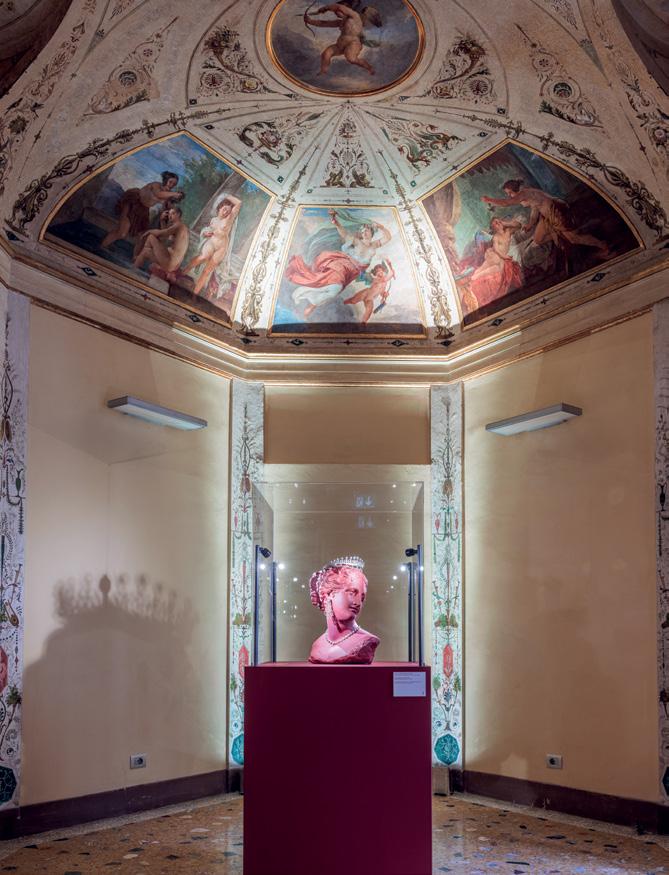
and cultural significance. Divided into three chapters, the book chronicles the evolution of style,culture,and societythroughthelensofjewellery–fromthecultural revolution of the Enlightenment to the elegance of the nineteenth century and the speed of the twentieth century. With insightful commentary and stunning visuals,“The Pennisi Collection”transports readers on a journey through time,inviting them to explore the rich tapestryofhistoryandcreativitythatdefinesthePennisi legacy. It is a literary treasure trove that celebrates the beauty, artisanry, and cultural significance of antique jewellery,ensuring that the legacy of Pennisi continues toshinebrightlyforgenerationstocome.
“I am fascinated by how these objects can encapsulate, and somehow transmit, not only the history and taste of an era but also that of those who wore them”. – Miuccia Prada, preface to the book“The Pennisi Collection”
In 2023,to commemorate their fifty years of excellence, Pennisi collaborated with renowned designer and creative director Paula Cademartori to host a special event at Palazzo Serbelloni.Situated on Corso Venezia, this neoclassical masterpiece provided the perfect backdrop for an immersive journey into the world of
Pennisi. The event, titled “Pennisi: 50 Years of Jewels and Virtuous Objects,” showcased some of the most exquisite pieces from the Pennisi collection, including rare and one-of-a-kind items that had never before been publicly displayed. From ornate Renaissance pendants tointricatelycarvedVictorianlockets,eachpieceoffered aglimpseintoabygoneera,awindowintothepast. As visitors wandered through the halls of Palazzo Serbelloni, they were transported on a journey through time, guided by the rich burgundy hues of Pennisi showcases and the elegant displays crafted by Cademartori herself. It was a celebration of craftsmanship, creativity, and above all, a testament to theenduringlegacyofPennisi–alegacythatcontinues toinspireandenchantaudiencesworldwide. Inaworldthatoftenvaluesthenewovertheold,Pennisi stands as a beacon of tradition and timeless elegance. Fromitshumblebeginningstoitsillustriouspresent,the journeyofPennisiisatestamenttotheenduringpower of beauty, workmanship, and the human spirit. As we celebrate with Pennisi fifty years of jewels and virtuous objects,weareremindedthatsometreasuresaremeant tolastalifetime–andbeyond.
Con questa consapevolezza, nel 1998 Marta Caffarelli e Viola Naj Oleari, due amiche all’epoca poco più che ventenni, hanno lanciato a Milano il loro brand Atelier VM con l’obiettivo di “non aggiungere nulla di superfluo al mondo”. Coerentemente, i loro gioielli si caratterizzano fin dagli esordi per la leggerezza e l’elegante semplicità delle linee e la capacità di rendere tangibile e custodire appunto l’essenziale, la meraviglia della natura, le piccole e grandi gioie della vita, gli affetti e i ricordi. Dopo pochi anni di sperimentazione vede la luce la collezione Impronta, basata sull’idea di personalizzare i propri gioielli con le impronte digitali delle persone care: anelli chevalier, charms e, oggi, le nuove fedi sono venduti in un pratico kit con tutto il necessario per acquisire l’impronta voluta in un calco e farla poi trasferire nel più prezioso dei gioielli dagli artigiani orafi di Atelier VM. Nel 2014 riscuote grande successo l’iconica collezione L’Essenziale: il bracciale in oro saldato direttamente sul polso - e seguendo i successivi sviluppi anche intorno al collo o alle caviglie - diventa tangibile segno di un amore o un ricordo destinato a durare nel tempo, di una promessa perfetta - della stessa perfezione del cerchio, che non ha inizio né fine - un modo per sentirsi connessi a qualcuno o “semplicemente” a sé stessi. Anche in questo caso, si acquista un gioiello partecipando direttamente alla sua realizzazione, perché si sceglie lo spessore e il colore della catenella, nonché gli eventuali charm da inserire. Ultimo nato all’interno di questa collezione è L’Essenziale Tenace, il bracciale in oro 18 carati con anima in titanio che garantisce massima resistenza e flessibilità, chiuso sul polso da un anellino saldato a laser in modo invisibile. Si ispira invece ad Afrodite, dea greca della bellezza e della generazione, l’omonima, recentissima collezione, che rievoca nella delicatezza delle linee e nei materiali utilizzati tutto l’universo femminile incarnato dalla dea: la passione del rubino, la purezza della perla, l’immortalità dell’oro. Curate in ogni dettaglio, realizzate a mano in oro 9 e 18 carati e arricchite da pietre naturali, le creazioni di Atelier VM hanno cominciato un viaggio che da Milano le ha portate presso Liberty a Londra, Le Bon Marché a Parigi, Nordstrom a New York, senza contare i corner La Rinascente di Milano, Torino e Roma e un avviatissimo e-commerce. Tra i volti noti che si sono fatti conquistare da questi “gioielli dell’anima”, Alessia Marcuzzi e Angelina Mango, la quale li ha indossati anche in occasione dell’ultimo festival di Sanremo che l’ha vista vincitrice.
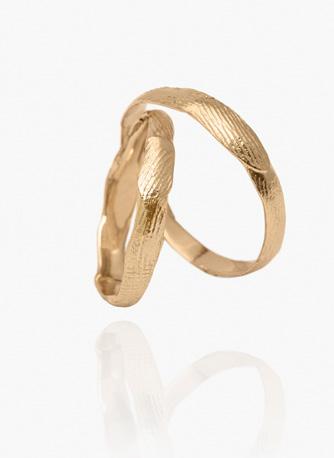
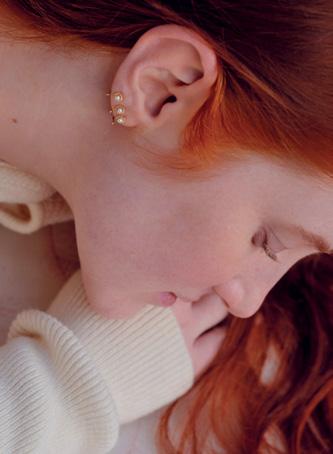


Distracted by enormous volumes of information and stimuli,constantly encouraged to own,too often we struggle to return to the basics,to the complexity of life and the depth of sentiment
With this in mind, in 1998 Marta Caffarelli and Viola Naj Oleari, two friends in their early twenties, launched the Atelier VM brand in Milan with the goal of“adding nothing superfluous to the world”. Consistent with this ethos, since the outset their jewelry has stood out for its lightness,for the elegant simplicity of its lines and for its ability to safeguard and embody the essential things, the wonder of nature, the little and the great joys of life, feelings and memories.After a few years of experimentation, Impronta was launched, a collection based on the idea of personalizing jewelry with the fingerprints of loved ones: signet rings,charms and now wedding rings are sold in a practical kit with everything required to make a mold of the desired print and then have it transferred to the most precious items of jewelry by the Atelier VM goldsmiths.In 2014,the iconic L’Essenziale collection was launched to great acclaim: the gold bracelet welded directly around the wrist - and following subsequent developments also around the neck or ankles - became a tangible token of love or a lasting memory, of a perfect promise, as flawless as a circle, with no beginning and no end, a way of feeling connected with someone - or“simply” with oneself. Once again, the customer participates directly in the creation of the item of jewelry by choosing the thickness and color of the chain, as
well as any charms to be added. The latest addition to this collection is L’Essenziale Tenace, an 18-carat gold bracelet with titanium core that guarantees maximum resistance and flexibility, closed around the wrist by an invisible laser-welded ring. With its delicate lines and choice of materials, the recent Afrodite collection, inspired by the Greek goddess of beauty and procreation, evokes the entire feminine universe embodied by the goddess: the passion of ruby, the purity of pearl, the immortality of gold. Handcrafted in 9- and 18-carat gold and embellished withnaturalstones,AtelierVM’screations,notablefor their great attention to detail, have begun a journey that from Milan has taken them in Liberty in London, Le Bon Marché in Paris and Nordstrom in New York, La Rinascente corners in Milan,Turin and Rome,and a very successful e-commerce operation.High-profile personalities to have been spotted wearing these “jewelsofsoul”includeAlessiaMarcuzziandAngelina Mango, who also wore them on her triumphant appearance at the last Sanremo music festival.


Nello splendido contesto delle Gallerie d’Italia, in Piazza della Scala a Milano, Damiani, con la mostra “Damiani 100 x 100 italiani” ha celebrato i 100 anni della propria storia, da sempre saldamente legata al distretto valenzano, dove nel 1924 il fondatore Enrico ha dato inizio all’attività. Nel corso di questi cento anni le redini dell’azienda sono passate prima al figlio Damiano, che ha innovato lo stile del brand aprendolo ai mercati internazionali, e poi alla terza generazione della famiglia, oggi rappresentata da Guido, Silvia e Giorgio. Con passione e creatività i tre fratelli hanno portato il brand Damiani a imporsi a livello mondiale come icona della gioielleria Made in Italy: estetica raffinata, esecuzione accuratissima, cromatismi ricercati e l’alta qualità delle pietre utilizzate sono i tratti distintivi delle creazioni della maison, che le ha rese nel tempo uniche e riconoscibili. Sola azienda al mondo ad avere conquistato ben 18 Diamonds International Awards, equivalenti agli Oscar mondiali della gioielleria con diamanti, Damiani tra gli anni Ottanta e Novanta ha anche fatto la storia della comunicazione orafa, introducendo, tra le prime aziende al mondo, l’uso dei testimonial - del calibro di Brad Pitt, Isabella Rossellini o Gwyneth Paltrow, conquistando diversi premi e riconoscimenti.
La mostra di Milano, curata da Alba Cappellieri, ha reso omaggio ai 100 anni di Damiani con 100 gioielli, testimoni della maestria dei suoi artigiani.
Un tripudio di diamanti, zaffiri, smeraldi e rubini ha dato vita a veri e propri capolavori di haute joaillerie, selezionati da quattro celebri collezioni: Mimosa, Margherita, Belle Époque e Fantasy Cut.
Nelle immagini di queste pagine, il collier Eternal Blue della collezione Mimosa, con uno zaffiro dello Sri Lanka taglio a cuscino di oltre cento carati: può essere indossato anche come ciondolo pendente da una catena in oro bianco e diamanti o come spilla.
Collier e catena possono a loro volta essere indossati singolarmente.
Damiani,an interpreter all over the world of the best Made in Italy, celebrated the 100th anniversary of its history
In the splendid setting of the Gallerie d’Italia in the Milanese Piazza della Scala, Damiani, through the “Damiani 100 x 100 Italians” exhibition, celebrated 100 years of its history,which has always been firmly linked to the Valenza district, where founder Enrico started the business in 1924.Over the course of these 100 years,the reins of the company were passed first to his son Damiano, who innovated the brand’s style byopeningituptointernationalmarkets,andthento thethirdgenerationofthefamily,nowrepresentedby Guido,Silvia and Giorgio.With passion and creativity, the three siblings have brought the Damiani brand to worldwide prominence as an icon of Made in Italy jewelry: refined aesthetics, meticulous execution, sophisticated chromatisms and the high quality of the stones used are the hallmarks of the creations of the maison, which has made them unique and recognizable over time. It is the only company in the world to have won as many as 18 Diamonds International Awards, the Oscars of diamond jewelry, Damiani also made history in jewelry communication between the 1980s and 1990s, as one of the first companies in the world to introduce the use of testimonials with the likes of Brad Pitt, Isabella Rossellini or Gwyneth Paltrow, and winning


severalawardsandaccolades.TheexhibitioninMilan, curated by Alba Cappellieri,paid tribute to Damiani’s 100th anniversary with 100 pieces of jewelry that bear witness to the mastery of its artisans.
A riot of diamonds, sapphires, emeralds and rubies giving life to true masterpieces of haute joaillerie, selected from four celebrated collections: Mimosa, Margherita, Belle Époque and Fantasy Cut. Pictured on these pages is the Eternal Blue necklace from the Mimosa collection, featuring a cushion-cut sapphire from Sri Lanka of over one hundred carats: it can also be worn as a pendant hanging from a white gold and diamond chain or as a brooch. The collier and chain can in turn be worn on their own.
In 555 anni, nessun museo o istituzione al mondo era mai riuscito nell’impresa portata oggi a termine dal Museo Poldi Pezzoli di Milano: riunire in un unico sito gli otto pannelli rimasti del meraviglioso polittico dipinto da Piero della Francesca per la chiesa degli agostiniani a Borgo San Sepolcro. L’opera, terminata nel 1469, è stata smembrata ed è finita in parte dispersa nel corso del tempo. Degli otto pannelli superstiti, uno era già proprietà del Museo milanese, gli altri erano custoditi in diversi musei tra Europa e Stati Uniti e riunirli è stata davvero un’impresa epica, fortemente voluta in primis dalla direttrice del Poldi Pezzoli, Alessandra Quarto. Tra i meriti di questa mostra straordinaria, curata da Machtelt Brüggen Israëls e Nathaniel Silver - curatori anche del bellissimo catalogo, per i tipi di Dario Cimorelli Editore - quello di saper parlare con immediatezza anche al pubblico dei non addetti ai lavori, in virtù di un’illuminazione (Artemide) e un allestimento (a cura dell’architetto Italo Rota e dello studio CRA-Carlo Ratti Associati) studiati per evidenziare con immediatezza, in tutta la sua maestria, l’arte di Piero della Francesca e ricreare l’ambiente originario e l’impressione che la pala doveva suscitare. Un video illustra anche i “segreti” svelati dalle analisi diagnostiche, condotte sull’opera grazie alla Fondazione Bracco, main partner del progetto (mentre Intesa Sanpaolo è partner istituzionale con Gallerie d’Italia). È stato inoltre studiato un percorso ad hoc attraverso le collezioni di arti decorative del Poldi Pezzoli che sono richiamate dai particolari dei pannelli di Piero (gioielli, tessuti, manufatti). Un’operazione davvero curata in ogni dettaglio che ha già riscosso grandissimo successo. La mostra resta aperta fino al 24 Giugno.
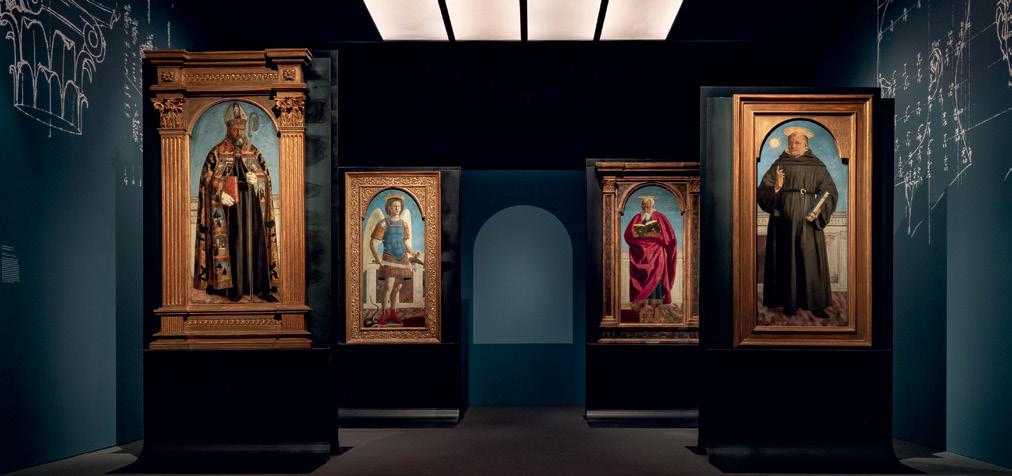

The Augustinian polyptych reunited is one of the major cultural events of the year
In 555 years, no museum or institution in the world had ever succeeded in the feat that has now been accomplished by the Poldi Pezzoli Museum in Milan: to bring together the eight remaining panels of the marvelous polyptych painted by Piero della Francesca for the church of the Augustinians in Borgo San Sepolcrointooneplace.Thework,whichwascompleted in 1469, was dismembered and ended up partially dispersed over time.Of the eight surviving panels,one already belonged to the Milanese museum, the others were kept in various museums between Europe and the United States, and bringing them together was truly an epic undertaking, and something that Poldi Pezzoli director Alessandra Quarto strongly wanted in the first place.Among the merits of this extraordinary exhibition, curated by Machtelt Brüggen Israëls and Nathaniel Silver, also editors of the beautiful catalog, for the types of Dario Cimorelli Editore,is that of being able to speak with immediacy also to the non-expert
audience, by virtue of lighting (Artemide) and staging (by architect Italo Rota and studio CRA-Carlo Ratti Associati) designed to highlight with immediacy and in all its mastery the art of Piero della Francesca and recreate the original environment and the impression that the altarpiece was intended to make. A video also illustrates the “secrets” revealed by the diagnostic analyses, conducted on the work thanks to the Bracco Foundation, the project’s main partner (while Intesa Sanpaolo is the institutional partner with Gallerie d’Italia).An ad hoc itinerary through the Poldi Pezzoli’s decorativeartscollectionsthatarerecalledbythedetails ofPiero’spanels(jewelry,textiles,artifacts)hasalsobeen designed.Thisisareallywell-finishedoperationinevery detailthathasalreadybeenmetwithgreatsuccess.The exhibitionwillbeopenuntilJune24.

Il bel volume che Italian Exhibition Group ha curato per celebrare i settanta anni di VicenzaOro, la più longeva fiera orafa b2b del mondo, non si limita a ripercorrere, decennio dopo decennio, la storia della manifestazione, ma contestualizza nell’arco del tempo i suoi legami col territorio, i momenti di svolta, gli investimenti, la capacità di rispondere alle sempre nuove esigenze del mondo imprenditoriale e della società: di fatto indagando e rendendo manifeste le ragioni stesse del suo successo. La presenza della Corporazione degli Orefici è attestata in città a partire dagli statuti comunali del Trecento e aumenta di numeri e importanza nel corso dei secoli. A inizio Novecento oreficeria e argenteria sono uno dei cardini dell’economia locale, stimolate anche dall’avvento delle prime macchine automatiche. Nel 1946 vede la luce la prima Fiera Campionaria Nazionale di Vicenza, una manifestazione generalista sorta per rispondere ai bisogni dell’economia locale subito dopo il secondo conflitto mondiale, ma nel giro di pochi anni - visto il deciso aumento tra gli espositori di orafi e argentieri - questa formula viene abbandonata a favore delle esposizioni specializzate e si giunge così, nel 1954, alla prima Mostra Nazionale dell’Oreficeria ed Argenteria. Le pagine del libro accompagnano il lettore nel lungo, affascinante viaggio che ha portato alla VicenzaOro dei giorni nostri: la prima sede di Giardino Salvi, l’avveniristica “piramide azteca” inaugurata nel 1971 a Vicenza Ovest, i successivi ampliamenti


e riassetti dei padiglioni, il passaggio da una dimensione nazionale a una crescente internazionalizzazione, le sinergie con altri settori produttivi, per arrivare alla fusione con Rimini e alla nascita di IEG. Decennio dopo decennio, accanto alle vicende della fiera e del comparto il volume ripercorre anche gli avvenimenti che hanno segnato la società e la politica del Paese, soffermandosi sui trend del momento e sui tantissimi volti noti del mondo dello spettacolo, dello sport e della politica che nel corso di questi “settanta anni d’oro” hanno fatto la propria comparsa in fiera, in veste di visitatori o di testimonial.
The beautiful volume edited by Italian Exhibition Group in celebration of the 70 years of VicenzaOro,the longest-runningb2bgoldsmith’stradefairintheworld, not only retraces, decade after decade, the history of the event, it also puts into context its connections to the region, the turning points, the investments, and its ability to meet the ever-changing needs of the business world and society over that period of time, indeed,the book explores and demonstrates the very reasons behind the fair’s success. The existence of the Goldsmiths’Guild in the city is evidenced by the 14th century municipal statutes, and it has increased in number and gained importance over the centuries. At the beginning of the 20th century, gold- and silversmithing were one of the cornerstones of the local economy,boosted also by the advent of the first automated equipment.The first National Trade Fair of Vicenza was held in 1946,an event of general interest originally created to serve the needs of the local economy just after the Second World War; however, due to the significant increase in gold- and silversmith exhibitors, this format was abandoned within a few years in favor of more specialized exhibitions, leading to the first National Exhibition of Gold and Silverware in 1954. The book guides the reader on the long and fascinating journey that led to today’s VicenzaOro, starting from the first venue at Giardino Salvi, the futuristic “Aztec pyramid” inaugurated in 1971 in Vicenza Ovest,the subsequent expansions and restructuring of the pavilions, the transition from a domesticeventtooneonanincreasinglyinternational scale,the synergies with other industries,and ending with the merger with Rimini and the establishment of IEG. Besides the events of the fair and the sector that havetakenplaceoverthedecades,thebookalsocovers events that have shaped the society and politics of the country, focusing on current trends and the many well-known figures from the world of entertainment, sport and politics who have made their appearance at the fair either as visitors or ambassadors during these “seventy golden years”.
Diana Ross, Photo by Ralph Johnson, Getty Images Twiggy photographed by Bert Stern, 1967

Dolce&Gabbana - Dal cuore alle mani
“Dal Cuore alle Mani”, la prima mostra delle creazioni Dolce&Gabbana, che racconta la storia del sodalizio dei due stilisti, è certamente un appuntamento da non mancare. Curato da Florence Müller e promosso da Comune di Milano – Cultura, il progetto è un tributo al valore del Fatto a Mano, vera essenza del marchio. Una narrazione che, attraverso il sogno dell’Alta Moda, esplora le fonti di ispirazione dei due designer, attraverso un percorso espositivo che mette in risalto una moltitudine di riferimenti culturali: artigianato, arti visive, architettura, ma anche l’Italia, le sue tradizioni, l’innovazione, il teatro, la musica, l’Opera, il Balletto, La dolce vita. A Palazzo Reale a Milano, dal 7 aprile al 31 luglio.
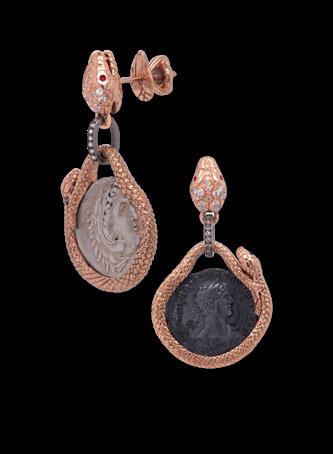
Alessio Boschi
Come sempre le creazioni di Alessio Boschi intrecciano passato, presente, simbolismi senza tempo e tanta, tantissima tecnica. La collezione Aspis comprende collane, bracciali, pendenti, anelli e orecchini variamente componibili e reversibili, con sinuosi serpenti in oro impreziositi da pietre preziose che incorniciano antiche monete provenienti dai territori dell’Asia Minore, della Grecia, degli imperi di Roma e Persia. Le catene sono disponibili in tre varianti, con maglie in argento ossidato e diamanti light brown o zaffiri blu, oppure lavorate con la tecnica dell’antica Grecia “nodo nel nodo”, con motivo a spiga e la particolare finitura nera “Black Gun” su acciaio spazzolato manualmente ad arte.
Alessio Boschi’s creations, as always, intertwine past, present, timeless symbolism and a great deal of technique. The Aspis collection includes variously combinable and reversible necklaces,bracelets,pendants,ringsandearrings,withsinuous gold snakes embellished with precious stones that frame ancient coins from the territories of Asia Minor, Greece, the Roman and Persian empires.The chains are available in three versions,with oxidized silver links and light brown diamonds or blue sapphires, or worked with the ancient Greek “knot in knot” technique, with a spiga (“herringbone”) pattern and the particular “Black Gun” black finish on impeccably handbrushed steel.
by Paola Greco“From the Heart to the Hands”, the first exhibition of Dolce&Gabbana creations, which recounts the history of the partnership between the two designers, is an event not to be missed. Curated by Florence Müller and promoted by the Municipality of Milan - Culture, the project is a homage to the value of the Fatto a Mano (Handmade), the true essence of the brand.A storytelling that,through the dream of Haute Couture, explores the sources of inspiration of the two designers,through an exhibition itinerary that emphasizes a multitude of cultural references: craftsmanship,visual arts,architecture,but also Italy, itstraditions,innovation,theater,music,theOpera,theBallet,and Ladolcevita.AtPalazzoRealeinMilan,tillJuly3.

L’iconica collezione Mini Sweety di Bigli si arricchisce di un nuovo bracciale, ispirato alle forme geometriche dalle curve morbide tipiche degli anni ’70, da sempre fonte di ispirazione di Laurence Aerens, direttore creativo del marchio. Pietre colorate dal taglio cabochon, messe in risalto da piccoli, preziosi diamanti, sono incastonate tra le maglie larghe del gioiello in oro rosa: turchese, topazio azzurro e madreperla sposano l’avventurina verde e il quarzo giallo. Bigli è un marchio belga, fondato nel 1997 da Thierry Spitaels e Laurence Aerens, che si distingue per la ricercatezza dei dettagli e dei materiali: ogni gioiello è realizzato in oro 18 carati, arricchito con diamanti e pietre preziose.
Bigli’s iconic Mini Sweety collection is enriched with a new bracelet,inspired by the geometric shapes with gentle curves typical of the 1970s, which have always been a source of inspiration for Laurence Aerens,the brand’s creative director. Colorfulcabochon-cutgemstones,enhancedbysmall,precious diamonds, are set between the wide links of the rose gold jewel: turquoise, blue topaz and mother-of-pearl paired with green aventurine and yellow quartz. Bigli is a Belgian brand, founded in 1997 by Thierry Spitaels and Laurence Aerens, that sets itself apart for its sophisticated details and materials: each piece of jewelry is made of 18-carat gold, enriched with diamonds and precious gemstones.

Farnese
Farnese Gioielli arricchisce la collezione Habibi di un inedito ciondolo con collana e innovativi orecchini pendenti a barretta e ovali, tutti caratterizzati dallo Spine, cifra stilistica del marchio romano: il sistema all’avanguardia, ideato dalla Creative Director e Founder Barbara Polli, che rende mobile e intercambiabile il pavè di pietre preziose, per una immediata fluidità e dinamicità dei gioielli. La collezione diventa poi ancora più esclusiva grazie alla nuova proposta di pregiati diamanti Yellow Fancy Vivid, che completano l’offerta di pietre preziose da accostare all’oro giallo o rosa, per gioielli davvero unici, intercambiabili e dalla raffinata lavorazione artigianale.
Farnese Gioielli enriches the Habibi collection with an unprecedented pendant necklace and innovative bar and oval pendant earrings, all featuring the Spine, the Roman brand’s signature style: the state-of-the-art system, devised by Creative Director and Founder Barbara Polli, which makes the pavé of precious gemstones mobile and interchangeable, for instant fluidity and vitality of the jewelry.The collection becomes even more exclusive thanks to the new offer of prized Yellow Fancy Vivid diamonds, which complete the range of gemstones to be pairedwithyelloworrosegold,fortrulyunique,interchangeable jewelryfeaturingthefinestcraftsmanship.
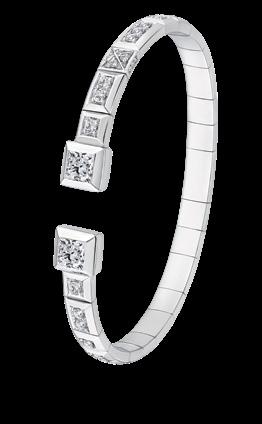
Gruppo indiano con oltre duemila dipendenti, KBS Creations vanta una presenza forte e consolidata nel mercato americano della gioielleria e sta espandendo le proprie attività in Europa e Australia. Fiore all’occhiello del gruppo è KBS Atelier, la divisione operativa specializzata in progetti speciali di altissima qualità, sviluppati anche in partnership. I gioielli di KBS Atelier si distinguono per artigianalità, ergonomia, design esclusivo e soluzioni tecniche e tecnologiche, come le anime in titanio che garantiscono la massima flessibilità e le giunzioni “origami” per pezzi sofisticati e moderni. Da un anno l’azienda collabora con Guido Persico, in qualità di designer e consulente sviluppo prodotto, e Bruno Vicini, maestro artigiano e consulente tecnico: le nuove linee presentate a VicenzaOro hanno riscosso grandi apprezzamenti.
Indian group with over two thousand employees, KBS Creations boasts a well-established presence in the American market and is expanding its activities in Europe and Australia. The group’s feather in the cap is KBS Atelier, the operating division specialized in high-quality special projects, also developed in partnership.KBS Atelier’s jewelry stands out for its craftsmanship, ergonomics, exclusive design and technical and technological solutions such as titanium springs that guarantee maximum flexibility,and“origami”linkage granting sophisticated and modern pieces.
For the past year, the company has been collaborating with Guido Persico, as a designer and product development consultant,and Bruno Vicini,master craftsman and technical consultant: the new lines presented at VicenzaOro have been met with great appreciation.

Breil presenta una nuova collezione di gioielli in acciaio, dalle linee leggere e flessuose. Il nome è evocativo: “Plissé”, come la carta plissettata di celebri opere d’arte e di design, o gli eleganti tessuti da sempre protagonisti del mondo della moda. La materia diventa eterea e sinuosa, creando giochi di luce e riflessi sulla superficie metallica. L’acciaio, sapientemente plissettato, è declinato nelle versioni lucido e lucido IP gold, e proposto in una linea completa di collane lunghe o corte e orecchini maxi e glamour. In particolare, il soutoir con pendente conquista la scena: un elemento che non passa inosservato ondeggia agganciato a una lunga collana regolabile con chiusura a moschettone.
Breil presents a new collection of steel jewelry featuring light and sinuous lines. The name is strikingly suggestive: “Plissé,” like the pleated paper of famous works of art and design, or the elegant fabrics that have always been the stars of the fashion world. Matter becomes ethereal and curvaceous, creating games of light and reflections on the metal surface.Steel, skillfully pleated,is declined in the polished and polished IP gold versions and offered in a complete line of long or short necklaces and maxi and glamorous earrings.In particular,the pendant sautoir takes center stage: an eye-catching element that does not go unnoticed sways hooked to a long adjustable necklace with a lobster clasp.
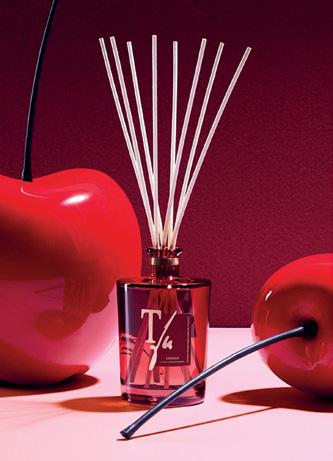
Teatro Fragranze Uniche Firenze trasforma emozioni in “spettacoli olfattivi”, declinando le sue fragranze, ispirate alla Toscana, in candele, profumazioni per tessuti, per ambienti e eau de parfum. L’ultima nata è Ceresia, un bouquet fruttato che nasce dall’intreccio della ciliegia con il bergamotto, il latte di mandorla e le foglie di fico: un viaggio olfattivo nell’atmosfera spensierata che accompagna l’arrivo dell’estate. La fragranza è racchiusa in un’elegante bottiglia, che conferisce al prodotto raffinatezza ed eleganza. Completano la linea le candele, il profumo per tessuti, tende, biancheria e divani, nonché il perfume, per avere la stessa armonia intrigante e audace anche sulla pelle.
TeatroFragranzeUnicheFirenzeturnsemotionsinto“olfactory performances”,interpreting its fragrances,inspired by Tuscany, intocandles,fabricfragrances,roomscentsandeaudeparfum. The latest addition is Ceresia,a fruity bouquet resulting from the blending of cherry with bergamot, almond milk and fig leaves: an olfactory journey into the carefree atmosphere that precedes the arrival of summer.The fragrance is contained in an elegant bottle, lending the product sophistication and elegance.The line is completed by candles,fragrances for fabrics, curtains, linens and sofas, as well as perfume, to achieve the same intriguing and bold harmony on the skin as well.

Con Fazzini Atelier la biancheria più raffinata torna protagonista della camera da letto: attraverso la piacevolezza tattile del percalle dall’effetto pelle d’angelo, o la raffinatezza dei rasi di cotone, la purezza del lino o il ricercato connubio fra lino e seta, tra lavorazioni che rivelano tutta l’eccellenza manifatturiera italiana di dettagli e ricami che delineano le diverse proposte. I colori sono quelli neutri delle gradazioni di bianco, avorio e corda a cui si affiancano le scale dei grigi, il celadon e il blu, per un’eleganza appena sussurrata. Ancora una volta le nuove proposte, tutte personalizzabili anche nelle dimensioni, prendono nome e ispirazione da luoghi e architetture milanesi.
With Fazzini Atelier,the most refined linens return to take center stage in the bedroom: through the tactile delightfulness of percale with angel skin effect, or the sophistication of cotton satins, the purity of linen or the exquisite marriage of linen and silk,amidst workmanship that reveals all the Italian manufacturing excellence of details and embroideries that characterize the different offers. The colors are neutral shades of white,ivory and rope complemented by scales of gray,celadon and blue,for a barely whispered elegance.Once again,the new designs,all customizable in size as well,take their names and inspiration from Milan’s landmarks and architecture.
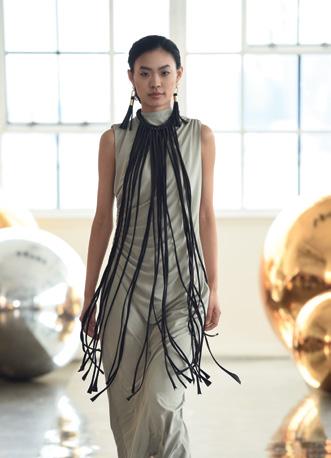
Centopercentocachemire introduce il concetto di “haute couture jewelry” gettando un ponte tra l’arte della sartorialità italiana e quella orafa. Nato dall’estro di Annabella Santese, il marchio porta in dote tutta l’eredità dei lunghi anni di esperienza nel mondo dell’abbigliamento della sua fondatrice. Le proposte non convenzionali di Centopercentocachemire fondono un’estetica contemporanea alla costante ricerca dei materiali, prendendo ispirazione dalle trame di preziosi filati: mischiando cachemire, lino, seta, a rafia, pelle, cuoio, per poi approdare su pietre dure, perle, cristalli, metalli… donando sorprendenti esperienze tattili e suggerendo sempre nuove possibilità espressive a chi li indossa.
Centopercentocachemire introduces the concept of “haute couture jewelry” by building a bridge between the art of Italian dressmaking and that of the goldsmith.Born out of the creativityofAnnabellaSantese,thebrandcarriesallthelegacy ofitsfounder’slongyearsofexperienceintheworldofclothing.
The unconventional designs of Centopercentocachemire combine a contemporary look with the constant search for materials, taking inspiration from the weaves of precious yarns: mixing cashmere, linen, silk with raffia, leather, hide, and then landing on hard stones, pearls, crystals, metals... providing surprising tactile experiences and always suggesting new opportunities for expression to those wearing them.
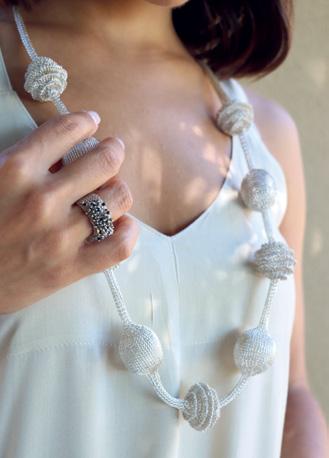 Nanà
Nanà
Aristova Jewels
I gioielli di Nanà Aristova, realizzati a mano in Italia, rappresentano la perfetta fusione tra design contemporaneo e sapienza artigianale: un’artigianalità che profuma delle antiche tradizioni balinesi, con cui la designer è entrata in contatto durante i suoi viaggi. Sono gioielli potenti e unici, frutto della profonda connessione fra le donne che li realizzano con dedizione e passione. La cultura balinese traspare in ogni gioiello, insegnando e trasmettendo la gentilezza e l’energia positiva, tipiche delle sue tradizioni, fondate su valori profondi e tecniche specifiche. Iconica la linea Phylum, realizzata con fili d’ottone o argento intessuti con la tecnica dell’uncinetto, che li rende naturalmente elastici.
Nanà Aristova’s jewelry, handcrafted in Italy, represents the perfect fusion between contemporary design and skilled craftsmanship - craftsmanship that emanates from the ancient Balinese traditions with which the designer came into contact during her journeys. They are powerful and unique jewels,the result of the deep connection between the women who make them with dedication and passion.Balinese culture transpires in each piece of jewelry,teaching and conveying the kindness and positive energy typical of its traditions, based on deep values and specific techniques. The iconic Phylum line is made with brass or silver threads woven with the crochet technique,which makes them naturally elastic.

Ottaviani, storica azienda nel mercato degli argenti e del gioiello fantasia, presenta la sua collezione di bijoux Boutique: una linea che raccoglie tutta la tradizione del Made in Italy, giocando con le forme, i colori e le nuove tendenze. Protagonisti sono i cristalli Preciosa e Swarovski, proposti nelle tonalità fresche e allegre tipiche della bella stagione: dall’azzurro, al rosa, passando per le nuance più eleganti dello champagne e giocando tra gradazioni tenui ed accese. Sulle componenti metalliche, inoltre, è applicato un trattamento di cataforesi, che consente alla doratura di non essere intaccata nel tempo, e conservare tutta la sua originaria bellezza. Una linea di gioielli ultrachic e fashion che non passano inosservati.
Ottaviani, a renowned company in the silver and fashion jewelry market,presents its Boutique bijoux collection: a line that brings together the entire Made in Italy tradition,playing with shapes, colors and new trends. The stars are Preciosa and Swarovski crystals, presented in the fresh and cheerful shades typical of the summer season: from light blue,to pink, through the more elegant shades of champagne and playing betweendelicateandbrighthues.Acataphoresistreatmentis also applied to the metal components,allowing the gilding to remain unaffected over time and retain all its original beauty. A line of ultrachic and fashion jewelry that is guaranteed not to go unnoticed.
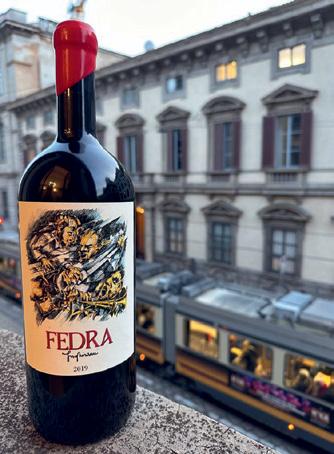 By Tommaso Inghirami
By Tommaso Inghirami
Un progetto che nasce tra i vigneti di Grignano, storica tenuta nel cuore del Chianti Rufina, un tempo di proprietà della casata dei Medici e oggi della famiglia Inghirami, uno dei nomi più noti del tessile-moda italiano. Il giovane Tommaso Inghirami nel 2016 decide di creare un vino da dedicare a un illustre avo, a 400 anni dalla sua morte: Tommaso Inghirami, detto “Fedra”, fu un dotto umanista, amico di Raffaello Sanzio, che a lui dedicò un celebre ritratto, oggi agli Uffizi. Dopo tre anni vede la prima annata Fedra, un rosso da collezione: in un connubio tra vino e arte, ogni cassa conterrà la serigrafia firmata e numerata, rappresentata nell’etichetta d’autore, quest’anno ad opera di Franco Alessandrini, originario della zona di Sansepolcro come la famiglia Inghirami, artista di fama internazionale dalle tante anime.
A project that originated among the vineyards of Grignano,a historical estate in the heart of Chianti Rufina,once owned by the Medici family and now by the Inghirami family,one of the best-known names in the world of Italian textile fashion. In 2016, young Tommaso Inghirami decided to create a wine to dedicate to an illustrious ancestor,400 years after his death: Tommaso Inghirami, known as “Phaedra,” was a learned humanist and friend of Raffaello Sanzio,who dedicated a famous portrait to him, which is now on display in the Uffizi. After three years the first Fedra vintage,a collector’s red.In a union of wine and art, each case will contain the signed and numbered serigraphy,represented in the artistic label,this year by Franco Alessandrini,a native of the Sansepolcro area like the Inghirami family and an internationally acclaimed artist with many souls.

Filo Doppio
Il volume, edito da SAGEP Editori, racconta dei dialoghi di Filo Doppio, ultima declinazione del progetto Fragile Bellezza, iniziato nel 2019. Il filo doppio è quello che lega sette artisti con altrettanti maestri orafi nel binomio arte e mestiere, che da sempre contraddistingue la produzione orafa valenzana. Il progetto, curato da Lia Lenti e Domenico Maria Papa, vede dialogare pensiero artistico e saper fare artigianale, in un lavoro di tessitura con il comune intento di dare risposta al desiderio di generare bellezza: i frutti di queste collaborazioni sono le 7 opere-gioiello, che sono state esposte in toto a Valenza e poi in parte ad Alessandria, insieme ad altre selezionate dalle passate edizioni.
This volume,published by SAGEP Editori,tells of the dialogues of Filo Doppio (“Double Thread”), the latest offshoot of the Fragile Beauty project, launched in 2019. The double thread is the one that joins seven artists with as many goldsmith masters in the combination of art and craft,which has always distinguished Valenza- goldsmith production. The project, curated by Lia Lenti and Domenico Maria Papa, features a dialogue between artistic thought and craftsmanship, in a weavingworkwiththecommonaimofprovidingananswerto the desire to generate beauty: the fruits of these collaborations are the 7 jewel-works, which have been displayed in toto in Valenza and then in part in Alessandria, along with others selected from past editions.

La collezione di orologi Jumbostar si arricchisce di un’inedita linea di 3 referenze per celebrare la collaborazione tra due eccellenze italiane – Wyler Vetta e Colmar – che in ambiti diversi condividono storicità e spirito d’innovazione. Fulvio Locci, designer di Wyler Vetta, per l’occasione ha dato vita a un modello sportivo in cui convivono i codici dei due marchi: partendo dallo storico Jumbostar, il nuovo solo tempo automatico dall’importante cassa in acciaio ospita un quadrante essenziale e monta un cinturino in tessuto tecnico Colmar con cuciture “effetto piumino”. Decora il fondello un’incisione al laser della sagoma del campione di sci Zeno Colò, per cui Colmar creò la “guaina Colò”.
The Jumbostar watch collection has been expanded with an all-new line of 3 models to celebrate the partnership between two Italian excellences - Wyler Vetta and Colmar - which, although in different fields,share a sense of history and spirit of innovation.For this occasion,Fulvio Locci,designer of Wyler Vetta,has created a sporty model that combines the codes of the two brands: starting with the historic Jumbostar,the new automatic Only Time watch with the large steel case houses an essential dial and is fitted with a Colmar technical fabric strap with“quilted effect”stitching.A laser-engraved silhouette ofskichampionZenoColò,forwhomColmarcreatedthe“Colò sheath”,decorates the case back.

Torna l’appuntamento di settembre con Milano Fashion&Jewels, la manifestazione che racconta trend e tendenze del mondo del gioiello e dell’accessorio moda. Un hub unico in Italia in cui boutique, negozi di accessori moda, produttori e gioiellerie hanno l’opportunità di incontrare oltre 600 brand, partecipare a un ricco palinsesto di talk formativi e scoprire le tendenze del momento. Le nuove date per l’edizione di settembre sono fissate da sabato 14 (giornata su invito) a martedì 17 settembre 2024, sempre a Fieramilano (Rho). L’evento sarà in concomitanza con MICAM Milano e MIPEL, saloni internazionali rispettivamente della Calzatura e della Pelletteria, più in parte con Lineapelle, che si terrà dal 17 al 19 settembre.
September once again marks the return of Milano Fashion&Jewels,the event that showcases trends and tendencies in the world of jewelry and fashion accessories.A unique hub in Italy where boutiques,fashion accessory stores,manufacturers and jewelry stores can meet over 600 brands,take part in a rich schedule of training talks and discover the latest trends. The new dates for the September edition are set from Saturday,September 14 (invitation-only day) to Tuesday,September 17, 2024, again at Fieramilano (Rho). The event will be held in conjunction with MICAM Milan and MIPEL, international trade shows for Footwear and Leather Goods respectively,plus in part with Lineapelle,which is scheduled to take place September 17-19.

Matteo Farsura (foto) è il nuovo Global Exhibition Manager della divisione Jewellery & Fashion di IEG, azienda leader nella gestione e organizzazione di eventi fieristici. Farsura, già Exhibition Manager di Vicenzaoro, gestirà le manifestazioni della Jewellery Agenda di IEG: in Italia Vicenzaoro, Oroarezzo, T.Gold, Summit del Gioiello, Valenza Gem Forum, VO’Clock Privé, VO Vintage; a Dubai e Singapore rispettivamente JGTD e SIJE. Avrà inoltre la responsabilità di FIMAST, anch’essa facente capo alla divisione J&F di IEG. In concomitanza, Marco Carniello passa al ruolo di Chief Business Officer alla guida della nuova Direzione Business che coordinerà tutte le industries presiedute da IEG.
Matteo Farsura (photo) is the new Global Exhibition Manager of theJewellery&FashionDivisionofIEG,aleadingcompanyinthe management and organization of trade shows.Farsura,formerly ExhibitionManagerofVicenzaoro,willbeinchargeoftheevents on IEG’s Jewellery Agenda: in Italy Vicenzaoro,Oroarezzo,T.Gold, JewelrySummit,ValenzaGemForum,VO’ClockPrivé,VOVintage; in Dubai and Singapore JGTD and SIJE respectively.He will also beresponsibleforFIMAST,whichisalsopartofIEG’sJ&Fdivision. Atthesametime,MarcoCarniellowillbetakingovertheposition of Chief Business Officer at the helm of the new Business Management,whichwillcoordinatealltheindustrieschairedbyIEG.
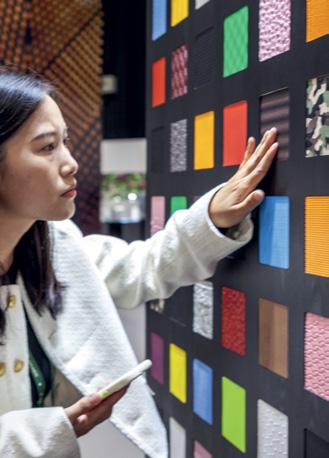
Dal 21 al 23 maggio 2024, presso l’Allianz MiCo, si terrà la nuova edizione di Packaging Première & PCD Milan, un viaggio alla scoperta dei progetti più interessanti del settore, per esperti e brand alla ricerca delle ultime innovazioni e tendenze. Un parterre espositivo di oltre 300 aziende arricchito da una serie di progetti collaterali che includono un ampio range di argomenti e di interessi. Dom Pérignon, Bally, Pantone, Garnier, Kiko sono solo alcuni dei brand che parteciperanno al ciclo di conferenze su temi di grande attualità: dalla cosmesi coreana al sensorial marketing, dall’IA alla stampa 3D. Il progetto Avant-Garde, inoltre, premierà i materiali più meritevoli in termini di innovazione e sostenibilità.
From May 21-23, 2024, the new edition of Packaging Première & PCD Milan will be held at Allianz MiCo, a journey into the discovery of the packaging industry’s most interesting projects for experts and brands looking for the newest innovations and trends.An exhibition line-up of more than 300 companies enriched by several side projects that include a wide range of topics and interests.Dom Pérignon,Bally,Pantone,Garnier and Kiko are just a few of the brands that will take part in the cycle of talks on topical issues: from Korean cosmetics to sensorial marketing, from AI to 3D printing. Moreover, the Avant-Garde project will award the most noteworthy materials in terms of innovation and sustainability.


